Egypt - The Third Dynasty - (2686 - 2575 BC)
The Old Kingdom - The Age of the Pyramids
The Pharaohs of the Third Dynasty were the first to have actual pyramids constructed as shrines to their deaths. Although crude, these step pyramids were the predecessors to the later Pyramids of Giza and others. The first of these pyramids was designed by Imhotep for Dzoser. Prior to, and during the construction of the step pyramids, rulers were buried in a structure called a Mastaba.
- A mastaba was a flatroofed, mudbrick, rectangular building with sloping sides that marked the burial site of many eminent Egyptians of the Egypt's ancient period.
Mastaba comes from the Arabic for bench, because they look like a mud bench when seen from a distance. In a mastaba, a deep chamber was dug out and lined with stone, mud bricks or wood. Above ground, the mud was piled up to mark the grave, oblong in a shape with a length approximately 4 times its width. Although this provided a much grander tomb, it was also a much cooler tomb. This upset the early priests as it allowed the bodies to decompose due to the fact that water no longer evaporated, preventing desiccation of the bodies.
The Mastaba were the standard tomb type in early Egypt (the predynastic and early dynastic periods.
While Manetho names one Necherophes, and the Turin King List names Nebka, as the first pharaoh of the Third Dynasty of Egypt, some contemporary Egyptologists believe Djoser was the first king of this dynasty, pointing out that the order in which some predecessors of Khufu are mentioned in the Papyrus Westcar suggests that Nebka should be placed between Djoser and Huni, and not before Djoser. That the Turin King List has noted Djoser's name in red may also be significant.
In any case, Djoser is the best known king of this dynasty, for commissioning his vizier Imhotep to build the earliest surviving pyramids, the Step Pyramid. Some authorities believe that Imhotep lived into the reign of the Pharaoh Huni.
Little is known for certain of Sekhemkhet. However, it is believed that Khaba possibly built the Layer Pyramid at Zawyet el'Aryan. Huni, the last king of this dynasty, like Djoser had a renowned vizier, named Khagemni. In the Ramassid period, a text named the Instructions was ascribed to Kagemni.
- The Layer Pyramid (known locally in Arabic as Haram el-Meduwara, or Round Pyramid) is located in the necropolis of Zawyet el'Aryan. It is thought to be the tomb of Khaba, of the Third Dynasty, but this is based upon excavations in a tomb inside the pyramid complex, and is disputed.
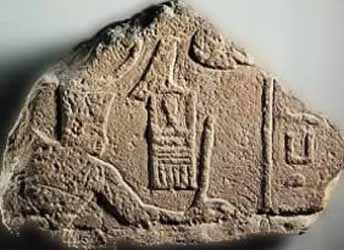
Uncertainty swirls around the placement, and also the events of the 3rd Dynasty king known as Sanakhte (Sanakht). He may have been Nebka, who was known to manetho, and listed on both the Turin Cannon and the Abydos king list as the first king of this dynasty. However, this is problematic to say the least, for we base our belief that he was Nebka on a source that lists his Horus name, Sanakhte, together with a second name that ends with the element "ka" Most of the information we have on this king refers to him as Nebka. In fact, some sources list the two as separate kings, with Nebka founding the 3rd Dynasty and Sanakhte ruling later, perhaps after Khaba.
However, despite this, mud seal impressions bearing the name of Nethery-khet Djoser from the Abydos tomb of the last king of the 2nd Dynasty Khasekhemuy and connected with the burial seem to suggest that Khasekhemuy's widow and her already ruling son Djoser were in charge of the king's burial. On the basis of sealing from the tomb of Khasekhemwy, which name her as "Mother of the King's Children," the wife of the last ruler of the 2nd Dynasty seems to have been one Nimaethap. The latter name was also found, with the title of "King's Mother", upon seal impressions from Mastaba K1 at Beit Khallaf, a gigantic monument dated to the reign of Djoser. Hence, on the basis that Djoser was succeeded by Sekhemkhet and of indications pointing to Khaba as the third in line, Nebka may have been the fourth king of the dynasty, to be equated with the Nebkara following Djoser-teti and preceding Huni in the Saqqara king list.
Many theories regarding the rule of Sanakhte have been advanced, including the possibility that Sanakhte, as a member of a former ruling family, usurped the throne from the ruling family at the beginning of the dynasty. Hence, Djoser could have indeed buried his father, Khasekhemuy, and won back the throne from the usurper, Sanakhte. However, we are told that today, most Egyptologists do believe that he was a latter king of the Dynasty, even though most current documentary resources continue to equate Sanakhte with Nebka, as the 1st King of Egypt's noteworthy 3rd Dynasty who probably ruled from This near Abydos.
Little is known of this king, despite a reign of some 18 or 19 years (others might attribute a much shorter reign of from five to seven years, which would allow a better fit for him ruling before Djoser), for his reign is missing from the Palermo Stone, and important source of information on this period of Egyptian history. However, Nebka is mentioned in Papyrus Westcar. The only large scale monumental building that can possibly be attributed to him is at Beit Khallaf (mastaba K2).
His name also appears on the island of Elephantine in southern Egypt near Aswan on a small pyramid. Another of the few sources we have evidencing this king is a fragment of a sandstone relief from Wadi Maghara in the Sinai. It would seem that he, along with Djoser, began the exploitation in earnest of the mineral wealth of the Sinai peninsula, with its rich deposits of turquoise and copper. It shows the king's name in a serekh before his face.
The relief depicts Sanakhte, who is about to smite an enemy, wearing the Red Crown of Lower Egypt. We also know of a priest of Nebka's mortuary cult who appears to have lived in the reign of Djoser.
Some Egyptologists continue to believe that he may have been the brother of his famous successor, Djoser (or Zoser), or if not, perhaps his father, but apparently current thought among Egyptologists leans against this. It has been suggested that his tomb at Saqqara was incorporated into the Step Pyramid of Djoser, though little real evidence for this exists, but it has also been suggested that his is a little known monument that seems to nicely fill the typological lacuna between the Shunet el Zebib and the Step Pyramid at Saqqara.
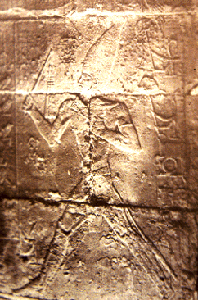
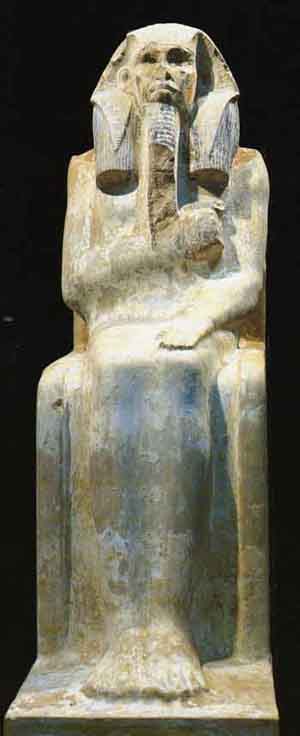
Other spellings of his name include: Zoser, Dzoser, Zozer (or Zozzer), Dsr, Djeser, Zoser, Zosar, Djéser, Djeser, Horus-Netjerikhet, Horus-Netjerichet.
Netjerikhet Djoser (Turin King List "Dsr-it"; Manetho "Tosarthros") is the best-known pharaoh of the Third Dynasty of Egypt, for commissioning his vizier Imhotep to build his Step Pyramid at Saqqara.
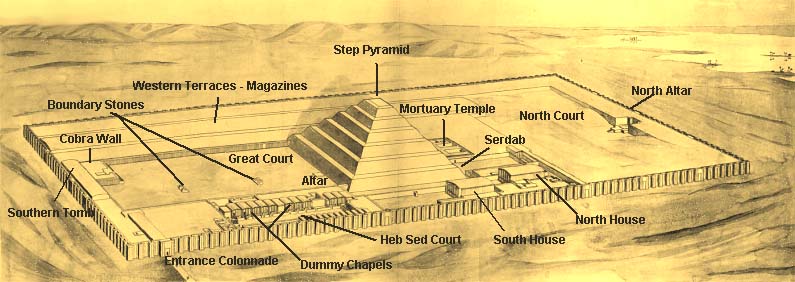
In contemporary inscriptions, he is called Netjerikhet, meaning body of the gods. Later sources, which include a New Kingdom reference to his Step Pyramid, help confirm that Netjerikhet and Djoser are the same person.
While Manetho names one Necherophes, and the Turin King List names Nebka, as the first ruler of the Third dynasty, some contemporary Egyptologists believe Djoser was the first king of this dynasty, pointing out that the order in which some predecessors of Khufu are mentioned in the Papyrus Westcar suggests that Nebka should be placed between Djoser and Huni, and not before Djoser.
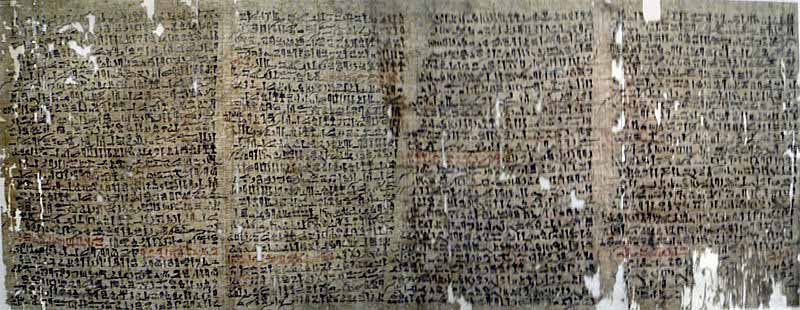
Westcar Papyrus is a document about Khufu, a 4th-Dynasty Egyptian leader, and contains a cycle of five stories about marvels performed by priests. Each of these tales is being told at the court of Khufu by his sons.
Manetho also states Djoser ruled for 29 years, while the Turin King List states it was for 19. It is possible that Manetho's number is a mistake for the earlier Turin King List; and it is also possible that the author of the Turin King List confused the bi-annual cattle censuses as years, and that Djoser actually reigned for 37 or 38 years. Because of his many building projects, particularly at Saqqara, some scholars argue that Djoser must have ruled for at least 29 years.
Because Queen Nimaethap, the wife of Khasekhemwy, the last king of the Second dynasty of Egypt, appears to have held the title of "Mother of the King", some writers argue that she was Djoser's mother and Khasekhemwy was his father. Three royal women are known from during his reign: Inetkawes, Hetephernebti and a third, whose name is destroyed. One of them might have been his wife, and the one whose name is lost may have been Nimaethap. The relationship between Djoser and his successor, Sekhemkhet, is not known.
Djoser sent several military expeditions to the Sinai Peninsula, during which the local inhabitants were subdued. He also sent expeditions to the Sinai where they mined for valuable minerals like turquoise and copper. It was also strategically important as a buffer between Asia and the Nile valley. He also may have fixed the southern boundary of his kingdom at the First Cataract.
Some fragmentary reliefs found at Heliopolis and Gebelein mention Djoser's name and suggest that he had commissioned construction projects in those cities. An inscription claiming to date to the reign of Djoser, but actually created during the Ptolemaic Dynasty, relates how Djoser rebuilt the temple of the god Khnum on the island of Elephantine at the First Cataract, thus ending a famine in Egypt. While this inscription is but a legend, it does show that more than two millennia after his reign, Djoser was still remembered.
Sekhemkhet was Pharaoh in Egypt during the Third dynasty. According to Manethonian tradition, a king known as "Djoserty" reigned a relatively brief seven years, and modern scholars believe Djoserty and Sekhemkhet to be the same person. His reign would thought to have been from about 2649 BC until 2643 BC.
While there was a known successor to Djoser, Sekhemkhet's name was unknown until 1951, when the leveled foundation and vestiges of an unfinished Step Pyramid were discovered at Saqqara by Zakaria Goneim. Only the lowest step of the pyramid had been constructed at the time of his death.
Jar seals found on the site were inscribed with this king's name. From its design and an inscription from his pyramid at Saqqara, it is thought that Djoser's famous architect Imhotep had a hand in the design of this pyramid.
Archaeologists believe that Sekhemket's pyramid would have been larger than Djoser's had it been completed. Today, the site, which lies southwest of Djoser's complex, is mostly concealed beneath sand dunes and is known as the Buried Pyramid.
Khaba was the fourth king during the 3rd Dynasty. He is believed to have reigned a relatively brief four years between 2603 BC to 2599 BC, although these dates are highly conjectural, based on what scant evidence exists of this early king.
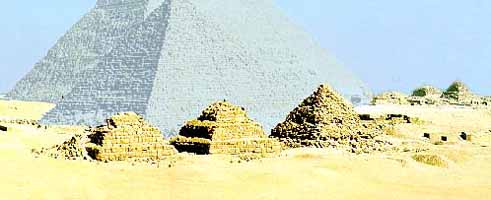
Khaba is commonly associated with the Layer Pyramid, located at Zawyet el'Aryan, about 4 km south of Giza. It is an unfinished pyramid whose construction is typical of Third Dynasty masonry and would have originally risen about 42-45m in height (it is now about 20m). While there were no inscriptions directly relating the pyramid to this king, a number of alabaster vessels inscribed with this king¹s name were discovered nearby in Mastaba Z-500 located just north of the pyramid.
Khaba is mentioned in the Turin King List as "erased", which may imply that there were dynastic problems during his reign, or that the scribe working on this list was unable to fully decipher the name from the more ancient records being copied from. It has also been suggested that Khaba may be the Horus name of the last king of the Third Dynasty, Huni, and that the two kings are the same person.
Khaba's name, typically displayed within a serekh rather than the more typical cartouche form established by the end of this dynasty, was written using the sign of a rising sun that had the sound value of kha, and a Saddle-billed Stork that had the sound value of ba.
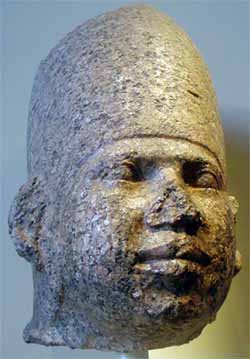
Huni was the last Pharaoh of Egypt of the Third Dynasty.
Huni's wife Queen Meresankh I was the mother of Snefru. Huni was probably the father of Hetepheres, queen of the next king, Snofru.
While there is some confusion over kings and their order of rule near the end of the 3rd Dynasty, it is fairly clear who terminates the period and who also stood on the threshold between ancient Egypt's formative period and the grand courts of the Old Kingdom to follow. Huni paved the way for the great pyramid builders of the 4th Dynasty with his substantial construction projects and the possible restructuring of regional administration.
Yet, we really know very little about this king who ruled during a pivotal point in Egyptian history. The name Huni may be translated as "The Smiter". He is attested on monuments of his time by his nswt-bity name, written in a cartouche. Alternative readings have been suggested for his name, but none have been agreed upon, so he is typically called Huni even though it probably represents a corruption of his original name. He may also be one and the same as Horus Qahedjet, though this is uncertain.
In the late 1960s, a limestone stela of unknown provenance was purchased by the Louvre museum. It was inscribed with the previously unknown Horus name, Qahedjet. The stela was important to Egyptian art historians because it depicts the earliest representation of a god (Horus) embracing the king. Therefore, it received considerable attention.
Though the stela is very similar in style to the relief panels of the Step Pyramid of Djoser, the execution of the carving is superior, and the iconography is more developed. Hence, Egyptologists tend to favor a date for the stela at the end of the 3rd Dynasty. Furthermore, the Horus name for the kings who Huni succeeded have been tentatively identified. Therefore, though with no certainty, some scholars believe Qahedjet to be the Huni's Horus name
The Turin Canon provides a reign for Huni of twenty-four years, and a shorter reign than this would appear unlikely given the scale of his completed building projects. His position as the last king of the 3rd Dynasty and Sneferu's immediate predecessor is confirmed by both the Papyrus Prisse and by the autobiographical inscription in the tomb of Metjen at Saqqara.
Actually, the most impressive monument which can be relatively clearly attributed to Huni is a small granite step pyramid on the island of Elephantine. It is now thought that a granite cone, bearing the inscription ssd Hwni, meaning "Diadem of Huni", and with the determinative of a palace originally came from Elephantine. It would seem therefore that Huni built either a palace or a building associated with the royal cult on this island.
This small pyramid, together with others of similar size and construction located at Seila in the Fayoum, Zawiyet el-Meitin in Middle Egypt, South Abydos, Tukh near Naqada, el-Kula near Hierakonpolis and in south Edfu, appear to be unique, both in their size and purpose. Many Egyptologists believe that, based on the monument at Elephantine, all but the Seila pyramid may be dated to the reign of Huni. Excavations have shown that his successor, Sneferu, was responsible for the pyramid at Seila.
Elephantine is an island in the River Nile, It measures some 1.2 km from north to south, and is about 400 m across at its widest. It is a part of the modern Egyptian city of Aswan.
There has been no small amount of debate about the purpose of these pyramids. Almost all of the major pyramids in Egypt, before and after Huni, were royal tombs of some nature. However, these small step pyramids appear to have little to do with funerary practices. Many scholars have suggested, though there is little proof, that they were constructed as cult places of the king or marked royal estates.
There was, for example, an administrative building attached to the pyramid at Elephantine. Their locations suggest that there could have been one such pyramid for each nome (ancient Egyptian province), at least in southern Upper Egypt. Some have even suggested that their construction might have been associated with the reorganization of regional government during Huni's reign. Irregardless, their purpose remains unclear without further evidence for their use.
No one is certain about Huni's burial. It has been suggested that the pyramid at Maidum may have been his, and many Egyptologists seem certain that it was at least begun by him, though Middle and New Kingdom graffiti from the site credits Sneferu with its construction.
However, if Sneferu had a hand in this project, it is probable that he only finished the monument and converted it into a true pyramid. After all, Sneferu built at least two other large pyramids and was buried in one of these. Otherwise, Huni's burial remains a mystery. If he was not buried in the Maidum pyramid, than he may have been buried at Saqqara, though the only obvious location at that site, the unexcavated Ptahhotep enclosure to the west of the Djoser's complex, has no substructure. Hence, it is unlikely to be an unfinished step pyramid complex.
Some scholars theorize that the small step pyramids built by Huni somehow lessened the importance attached to the royal tomb. According to this view, Huni may never have constructed a pyramid tomb complex at all.
However, the general consensus seem to be that the Maidum Pyramid was indeed his, even though there is no evidence of there ever having been a stone sarcophagus in the subterranean burial chamber and therefore no clear evidence he was ever buried in this pyramid. Another theory suggests that he was actually buried in an unidentified mastaba number 17 on the northeast side of the pyramid, where there is a typical Old Kingdom, uninscribed granite sarcophagus.
Though we traditionally end the 3rd Dynasty with Huni, he was probably the father of the next King. It is though that the mother of Sneferu was probably Meresankh, who was either a lesser wife or concubine of Huni's. If so, Sneferu would have married his half sister, Hetepheres I, who was Huni's daughter. Little else is known about Huni's family relationships.
Huni's memory lived on for some time after his death, for the Palermo Stone lists an estate belonging to his cult during the reign of the 5th Dynasty King Neferirkara some 150 years after his death. This is really no surprise, for the achievements of Huni's reign are impressive, and he clearly ushered in the great culture of Egypt's Old Kingdom.
The structure of provincial government recorded in the tomb of Metjen probably signals a definitive break from the Early Dynastic past, and set the stage for the absolute central control of manpower and resources needed for the massive pyramid building of the 4th Dynasty.
The Fourth Dynasty
The Fourth Dynasty of Egypt was the second of the four dynasties considered forming the Old Kingdom. The pharaohs of this dynasty include some of the best-known kings of ancient Egypt known for constructing pyramids, perhaps the hallmark of Egypt. All of the kings of this dynasty commissioned at least one pyramid to serve as a tomb or cenotaph.
Like the Third Dynasty, these kings maintained their capital at Memphis.Sneferu, the dynasty's founder, is known to have commissioned three pyramids, and some believe he was responsible for a fourth. So although Khufu, his successor and son by Hetepheres I, erected the largest pyramid in Egypt, Sneferu had more stone and brick moved than any other pharaoh.
Khufu (Greek Cheops), his son Khafra (Greek Chephren), and his grandson Menkaura (Greek Mycerinus) all achieved lasting fame in the construction of their pyramids. To organize and feed the manpower needed to create these pyramids required a centralized government with extensive powers, and Egyptologists believe the Old Kingdom at this time demonstrated this level of sophistication.
Although it was once believed that slaves built these monuments, study of the pyramids and their environs have shown that they were built by a corvée of peasants drawn from across Egypt, who apparently worked while the annual Nile flood covered their fields.
While the pyramids suggest that Egypt enjoyed unparalleled prosperity during the Fourth Dynasty, they survived as a reminder to the inhabitants of the forced labor that created them, and these kings - Khufu in particular - were remembered as tyrants: first in the Papyrus Westcar, and millennia later in legends recorded by Herodotus (Histories, 2.124-133).
The archetype of the Turin King List, which otherwise records all of the names of the kings of this dynasty, has two names missing, which the scribe indicated with the Egyptian word wsf ("missing").
Sextus Julius Africanus reports Manetho had the names Bikheris and Tamphthis in those positions, while Eusebius does not mention either. Some authorities (such as K.S.B. Ryholt) follow Africanus in adding a possible Egyptian version of these names to the list; others omit them entirely.
The earliest known records of Egypt's contact with her neighbors are dated to this dynasty. The Palermo stone records the arrival of 40 ships laden with timber from an unnamed foreign land in the reign of Sneferu.
The names of Khufu and Djedefra were inscribed in gneiss quarries in the Western Desert 65 km. to the northwest of Abu Simbel; objects dated to the reigns of Khufu, Khafra, and Menkaura have been uncovered at Byblos and to the reign of Khafra even further away at Ebla, evidence of diplomatic gifts or trade.
It is unclear how this dynasty came to an end. Our only clue is that a number of Fourth Dynasty administrators are attested as remaining in office in the Fifth Dynasty under Userkaf.
Egyptian Fourth Dynasty Family Tree
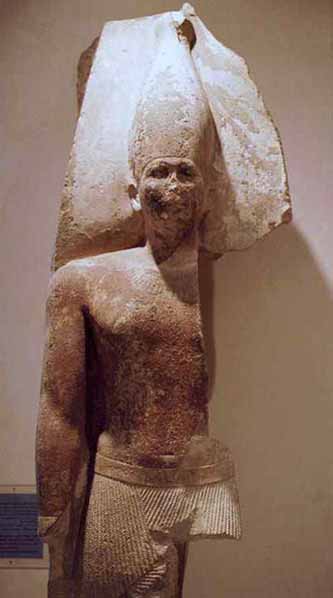
First king of the 4th Dynasty
Sneferu, also spelt as Snefru or Snofru (in Greek known as Soris), was the founder of the fourth dynasty of Egypt, reigning from around 2613 BC to 2589 BC. While the Turin Cannon records the length of his reign as 24 years, graffiti in his northern (Red, and later) pyramid at Dahshur may suggest a longer reign.
His name, Snefer, means "To make beautiful" in Egyptian.
His Horus name was Nebmaat, but his royal titulary was the first to have his other name, Snefru, enclosed within a cartouche.

It was by this "cartouche name" that he and subsequent kings were best known. He enjoyed a very good reputation by later generations of ancient Egyptians. Considered a benign ruler (highly unusual), the Egyptian term, snefer can be translated as "to make beautiful".
Snefru was most likely the son of Huni, his predecessor, though there seems some controversy to this, considering the break in Dynasties. However, his mother may have been Meresankh I, who was probably a lessor wife or concubine and therefore not of royal blood. Hence, this may explain what prompted the ancient historian, Manetho (here, Snefru is known by his Greek name, Soris), to begin a new dynasty with Snefru. However, it should be noted that both the royal canon of Turin and the later Saqqara List both end the previous dynasty with Huni.
Snefru was almost certainly married to Hetepheres I, who would have been at least his half sister, probably by a more senior queen, in order to legitimize his rule. She was the mother of his son, Khufu, who became Egypt's best known pyramid builder, responsible for the Great Pyramid at Giza.
It is believed he had at least three other wives who bore him a number of other sons, including his eldest son, Nefermaet, who became a vizier. He probably did not outlive his father, so was denied the Egyptian throne. Other sons include Kanefer, another vizier who apparently continued in this capacity under Khufu (Cheops). We also believe he fathered several other sons, and at least several daughters.
In reality, Snefru may probably be credited with developing the pyramid into its true form. He apparently began by build what was probably a step pyramid at Maidum (Madum), which was later converted into a true pyramid. But this effort met with disaster (though probably not a quick one), because of the pyramid's mass and steep slope.
He also built the Red Pyramid and Bent Pyramid at Dahshur. The Bent Pyramid was the first true pyramid planned from the outset, while the Red Pyramid is the first successful true pyramid built in Egypt. The Red and Bent Pyramids are, respectively, the third and fourth largest pyramids known to have been built in Egypt.
In addition, Snefru is credited with at least one of a series of "regional" or provincial pyramids, at Seila. This is a small, step pyramid with no substructure. A number of other similar pyramids dot the Egyptian landscape, as far south as Elephantine Island, and some Egyptologists believe Snefru (or his father) may be responsible for all, or at least some of these. No one is very certain of the purpose of these small pyramids, but they were likely either associated with provincial cult worship of the king, or may have been located near to the king's "rural" palaces.
In many respects, including the combined scale of building projects and the evolutionary architectural achievements, Snefru must be ranked as one of Egypt's most renowned pyramid builders. In fact, the sheer volume of building work was greater than any other ruler in the Old Kingdom.
However, his achievements in pyramid building extended beyond the pyramid structure itself, and obviously incorporated evolving religious beliefs. During his reign, we see the first real elements of the sun worship that was to follow and reach a culmination over a thousand years later in the reign of Akhenaten.
For the first time in the orientation of the building plan the main axis was oriented from east to west rather than north to south, as were earlier pyramids. This was apparently a move away from the astronomical "star" oriented beliefs, toward the east-west passage of the sun and the worship of Ra. Now, with Snefru, the mortuary temple is on the east rather than than on the north side like in the Djoser Step Pyramid complex at Saqqara. Furthermore, we see the first of the small satellite pyramids placed near the southern face of the main pyramid, a structure that we still do not completely understand today. Furthermore, the pyramid and mortuary temple elements were now linked by a causeway to a valley temple located on the edge of the cultivation closer to the Nile. It is believed the valley temple operated as a monumental gateway to the whole of the pyramid complex.
While the growing importance of the sun worship is obvious in Snefru's reign, the worship of Osiris was probably also beginning to influence Egyptian religion, though little in the way of documented evidence can be supplied. With all of Snefru's building activities, it is not surprising that he was very active in the quarries. His name has been found attested to in rock inscriptions at the turquoise and copper mines of the Wadi Maghara in the Sinai peninsula, as well as other quarries.
Snefru is also credited with keeping the administrative power of the country within the royal family, As stated above, two of his sons became viziers and it is likely that many other royal children held important posts. By the end of the 6th Dynasty, administrative power within Egypt would be greatly decentralized which is considered at least one of the reasons Egypt fell into the chaos of the First Intermediate Period. Generally, Egypt was most powerful and prosperous when Egyptian rulers maintained a strong central government, like that of Snefru's. In order to further facilitate this centralized power base, he also apparently reorganized land ownership among his nobles, presumably to prevent them from becoming too powerful, but also to stimulate the cultivation of marshlands.
According to the Palermo Stone, he campaigned militarily against the Nubians and Libyans. The expedition to Nubia was a very large campaign. The Palemo Stone records a booty of 7,000 captives and 200,000 head of cattle. The population of Nubia was never very great, so this was perhaps a rather substantial depopulation of the area. Not only were these campaigns against Nubia initiated to obtain raw material and goods, but also to protect Egypt's southern borders as well as the all important African trade routes. The campaign in Libya records 11,000 captives and 13,100 head of cattle.
The Palermo Stone also provides a record of forty ships that brought wood (probably cedar) from an unnamed region, but perhaps Lebanon. Among other building uses, Snefru is credited as has having used some of this wood to build Nile river boats up to about 50 meters (about 170 ft.) in length.
It is interesting to note that Snefru's later deification was perhaps partially due to his status as an "ideal" king, who's deeds were emulated by later kings to justify their legitimacy to the throne. His reputation was no doubt enhanced by the Westcar Papyrus (now in Berlin), probably written during the Hyksos period. Yet, even though considered a warlike king by many, his worship in the Middle Kingdom was just as much fueled by the admiration of common Egyptians (according to traditional history).
Ancient literature repeatedly depicts him as a ruler who would address common Egyptians as "my friend", or "my brother". It is also not surprising that during the Middle Kingdom, his cult was particularly strong among the Sinai miners. Because of his massive building projects, considerable resources from Snefru's reign were employed to develop those quarries.
Therefore, Snefru became especially associated with this quarry district. Certainly Snefru had a number of choices for his burial, but we believe he was actually interred in the Red Pyramid at Dahshure. There, in the 1950s, the remains of a mummy were found of a man past middle age, but not much so, suggesting that the king may have come to rule Egypt at a fairly early age.
Some Egyptologists continue to attribute the Madium Pyramid to Huni (or more properly, Nysuteh), as well as possibly to Horus Qahedjet (2637-2613 BC). However, even these scholars appear to believe that Snefru finished this pyramid, but it would have been highly unusual for a ruler of Egypt to have made such a substantial contribution to his predecessor's mortuary complex. Still the question of who actually started the construction of this pyramid is a mater for future discovery.
Reference: Monarchs of the Nile Aidan Dodson, 1995
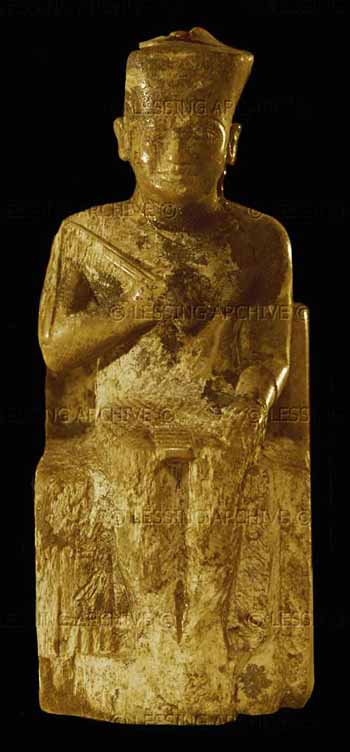
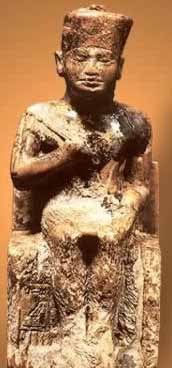
Second king of the 4th Dynasty
He was allegedly the builder of the Great Pyramid of Giza - the only one of the Seven Wonders of the Ancient World still standing - and founder of the Giza Plateau near modern Cairo and Memphis. He reigned from around 2589 BC to 2566 BC.
Unlike his grandfather Huni, and his father Sneferu, both of whom were remembered as benevolent and compassionate rulers, Khufu was reported by Herodotus to have been a cruel despot.
KhufuÐs Horus name was Medjedu, and his full birth-name was Khnum-Khufu, meaning, "the god Khnum protects me." Khnum was considered the local god of Elephantine, near the first Nile cataract, who created mankind on his "potterÐs wheel" and was also responsible for the proper flooding of the Nile.
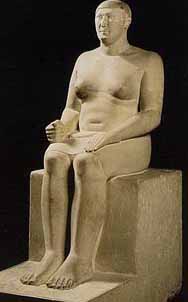 Khufu may have been already on in years when he took the throne. His kinsman and vizier, Hemiunu, was also the architect of the Great Pyramid. KhufuÐs senior wife was named Merityotes, and she and his other two wives were each buried in one of the three smaller subsidiary pyramids that lie just south of the mortuary temple of the main pyramid.
Khufu may have been already on in years when he took the throne. His kinsman and vizier, Hemiunu, was also the architect of the Great Pyramid. KhufuÐs senior wife was named Merityotes, and she and his other two wives were each buried in one of the three smaller subsidiary pyramids that lie just south of the mortuary temple of the main pyramid.
Khufu had several sons, among them Kawab, who would have been his heir, Khufukhaf, Minkhaf, and Djedefhor, Djedefre and Khephren or Khafre. The so-called Papyrus Westcar contains tales of some of these sons.
Though the Great Pyramid somehow represents the very essence of "ancient Egypt," the King for whom it was built as a tomb has left little recorded information of his actual reign. Khufu probably reigned for 23 or 24 years. There is evidence that he sent expeditions to the Sinai, and worked the diorite stone quarries deep in the Nubian desert, north-west ofAbu Simbel.
Inscriptions on the rocks at Wadi Maghara record the presence of his troops there to exploit the turquoise mines, and a very faint inscription at Elephantine indicates that he probably mined the red granite of Aswan as well.
Herodotus, who wrote his histories and commentaries on Egypt around 450 BCE, centuries after Khufu had reigned around 2585 BCE, recorded this about the King: Kheops brought the country into all kinds of misery. He closed the temples, forbade his subjects to offer sacrifices, and compelled them without exception to labor upon his works the Egyptians can hardly bring themselves to mention Kheops so great is their hatred.
It was even said that Khufu set one of his daughters into a brothel so that she could raise revenue to build the pyramid, also asking each client for a block of stone so she could build her own pyramid. No evidence exists for such a story, though there are smaller pyramids which probably belonged to half-sister/wives of Khufu, and he did have at least three daughters of record.
Even prior to Herodotus, the author of the document now known as the Papyrus Westcar depicts Khufu as cruel. The text was inscribed in the Hyksos period prior to the 18th Dynasty, though its composition seems to date from the 12th Dynasty. One story, Kheops and the Magicians, relates that a magician named Djedi who can reputedly bring back the dead to life. He is presented to Khufu, who orders a prisoner brought to him, so that he 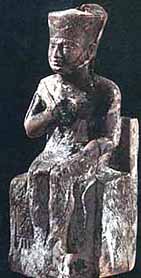 may see a demonstration of the magician's talents.
may see a demonstration of the magician's talents.
Khufu further orders that the prisoner should be killed, and then Djedi can bring him back to life. When Djedi objects, the King relents his initial decision, and Djedi then demonstrates his talent on a goose.
It should be noted that while Khufu has acquired this reputation, accurate or not, the years and labor that went into building his Pyramid tomb was surpassed by the three pyramids built by his father Sneferu, who was contrarily remembered as an amiable ruler.
The Great Pyramid originally stood 481 feet high complete with its original casing, but since it lost its top 30 feet, it stands only 451 feet now. It covers about 13 acres. The exterior casing was shining white limestone, laid from the top downwards. It was largely robbed in the Middle Ages to build medieval Cairo. Nothing now remains of the limestone mortuary temple, which was 171 feet by 132 feet, except its black basalt floor. The complexÐs valley temple has disappeared under the Arab village, though traces of this temple could be seen when new sewer systems were being laid down.
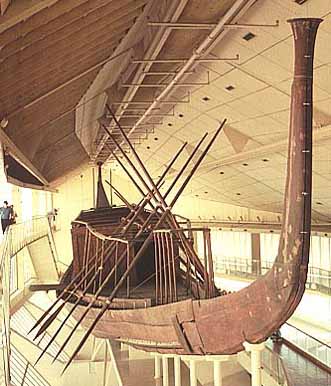 Along with the pyramid itself, the remains of a magnificent 141-foot long ship of cedar wood had also been found in a rock-cut pit close to the south side of the Great Pyramid. A second ship may also rest in a second sealed pit, though not in as good condition as this first. The ship was restored over many years, and now lies in a special museum built near the pyramid itself. The ship may have symbolized the solar journey of the deceased king with the gods, particularly the sun-god Ra.
Along with the pyramid itself, the remains of a magnificent 141-foot long ship of cedar wood had also been found in a rock-cut pit close to the south side of the Great Pyramid. A second ship may also rest in a second sealed pit, though not in as good condition as this first. The ship was restored over many years, and now lies in a special museum built near the pyramid itself. The ship may have symbolized the solar journey of the deceased king with the gods, particularly the sun-god Ra.
It is ironic indeed that for all the magnificence of his pyramid, his funeral boat, and the wonders of the funerary furnishings that were discovered belonging to his mother, Queen Hetepheres, wife to Sneferu, the only portrait we have of Khufu is a tiny 3-inch high statue sculpted in ivory.
I t may have been once easy to contemplate the builder of such a monument as the Great Pyramid to have virtually enslaved his people to accomplish it, and to order a royal princess to prostitute herself. Sneferu, Khufu's father, had three separate pyramids built during his reign. Surely the workmen or nobles would have left some evidence of their dissatisfaction at least at the whimsicality of their sovereign if not his despotism. Yet Sneferu is remembered as amiable and pleasure-loving.
And Khafre, Khufus son, left not only a pyramid but quite possibly a Sphinx as well. And history, or at least, historians, do not record Khafre is being a despot.
Continuing work at Giza is further showing that the men responsible for the building of the pyramids led normal lives. They baked bread, ate fish, made offerings to their blessed dead and the gods, and cared for their families.
They left funerary stelae and tombs behind to give us an indication of how they considered their lot. It is more likely that the Greeks could less easily conceive of such a project of long-term labor as being anything but forced. Perhaps some archaeologist millennia in our own future may find rusted iron skeletons of some of our finest skyscrapers and wonder to what cruel overlords we owed the sweat of our own forced labor.
Reference: Monarchs of the Nile Aidan Dodson, 1995
Third king of the 4th Dynasty
The Egyptian pharaoh Djedefra was the successor and son of Khufu. The mother of Djedefra is unknown.
He married his (half-) sister Hetepheres II, which may have been necessary to legitimize his claims to the throne if his mother was one of Khufu¹s lesser wives.
He also had another wife, Khentet-en-ka with whom he had (at least) three sons, Setka, Baka and Hernet and one daughter, Neferhetepes.
The Turin King List credits him with a rule of eight years, but the highest known year referenced to during this reign was the year of the 11th cattle count. This would mean that Djedefra ruled for at least eleven years, if the cattle counts were annual, or 21 years if the cattle counts were biennial.
He was the first king to use the title Son of Ra as part of his royal titulary, which is seen as an indication of the growing popularity of the cult of the solar god Ra.He continued the move north by building his (now ruined) pyramid at Abu Rawash, some 8 km to the North of Giza.
It is the northernmost part of the Memphite necropolis.
In 2004, evidence that Djedefra may have been responsible for the building of the Sphinx in the image of his father was reported by French Egyptologist Vassil Dobrev.
Chephren - Suphis II - Appearing Like Re - (2558 BC - 2532 BC)
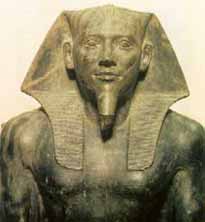
Fourth king of the 4th Dynasty.
His birth name was Khafre, which means "Appearing like Re". He is also sometimes refereed to as Khafra, Rakhaef, Khephren or Chephren by the Greeks, and Suphis II by Manetho. He was possibly a younger son of Khufu (Cheops) by his consort, Henutsen, so he was required to wait out the reign of Djedefre, his older brother, prior to ascending to the throne of Egypt. However, there is disagreement on this matter. There is no agreement on the date of his reign; some authors saying it was between 2558 BC and 2532 BC; this dynasty is commonly dated ca. 2650 BC2480 BC.
Identifying him with Suphis II, Manetho gives his reign as lasting 66 years, but this certainly cannot be substantiated. Modern Egyptologists believe he may have ruled Egypt for a relatively long period, however, of between the 24 years ascribed to him by the Turin Royal Cannon papyrus (which was apparently confirmed by an inscription in the mastaba tomb of Prince Nekure), and 26 years. He is thought to have ruled Egypt from about 2520 to 2494 BC.
There are rumors of a problem with the succession of Khafre. Some authorities maintain that Djedefre may have even stole the throne, perhaps as a younger brother of Khafre, and that Khafre may have even murdered him.
Much of this speculation originates from the fact that Djedefre broke with the Giza burial tradition, electing instead to locate his tomb (pyramid) at Abu Rawash. However, there is little real evidence to support such a conclusion, and in fact, Khafre continued Djedefre's promotion of the cult of the sun god Re by using the title the 'Son of the Sun' for himself and by incorporating the name of the god in his own.
It is clearly evident from the fine mastaba tombs of the nobles in his court that Egypt was prosperous while Khafre held the throne. Carved on the walls of the tomb of Prince Nekure, a "king's son", was a will to his heirs. It is the only one of its kind known from this period, and in it he leaves 14 towns to his heirs, of which at least eleven are named after his father, Khafre.
Though his legacy was divided up among his five heirs, 12 of the towns were earmarked to endow the prince's mortuary cult.We do know that Khafre participated in some foreign trade, or at least diplomacy, for objects dating from his reign have been found at Byblos, north of Beirut, as well as at Tell Mardikh (Ebla) in Syria. He apparently also had diorite quarried at Tashka in Nubia and probably sent expeditions into the Sinai.
Though there are few inscriptions left for us to completely understand the era of Khafre's rule, he did leave behind some of the most important treasures ancient Egypt has to offer.
Besides his pyramid complex at Giza, most Egyptologists believe he also built the Great Sphinx and that it is his face that adorns this huge statue, which sits just beside his valley temple.
In addition, the life size diorite statue of Khafre found in his valley temple and now located in the Egyptian Antiquities Museum is one of the most magnificent artifacts ever discovered.
Like his father Khufu, Khafre was depicted in fold tradition as a harsh, despotic ruler. Though as late as the New Kingdom, Ramesses II seems to have had no qualms about taking some of the casing from his pyramid at Giza for use in a temple at Heliopolis, by Egypt's Late Period, the cults of the fourth dynasty kings had been revived, and Giza became a focus of pilgrimage.
Khafre's mummy has been lost, but his mortuary temple at Giza yielded one of the finest extant Old Kingdom statues an almost undamaged life-size seated diorite figure of the king enjoying the protection of the god Horus. A statue of Khafre under the protective shadow of a falcon is in the Cairo Museum.
Reference: Monarchs of the Nile Aidan Dodson, 1995
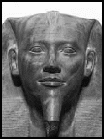
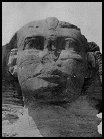
Fifth king of the 4th Dynasty
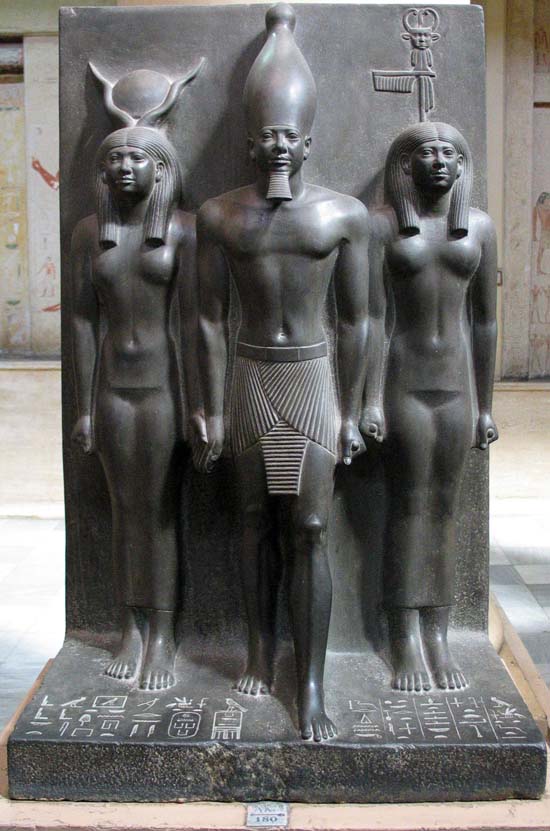
Menkaure with his wife Khamerernebty II
appearing as Hathor (left) and the goddess
of the seventeenth nome of Egypt (right)
Menkaure is the son of Khafre and the grandson of Khufu of Dynasty IV. He bore the titles Kakhet and Hornub. There are doubts that Menkaure could be the son of Khafre, because the Turin Papyrus mentioned a name of a king between Menkaure and Khafre, but the name was smashed. A Middle Kingdom text written on a rock at Wadi Hamamat includes the names of the kings: Khufu, Djedefre, Khafre, Hordedef and Bauefre. This text indicates to some that Hordedef and Bauefre ruled after Khafre. But it seems that their names were not written as kings because Menkaure's names were not mentioned. It has been suggested that Hordedef's name was mentioned because was a wise educated man in this period and perhaps Bauefre was a vizier.
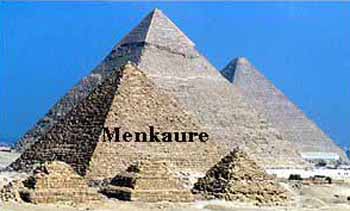
He built the smallest pyramid at the Giza plateau, and is called Menkaure is Divine. Menkaure's pyramid is two-tone in color: the top half covered with bright white limestone casing, while red Aswan granite was used for the casing on the bottom. E1-Makrizi, the Arab historian named Menkaure's pyramid as the colored pyramid because of the red granite casing. The pyramid stands 66.5m high, which is much smaller than the other two pyramids at Giza. The pyramid is remarkable because it is the only pyramid in Dynasty IV that was cased in 16 layers of granite, Menkaure planned to cover the surface with granite but he could not because of his sudden death.
The pyramid complex of Menkaure was completed by his son and successor Shepseskaf but the temples has architectural additions which were made during Dynasties V and VI. This suggests that the cult of Menkaure was very important and perhaps differed from the cults of Khufu and Khafre. Shepseskaf completed the pyramid complex with mudbrick and left an inscription inside the Valley Temple indicating that he built the temple for the memory of his father.
At the pyramid's entrance, there is an inscription records that Menkaure died on the twenty-third day of the fourth month of the summer and that he built the pyramid. It is thought that this inscription dates to the reign of Khaemwas, son of Ramsses II. The name of Menkaure found written in red ochre on the ceiling of the burial chamber in one of the subsidiary pyramids.
When pyramid was explored in the 1830's, a lidless basalt sarcophagus was found in the burial chamber. Inside it was a wooden mummiform coffin inscribed with Menkaure's name. This is curious because mummiform coffins weren't made until much later. Best guess is that the coffin was provided in an attempted restoration during the 26th dynasty (that's 2000 years later!) when there was a renewed interest in the culture of the Old Kingdom.
The wooden coffin and basalt sarcophagus were sent on separate ships to England to end up on display in the British Museum, but a storm at sea sank the boat that was transporting the sarcophagus. It sank to the bottom of the sea and was never recovered.
The sarcophagus was allegedly lost in the Mediterranean between ports of Cartagena and Malta when the ship 'Beatrice' sank after setting sail on October 13, 1838. There still exists the wooden anthropoid coffin found inside the pyramid which bears the name and titles of Menkaure.

Menkaure's main queen was Khamerernebty II, who is portrayed with him in a group statue found in the Valley Temple. It is believed that she is buried in Giza.
Menkaure ruled for 18 years. There are two inscriptions found in his pyramid complex. The first was a decree bearing the Horus name of Merenre of Dynasty VI. The decree stated that the Valley Temple was in use until the end of the Old Kingdom. The objects found in some of the storage rooms of the temples show that the king's cult was maintained and that the temple had a dual function as a temple and a palace.
The second decree of Pepi II was found on the lower temple vestibule, awarding privileges to the priests of the pyramid city. In the adjacent open court and in the area just east of the temple lie the remains of the Old Kingdom houses. Pepi II's decree indicates that these houses belonged to the pyramid city of Menkaure. Here lived the personnel responsible for maintaining the cult of the deceased king.
The statuary program found inside the complex displays the superb quality of arts and crafts. The triads in Menkaure's valley temple suggest that his pyramid complex was dedicated to Re, Hathor, and Horus. In addition, they show the king's relationship with the gods and are essential to his kingship, indicating both a temple and palace function.
The textual evidence indicates that the high officials had more privileges in his reign that in any other period. They had many statues in their tombs; the inscriptions and the scenes increased and were set on rock-cut tombs. In the tomb of Debhen an inscription was found describing the kindness of Menkaure.
When Debhen came to visit the king's pyramid, he asked the king for permission to build his tomb near the pyramid. The king agreed and even ordered that stones from the royal quarry in Tura should be used in building his tomb. The text also mentions that the king stood on the road by the Hr pyramid inspecting the other pyramid. The name "Hr" was also found written in the tomb of Urkhuu at Giza, who was the keeper of a place belonging to the Hr pyramid. It is not clear what the Hr pyramid is. Is it a name of a subsidiary pyramid, or the name of the plateau? The Debhen texts is a revelation of how the king tried to inspire loyalty by his people giving them gifts.
Menkaure also had a new policy - he opened his palace to the children of his high officials. They were educated and raised with the king's own children. Shepsesbah is one of those children. The textual and archaeological evidence of the Old Kingdom indicates that the palace of the king was located near his pyramid and not at Memphis. Menkaure explored granite from Aswan and he sent expeditions to Sinai. Excavations under the author revealed a pari of statues of Ramses II on the south side of Menkaure's pyramid. The statues were made of granite, and one represents Ramses as king while the other as Atum-Re.
The name of Menkaure was found written on scarabs dated to the 26th Dynasty, which may imply that he was worshipped in this period.
Herodotus mentioned that Menkaure died suddenly and added that there was an oracle from the Buto statue that foretold that he would live for 6 years. Menkaure started to drink, and enjoy every moment of his remaining years. However, Menkaure lived for 12 years, thus disproving the prophecy. Herodotus also said that his daughter committed suicide.
The Greek historian also wrote that the Egyptians loved Menkaure more than his father and grandfather. The Late Period tales were based on Menkaure's reputation during the Old Kingdom. He ruled with justice, gave freedom to his officials to carve statues and make offerings, and stopped the firm rules.
Reference: Monarchs of the Nile Aidan Dodson, 1995
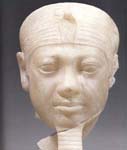
Shepseskaf was the sixth king of the 4th Dynasty.
Pharaoh Menkaure has died after a 28 year long reign. His son and heir by queen Khamerernebty II, the young Prince Khuenre, has tragically died before he could take to the throne. Menkaure is therefore succeeded by Shepseskaf, a son of Menkaure by an unknown minor wife. Although a half brother to Prince Khuenre, he was not an ideal choice for the role of Pharaoh, as he is not of complete royal blood.ð
His major wife was Bunefer. He has no known sons and one daughter, Khamaat.
He was in power for just a short period of time. This was another difficult political period, during which there were many confrontations with various priests. Many desired independence and rebelled against Shepseskaf's authority.
Shepseskaf completed his father Menkaure's Pyramid. He chose not to be buried in a Pyramid and as he returned to Saqqara after most of his 4th Dynasty predecessors had either preferred Dashur in the South (Snofru) or Abu Rawash (Djedefre) and Giza (Kheops, Khefren and Mykerinos) in the North to build their funerary monuments. This return to Saqqara has often been interpreted more as a distancing of Giza and of the supposedly oppressive politic followed by Kheops and Khefren, but there are, in fact, no valid arguments that support this theory.
Whatever Shepseskaf's motivations for returning to Saqqara may have been, it is perhaps also telling that he moved to an area in Saqqara that does not appear to have been used before: Saqqara-South. In fact, his tomb is the southern-most royal tomb of Saqqara.
Even in the choice of his funerary monument, Shepseskaf chose not to follow the standard established by his ancestors. His tomb consists of a mastaba-shaped superstructure with a small mortuary temple to the east. No satellite or queen's pyramids appear to have been built.
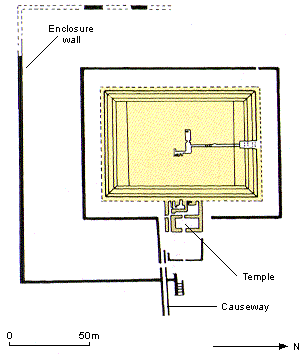
Map of the tomb and temple of Shepseskaf.
The mastaba, which has earned this monument the name Mastabat el-Fara'un, was 99.6 metres long and 74.4 metres broad. It was originally encased in limestone, except for its base course, which was in granite. It had a slope of 70 E and certainly was shaped like a shrine: a rounded top flanked by two almost vertical walls.
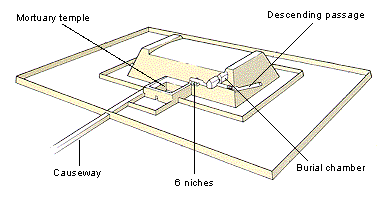
Cut-away of the Mastabat el-Fara'un showing
the original shape of this rather unique royal tomb.
Source: Lehner, Complete Pyramids, p. 139
The mastaba is entered from the north side, from where a corridor descends for 20.95 metres with a slope of 23É30'. At the end of the passage is a horizontal corridor passage followed by a second passage blocked by three portcullises and an antechamber. A short passage to the west goes down into the vaulted burial chamber that measures 7.79 by 3.85 metres and has a height of 4.9 metres. Fragments of the sarcophagus indicate that it was made of a hard dark stone and decorated like Mykerinos'. To the south of the antechamber a corridor extends with 6 niches to the east, again similar to the niches found in the pyramid of Mykerinos.
The mastaba is enclosed within two mudbrick walls: the first also incorporates a small mortuary temple that had some open courts, an offering hall and a false door, flanked by 5 magazines. The long causeway that extended towards the east has not (yet) been excavated.
After Shepseskaf died, Khentkawes, another child of Menkaure by a minor wife and Shepseskaf's half-sister, married a nobleman named Userkaf, who was the great grandson of Pharaoh Khufu. Upon his marriage to Pharaoh Shepseskaf's half sister Khentkawes, Userkaf was in a strong enough position to be crowned Pharaoh over all Egypt, and begin the 5th Dynasty of Kings.
Userkaf returned to the more traditional pyramid-tomb. From then on, the dimensions and shape of the pyramid, and the temple connected to it, would become more and more standardized.
Reference: Monarchs of the Nile Aidan Dodson, 1995
Djedefptah is a shadowy figure, and his existence is questionable. It is usual to consider Shepseskaf to be the last pharaoh of the Fourth Dynasty. Manetho however lists a king Tamphthis (this may probably a corrupted form of ptah-djedef), and notes that he reigned for 9 years.
The Turin Canon has an unnamed pharaoh after Shepseskaf who ruled for about two years, and this ruler may be Djedefptah. Very little else is known about him, although he may have been a son of Shepseskaf.
The Fifth Dynasty
The Fifth Dynasty of Egypt is considered part of the Old Kingdom of ancient Egypt. Manetho writes that these kings ruled from Elephantine, but archeologists have found evidence clearly showing that their palaces were still located at Ineb-hedj ("White Walls").
How Pharaoh Userkaf founded this dynasty is not known for certain.
The Papyrus Westcar, which was written during the Middle Kingdom, tells a story of how king Khufu of the Fourth Dynasty was given a prophecy that triplets born to the wife of the priest of Ra in Sakhbu would overthrow him and his heirs, and how he attempted to put these children - named Userkaf, Sahura, and Neferirkara - to death; however in recent years, scholars have recognized this story to be at best a legend, and admit their ignorance over how the transition from one dynasty to another transpired.
During this dynasty, Egyptian religion made several important changes. The earliest known copies of funerary prayers inscribed on royal tombs (known as the Pyramid Texts) appear.
The cult of the god Ra gains added importance, as kings from Userkaf through Menkauhor built temples dedicated to Ra at or near Abusir.
Then late in this dynasty, the cult of Osiris assumes importance, most notably in the inscriptions found in the tomb of Unas.
Amongst non-royal Egyptians of this time, Ptahhotep, vizier to Djedkare Isesi, won fame for his wisdom; The Maxims of Ptahhotep was ascribed to him by its later copyists.
Non-royal tombs were also decorated with inscriptions, like the royal ones, but instead of prayers or incantations, biographies of the deceased were written on the walls.
As before, expeditions were sent to Wadi Maghara and Wadi Kharit in the Sinai to mine for turquoise and copper, and to quarries northwest of Abu Simbel for gneiss.
Trade expeditions were sent south to Punt to obtain malachite, myrrh, and electrum, and archeological finds at Byblos attest to diplomatic expeditions sent to that Phoenician city.
Finds bearing the names of a several Fifth Dynasty kings at the site of Dorak, near the Sea of Marmara, may be evidence of trade but remain a mystery.
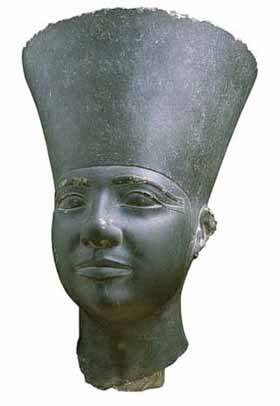
Userkaf was the founder and first king of the 5th Dynasty.
It is believed that he was father of two pharaohs, Sahure and Neferirkare Kakai, who both succeeded him to the throne. Another less common view, in concordance with a story of the Westcar Papyrus, is that first three rulers of the Fifth dynasty were all brothers, the sons of queen Khentkaus I. He is given a reign of 7 Years by both the Turin King List and Manetho.
His pyramid complex at Saqqara introduced several new changes from the previous dynasty. In comparison with the tombs of the Fourth dynasty, his pyramid was rather small. Instead, increased focus was put on the mortuary temple, which were more richly decorated than in the previous Fourth dynasty. In the temple courtyard, a colossal statue of the king was raised. The mortuary temple was to the south of the pyramid, not to the east, as was traditional. This is now seen as being due to the increasing importance of the sun god in the south, the temple would be bathed in the sun's rays throughout the day.
Userkaf, as the originator of the fifth dynasty, clearly felt he should associate himself with one of his great predecessors. To achieve this, he build his pyramid complex at Saqqara, as close as possible to that of Djoser. When completed, the pyramid was 161 ft (49 m) high and encased in limestone, though the core was sloppily built and therefore crumbled when this casing was removed by robbers. Although the complex is now ruined and largely inaccessible, limited excavations there have produced a huge pink granite head of Userkaf. Userkaf also built the first of the Solar Temples of Abu-Gurob.
Reference: The Oxford History of Ancient Egypt Ian Shaw, 2000
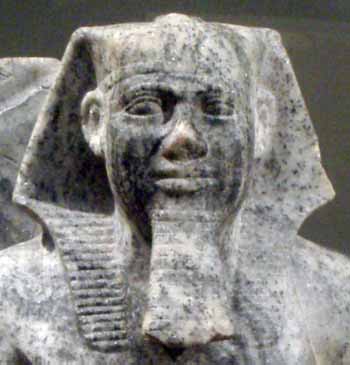
The second king of the 5th Dynasty.
Sahure was a son of queen Khentkaus I, who, in her tomb at Giza, is said to have been the "mother of two kings". His father probably was Userkaf.
There are no wives or children known to him and at least no children of his seem to have outlived him, since he was succeeded by his brother, Neferirkare, the first king known to have used separate names.
His Horus name was Nebkhau.
It is believed he ruled Egypt from around 2487 BC to 2475 BC. The Turin King List gives him a reign of twelve years. The Palermo stone notes seven cattle counts, which would indicate a reign of at least 13 years if the cattle counts were held biannualy (every two years) as this Annal document indicates for the early Fifth Dynasty period.
It is probable that Khentkaus I was the character of Redjedet in the Papyrus Westcar, who according to the magician Djedi, was destined to give birth to the children of Ra and the first kings of the 5th Dynasty. But if Khentkaus I was his mother, a scene in her tomb at Giza showing her with the royal uraeus and beard might indicate that she may have acted as a regent for Sahure.
Most foreign relations during the reign of Sahure were economic, rather than combative. In one scene in his pyramid, we find great ships with Egyptians and Asiatics on board. It is believed they are returning from the port of Byblos in Lebanon with huge cedar trees. For this, we have corraborating evidence in the form of his name on a piece of thin gold stamped to a chair, as well as other evidence of Fifth dynasty king's cartouches found in Lebanon on stone vessels. Other scenes in his temple depict what we are told are Syrian bears.
We also have the first documented expedition to the land of Punt, which apparently yielded a quantity of myrrh, along with malachite and electrum, and because of this, Sahure is often credited with establishing an Egyptian navy. There are also scenes of a raid into Libya which yielded various livestock and showed the king smiting the local chieftains. The Palermo stone also corroborates some of these events and also mentions expeditions to the Sinai and to the exotic land of Punt, as well as to the diorite quarries northwest of Abu Simbel, thus, far into Nubia.
However, this same scene of the Libyan attack was used two thousand years later in the mortuary temple of Pepi II and in a Kawa temple of Taharqa. The same names are quoted for the local chieftain. Therefore, we become somewhat suspicious of the possibility that Sahure was also copying an even earlier representation of this scene.
He apparently built a sun temple, as did most of the 5th Dynasty kings. Its name was Sekhet-re, meaning "the Field of Re", but so far its location is unknown. We know of his palace, called Uetjesneferusahure ("Sahure's splendor soars up to heaven"), from an inscription on tallow containers recently discovered in Neferefre's mortuary temple. It may have been located at Abusir as well. We also know that under Sahure, the turquoise quarries in the Sinai were worked (probably at Wadi Maghara and Wadi Kharit), along with the diorite quarries in Nubia.
Sahure is further attested by a statue now located in New York's Museum of Modern Art, in a biography found in the tombs of Perisen at Saqqara and on a false door of Niankhsakhment at Saqqara, and is also mentioned in the tombs of Sekhemkare and Nisutpunetjer, kings of the Twelfth dynasty at their tombs in Giza.
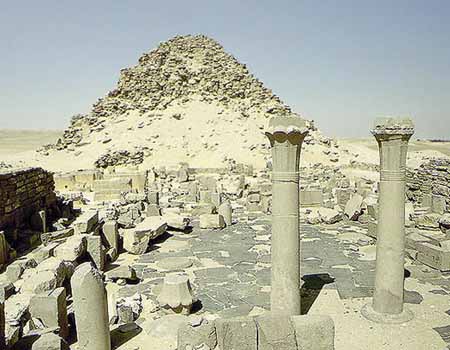
His pyramid complex was the first built at the new royal burial ground at Abusir a few kilometres north of Saqqara (though Userkaf had probably already built his solar temple there) and marks the decline of pyramid building, both in the size and quality, though many of the reliefs are very well done.
His pyramid provides us most of the information we know of this king. The reliefs in his mortuary and valley temple depict a counting of foreigners by or in front of the goddess Seshat and the return of a fleet from Asia, perhaps Byblos. This may indicate a military interest in the Near East, but the contacts may have been diplomatic and commercial as well. As part of the contacts with the Near East, the reliefs from his funerary monuments also hold the oldest known representation of a Syrian bear.
When it was excavated in the first years of the 1900s, a great amount of fine reliefs were found to an extent and quality superior to those from the dynasty before. Some of the low relief-cuttings in red granite are masterpieces of their kind and still in place at the site. The construction of the pyramid was on the other hand (like the others from this dynasty) made with an inner core of roughly hewn stones in a step construction held together in many sections with a mortar of mud.
While this was under construction a corridor was left into the shaft where the grave chamber was erected separately and later covered by leftover stone blocks and debris. This working strategy is clearly visible from two unfinished pyramids and was the old style from the Third dynasty now coming back after being temporary abandoned by the builders of the five great pyramids at Dahshur and Giza during the Fourth dynasty.
Few depictions of the king are known, but in a sculpture he is shown sitting on his throne with a local nome deity by his side.
Today only the inner construction remains partly visible in a pile of rubble originating from the crude filling of debris and mortar behind the casing stones taken away a thousand years ago. The whole inner construction is badly damaged and not possible to access today.
The entrance at the north side is a short descending corridor lined with red granite followed by a passageway ending at the burial chamber. It has a gabled roof made of big limestone layers and fragments of the sarcophagus were found here when it was entered in the early 1800s.
Sahure established the Egyptian navy and sent a fleet to Punt and traded with Palestine. His pyramid at Abusir has colonnaded courts and reliefs of his naval fleet, but his military career consisted mostly of campaigns against the Libyans in the western desert. Reliefs on the walls show evidence for trading expeditions outside Egypt Ÿ ships are shown with both Egyptians and Asiatics on board. These ships are part of an expedition to the Lebanon, searching for cedar logs. This is corroborated by inscriptions found in the Lebanon testifying to an expedition there under Sahure. As part of the contacts with the Near-East, the reliefs from his funerary monuments also hold the oldest known representation of a Syrian bear.
A relief showing a war against Libya is believed by some to be historical and by others to be merely ritual. The Palermo-stone also mentions expeditions the the Sinai and to the exotic land of Punt, as well as to the diorite quarries North-West of Abu Simbel, thus far into Nubia.
Reference: Monarchs of the Nile Aidan Dodson, 1995
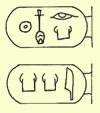
He was the third king of the 5th Dynasty.
Neferirkare was the second son of Khentkaus I to have ruled Egypt. As with his brother Sahure, it is not known whether Userkaf was his father. Neferirkare was married to a name-sake of his mother's, Khentkaus II. It is not unlikely that Khentkaus II too was related to Khentkaus I. At least two children are believed to have been born of this marriage: Neferefre and Niuserre. Other wives and children are not known.
The length of his reign is unfortunately lost on the Turin King-list and the Palermo-stone breaks of after having recorded a 5th counting, which, if the counting occurred every two years, would mean that Neferirkare at least ruled for 10 years. According to Manetho, his rule lasted for 20 years, a number which appears to be generally accepted.
The Turin Canon, also known as the Turin Royal Canon is a unique papyrus, written in hieratic currently in the Egyptian Museum at Turin, to which it owes its modern name.
The Turin Canon is broken into over 160 often very small fragments, many of which have been lost. When it was discovered in the Theban necropolis by the Italian traveller Bernardino Drovetti in 1822, it seems to have been largely intact, but by the time it became part of the collection of the Egyptian Museum in Turin, its condition had severely deteriorated.
The importance of this papyrus was first recognised by the French Egyptologist Jean-Francois Champollion, who, later followed by Gustavus Seyffarth took up its reconstruction and restoration. Although they succeeded in placing most of the fragments in the correct order, the diligent intervention of these two men came too late and many lacunae still remain.
Written during the long reign of Ramesses II, the papyrus, now 1.7m long and 0.41m, comprises on the recto an unknown number of pages that hold a list of names of persons and institutions, along with what appears to be the tax-assessment of each.
It is, however, the verso of the papyrus that has attracted the most attention, as it contains a list of gods, demi-gods, spirits, mythical and human kings who ruled Egypt from the beginning of time presumably until the composition of this valuable document.
The beginning and ending of the list are now lost, which means that we are missing both the introduction of the list -if ever there was such an introduction- and the enumeration of the kings following the 17th Dynasty. We therefore do not know for certain when after the composition of the tax-list on the recto an unknown scribe used the verso to write down this list of kings. This may have occurred during the reign of Ramesses II, but a date as late as the Dynasty can not be excluded. The fact that the list was scribbled on the back of an older papyrus may indicate that it was of no great importance to the writer.
Neferirkare was the first king to have his birth-name made part of the official titulary, thus adding a second cartouche. He was the first king to have employed both a prenomen and nomen (two names and two cartouches),a custom that later kings would follow.
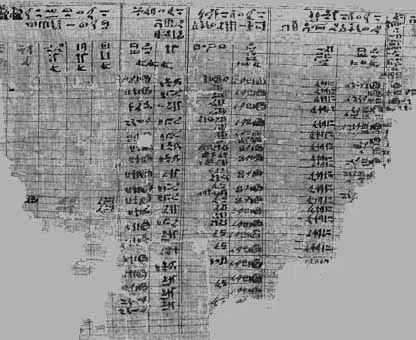
The hieratic papyrus found at his pyramid complex are probably his most notable contributions to Egyptology. They were originally discovered in 1893 by local farmers and consist of 300 papyrus fragments. They remained unpublished for some seventy-five years, even as the first archaeologists were excavating Abusir. Only later did a Czech mission, which explored the site in 1976, take full advantage of these documents.
The Neferirkara archive reveals a world of detailed and very professional administration. Elaborate tables provide monthly rosters of duty: for guarding the temple, for fetching the daily income (or 'offerings') and for performing ceremonies including those on the statues, with a special roster for the important Feast of Seker.
Similar tables list the temple equipment, item by item and grouped by materials, with details of damage noted at a monthly inspection. Other records of inspection relate to doors and rooms in the temple building. The presentation of monthly income is broken down by substance, source and daily amount. The commodities are primarily types of bread and beer, meat and fowl, corn and fruit. They also mention a mortuary temple of a little-known king, Raneferef, who's tomb was yet to be discovered but thanks to these papyrus, is now known and has yielded significant discoveries.
He also completed (or modified) the solar-temple built by Userkaf in Abusir. His own solar-temple, called Set-ib-Re, has yet to be located.
He was also the second king to erect his funerary monument at Abusir. The seals and papyri discovered in his mortuary temple give some insights into the functioning of this temple. The documents are dated to the end of the 6th Dynasty, which indicates that the cult for the deceased Neferirkare at least lasted until the end of the Old Kingdom.
Reference: Monarchs of the Nile Aidan Dodson, 1995
He was the fourth king of the 5th Dynasty.
Little to nothing is known about Shepseskare nor his relationship to the other kings of the 5th Dynasty. Shepseskare Isi, also spelt Shepseskare, (in Greek known as Sisiris), was Pharaoh of Egypt during the Fifth dynasty, and is thought to have reigned from around 2426 BC 2419 BC. Both the Turin King List and Manetho suggest that he ruled Egypt for seven years.
Several clay seals dated to his reign have been found at Abusir, and these are about the only witnesses of Shepseskare's reign. It is not known whether he built a pyramid or a solar-temple, although the unfinished pyramid located at Abusir between the pyramid of Sahure and the solar-temple of Userkaf, has, by some, been credited to him.
Reference: Monarchs of the Nile Aidan Dodson, 1995
He was the fifth king of the 5th Dynasty.
Neferefre was the first son of Neferirkare and Khentkaus II to come to the throne. The Turin King-list is too fragmentary to provide us with the length of Neferefre's reign.
He built a solar-temple named Hetep-Re, which has not yet been discovered, and, at Abusir, started with the building of his own pyramid complex which was left unfinished.
Because of the premature death of Neferefre, his successor hastily completed work on Neferefre's pyramid at Abusir, which acquired the form of a mastaba. Although it may share the same resemblance to a mastaba tomb, it is not situated north-south, and it is not rectangular in shape, but square on all sides.
Known as the "Unfinished Pyramid", it stands just seven meters high, but from the constructed portions, the walls slope at a 64º angle. Similarly to other sites of other Ancient Egyptian pyramids, the burial site of Neferefre contains more than one pyramid, and his lines up the three pyramids, similarly to the Great Pyramids.
Artifacts found at the sight show that the name of his pyramid is "Divine is Neferefre's Power." All the other buildings of Neferefre's mortuary complex were erected under the reign of his brother, Nyuserre Ini. While exploring ruins of the mortuary complex, a Czech archaeological expedition discovered papyri of temple accounts, statues of the king, decorated plates and many seal prints.
Pieces of mummy wrappings and bones were also found, which were discovered to be the remains of Neferefre. The anthropological analysis of his mummy reveals him to have died in his early twenties, between 20 and 23 Years, according to Verner. This evidence accords well for a king who died relatively soon into his reign.
Reference: Monarchs of the Nile Aidan Dodson, 1995
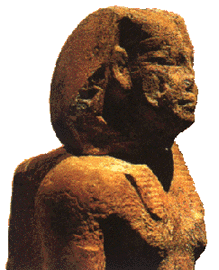
He was the sixth king of the Fifth Dynasty.
Niuserre was the second son of Neferirkare and Khentkaus II to have ascended to the throne. He was married to a woman named Reputneb, of whom a statue was discovered in the valley-temple connected to his and Neferirkare's pyramid complex. It is not known whether he had any children (that out-lived him).
The Turin King-list is somewhat damaged at the point where Niuserre's name is mentioned, and only allows us to state that he ruled for more than 10 years. The 44 years credited to him by Manetho is considered unreliable. The representation of a Sed-festival found in his solar-temple may indicate that he ruled at least for 30 years.
An inscription found in the Sinai shown Niuserre triumphant over his enemies. It is debatable whether this inscription refers to an actual victory of Niuserre, or whether it was merely symbolic. It does, however, show that Niuserre was active in the Sinai.
He built a solar-temple, named Shesepu-ib-re, in Abu Gurab, a kilometre or more to the North of Abusir. Not only is this the biggest and most complete solar-temple, it is also the only one that was constructed completely of stone. The many finely carved reliefs that remain show the king during a Sed-festival and the world as created by the solar god, with representations of the seasons and the provinces of Egypt. With the reign of Niuserre, the solar-cult appears to have come to its summit.
The sanctuary consisted of an entrance hall that was leading to a court of 100x75 m / 330x250 ft. in size which was surrounded by a stone wall. In the middle of the courtyard stood a huge obelisk, a stone that looked like the modern-day Washington Monument. The obelisk was the cultic symbol for Re, the sun-god.

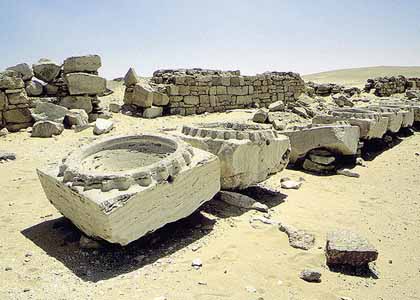
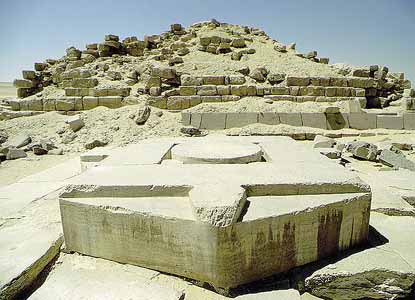
The pyramid-complex of Niuserre is located at Abusir, between the pyramids of Sahure and Neferirkare. Instead of building his own valley temple, he had his pyramid complex connected to the valley temple of Neferirkare. His two wives, Reputneb and Khentikus, were buried near him at Abusir.
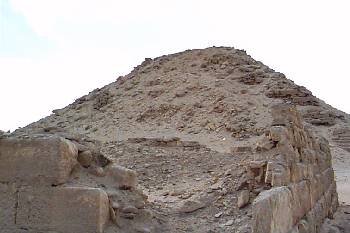
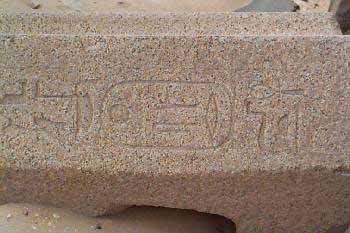
His Cartouche
Astronomical Triangulations of Aries, Equinoxes,
Solstices and the Duat of Pharaonic Egypt
Reference: Monarchs of the Nile Aidan Dodson, 1995
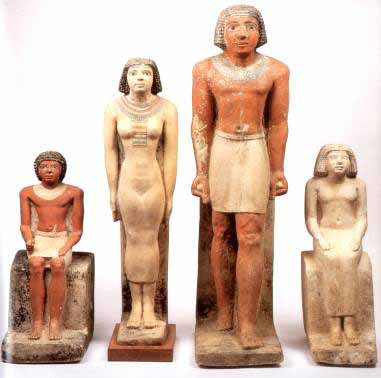
Menkauhor was the seventh king of the 5th Dynasty.
His birth name was Kalu. According to the Turin King-list he ruled for some eight years. References fairly consistently give his reign as lasting from about 2421 or 2422 until 2414. He never achieved the level of fame of the other kings of the 5th dynasty. His reign is attested by an inscription in the Sinai and a seal from Abusir.
The relationship of Menkauhor with his predecessors or successors is not known. However, it is likely that he was either the brother or son of Niuserre, his predecessor. If he was Niuserre's son, it would probably have been by Niuserre's chief queen, Neput-Nebu. It is also likely that he was the father of Djedkare, who followed him to the throne. If not, he was almost certainly Djedkare's brother, with Niuserre being both king's father, or Djedkare's cousin, with Djedkare being the son of Neferefre, and Menkauhor being the son of Niuserre.
He is reputed as having sent his troops to Sinai in order to acquire materials for the construction of his tomb.
He was the last pharaoh to build a sun temple. His solar-temple, called Akhet-Re, and his pyramid are mentioned in texts from private tombs. This dynasty was famous for their solar temples, and Menkauhor's temple is probably located at either Abusir or Saqqara. It would have probably been the last such temple built, however, because his successors appear to have drifted away somewhat from the solar cult.
Menkauhor's pyramid has not been positively identified, but if the assumption that his pyramid is to be located at Dashur is correct, this would imply a departure from Abusir. However, some Egyptologists seem to strongly believe that his pyramid is the "Headless Pyramid", located in North Saqqara east of Teti's complex. There is mounting evidence to support this conclusion. B. G. Ockinga, for example argues that during the 18th Dynasty the Teti complex may have been associated with a cult belonging to a deified Menkauhor. Wherever it is located, his pyramid was called "Divine are the (cult) places of Menkauhor".
His reign is attested by an inscription in the Sinai at Magharah, indicating that he continued to quarry stone in that location as did his predecessors and successors. Given the lack of information on this king, we can also probably make some assumptions based on the activities of those predecessors and successors. For example, while he have no inscriptions as evidence, both Niuserre and Djedkare quarried stone northwest of Aswan, so it is likely that Menkauhor did as well.
It is also highly likely that he continued commercial and diplomatic relations with Byblos, as did both Niuserre and Djedkare, and in fact we do find a few objects in the area near Dorak bearing his name. It is also likely that he had some sort of dealings with Nubia, but whether he sent expeditions to Punt, as did Niuserre and Djedkare, is unknown.
Otherwise, Menkauhor is also attested to by a small alabaster statue that is now located in the Egyptian museum in Cairo and by a relief of Tjutju adoring King Menkauhor and other divinities. This relief, owned by the Louvre, has been on loan to the Cleveland Museum of Art.
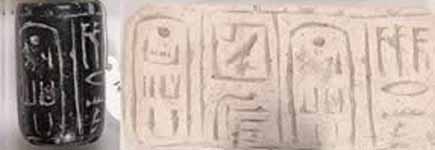
There is also have a seal bearing his name that was found at Abusir.
Djedkare was the eighth king of the 5th Dynasty.
The relationship of Djedkare with his predecessors or successors is not entirely known, but he was probably the son of Menkauhor, his predecessor. If not, then he may have been Menkauhor's brother by Niuserre, or even Menkauhor's cousin by Neferfre, though that seems unlikely. It is possible that his principle queen was Meresankh IV, but her tomb is located in the main Saqqara necropolis. A pyramid believed to be that of a queen or consort of Djedkare just next to that of his in South Saqqara has no inscriptions to provide us with evidence of her name. According to an Abusir Papyrus, Djedkare perhaps lived in South Saqqara near his pyramid.
According to the Turin King List he ruled for 28 years, but records found in the mortuary temple of Neferefre at Abusir indicate that he ruled for at least 30 years. Actually, the dates on the Turin King List have been read by some Egyptologists as giving him a reign of 38 years. Manetho records 44 years for this king, but the mummy found in his pyramid at South Saqqara and believed to be Djedkare is thought to be that of about a 50 year old man. Given this king's apparently long reign, it is surprising we have so little information about him.
Djed-ka-re was the king's throne name, meaning "Soul of Re Endureth". His birth name was Isesi (Asosi). He distanced himself somewhat from the earlier rulers of this dynasty by not building a sun temple and having himself buried at Saqqara rather then Abusir.
Djedkare's name has been found in the Sinai at Maghara, demonstrating a continued Egyptian interest in this rich region. Two expeditions at ten year intervals are recorded there. We also find him mentioned at the quarries northwest of Aswan, and at Abydos and in Nubia. In Nubia, we find his expedition to Punt mentioned in a graffito found at the site of Tomas. He apparently also maintained commercial and diplomatic contacts with Byblos. He is further attested to in the biographies of Itush at and also Gemni at Saqqara.
He his mentioned in a number of letters including one from Pepy II. We find references on vessels mentioning his first Sed Festival and he is also referenced on a dedication inscription to Niuserre found at Abusir. We know of a few officials of his reign, including Ptahhotep, one of his viziers. However, this is probably not the famous author of the Maxims, but either his father or grandfather.
His reign is marked by some important changes. For example, the solar cult, although not abandoned, loses some of its importance and predominance, and the power of the central government is weakened to the advantage of the provincial administration. Another important change that occurred during Djedkare's reign is the return to Saqqara as a burial place. This does not mean, however, that the funerary temples of Abusir were abandoned. The larger part of the papyri found in the funerary temple of Neferirkare are dated to Djedkare, and it is clear that he did much work maintaining the Abusir area.
His heir was his son, Prince Remkuy, who died before he assumed the throne.
Reference: The Oxford History of Ancient Egypt, Ian Shaw 2000
Unas was the ninth and last king of the 5th Dynasty and what some believe to be the end of the Golden Age of the Old Kingdom.
The 6th Dynasty would finally be the end of Egypt's grand beginning, as the country would then slip into the troubling First intermediate Period.
Unas was his birth name, but he is also referred to as Unis, Ounas and Wenis. His Horus name was Wadj-tawy which means "Horus, the flourishing one of the Two Lands".
According to the Turin King list, Unas ruled for 30 years, or perhaps slightly more of part of the number is in the lacuna, which is confirmed by Manetho, who recorded 33 years. He probably ruled Egypt between 2375 and 2345 BC.
Wenis had two wives, Queen Nebet, who was the mother of Prince Wenisakh, and Queen Khenut. It has been proposed that Iput the first was his daughter. Both of Unas' Queens were buried in mastaba tombs outside of Unas' pyramid complex which, in itself is unusual since often in this period the Queens would be buried in smaller pyramids near their husband's.
His reign is not well attested therefore we know little about this king despite his fairly well preserved funerary complex at the southwest corner of the Step Pyramid of Djoser at Saqqara. It now lies in ruins on the Saqqara Plateau.
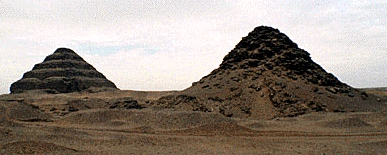
Beneath the rubble, in the burial chamber, we find one of the finest examples of the Pyramid Text inscriptions hewn in the polished stone walls and ceiling.
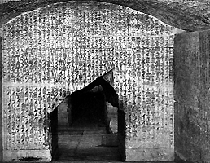
Rise up my father, great king
so that you may sit in front of them.
The cavern of the broad sky is opened to you
so that you may stride in the sunshine.
Stand up for me, Osiris, my father.
I am your son. I am Horus.
I have come that I might cleanse and purify you,
that I might preserve you and collect your bones.
I say this for you.
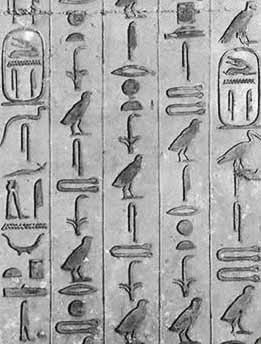
While Unas' pyramid is the smallest of the royal pyramids build during the Old Kingdom, it was the first that we know of to have its internal walls inscribed with the various (128) spells making up the Pyramid Text. The texts, meant to aid the pharaoh's soul on its journey to the next world, would adorn the walls of many future pyramids and tombs and is the earliest large religious composition known from ancient Egypt.
Unas' pyramid also established the typical plan of the internal chambers for pyramids that would be used through the end of the 6th Dynasty.
In death, King Unas is identified with the gods Ra and Osiris, and referred to as Osiris Unas. E. A. Wallis Budge, in his "The Gods of the Egyptians", also tells us that he was called Unas, the Slayer and Eater of Gods.
He was apparently worshipped around Saqqara for many years after his death.
Osiris was originally a local deity of the Eastern delta, but sometime around the reign of Unas his worship became much more widespread. We believe Maspero discovered parts of Unas' mummy in 1880, which are now in the Cairo Museum.
It is not believed that Unas left an heir, though he may have one time had a son named Ptahshepses, and therefore there was a short period of political instability prior to Teti, the first ruler of the 6th Dynasty, ascent to the throne. Teti's wife, Iput, was possibly a daughter of Unas, and his vizier Kagemni probably also worked under Unas. Furthermore, a pink granite gateway in Unas' mortuary temple bears the inscription of the names and titles of Teti, indicating that part of the temple was completed after Unas's death. This evidence suggests that there may not have been a true break between the 5th and 6th Dynasties.
We find scenes from his causeway that links his mortuary temple and valley temple depicting the moving by barge of granite columns from the quarries at Aswan to his mortuary temple, but we also find scenes of emaciated people. These latter scenes may show the effects of a famine that might have been the cause of the political decline that ended the Old Kingdom. There are also scenes of Asiatic traders arriving in Egypt by boat, perhaps from Byblos, as well as scenes of markets, hunting in the desert and a small vignette of desert life. We believe that Unas probably pursued a policy of diplomatic contact both with Byblos and Nubia. He also apparently was also responsible for building activities at Elephantine near modern Aswan, as well as Saqqara. At Elephantine, an inscription also shows a giraffe and other exotic animals that were apparently bought to Egypt during his reign. Another drawing found on a discovered vase shows battle scenes during his reign.
His name has been found in Elephantine, at the Southern border of Egypt (Aswan), and also on an alabaster vessel found in Byblos, the latter perhaps indicating some commercial or diplomatic activities between Egypt and the Near East during this period. He seems not to have left any apparent heirs after his death, which may have resulted in some political instability following his death.

An inscription raised at Elephantine shows a giraffe that was brought to Egypt with other exotic animals for ancient Egyptians, during Wenis' reign when successful trade expeditions were conducted with neighboring nations.
Reference: Monarchs of the Nile Aidan Dodson, 1995
Sixth Dynasty - 2323-2152 BCE
All kings of the 6th dynasty, except for Merenre II and Nitocris, are attested by archaeological sources. Merenre II and Nitocris are only known through the king-lists and Manetho. No known monuments give there names and they are not even mentioned in inscriptions of high officials. Because the king-lists often give Merenre II the same titulary as Merenre I, it is believed that at least his titulary may be the result of a mistake.
The Turin King-list makes a summation of regnal years for the first five dynasties, before listing the kings of the 6th through 8th dynasties. This may suggest that with the 6th Dynasty, a new royal house came to power. The relationship between the founder of the 6th Dynasty and his predecessor is debated. It is believed by some that he was married to his predecessor's daughter.
From a cultural point of view, the 6th Dynasty is the continuation of the end of the 5th Dynasty. The kings continued to commission pyramids for their mortuary cult. The pyramids and mortuary temples of this period are of a standard size and basically have the same layout. The burial chamber, antechamber and entrance corridor of these pyramids are inscribed with Pyramid Texts, following the example set by Unas of the 5th Dynasty. Most kings of the 6th Dynasty also chose to build their funerary monument in Saqqara and here too they were following the example of the last two kings of the 5th Dynasty.
Governmental reforms were intended to strengthen the residence's hold on the rest of the country. It is often claimed that the policy of instating local governors in the provinces eventually caused the downfall of this dynasty and of the Old Kingdom.
It can indeed be noted that during the 1st Intermediate Period, the power of these local rulers appears to have increased, to the detriment of the central government.
The long reign of Pepi II is also often considered the cause of the end of the Old Kingdom.
In this view, the elderly king's court was the stage of intrigue and plot, with different members of the royal family and some high ranking officials conspiring to get a grasp on the government.
It must, however, be noted that there is no evidence to support this "romantic" fantasy. Even if the ageing Pepi II were unable to rule the country by himself, the central administration was organised well enough to govern in his place.
It is believed more and more that changes in climate and a lower inundation of the Nile are likely to have played an important part in the downfall of the dynasty.
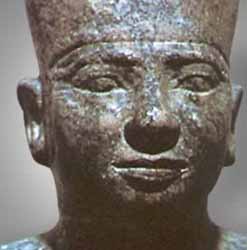
Teti was the first ruler of the 6th dynasty.
Egypt's 6th Dynasty marks the decent into the darkness of the First Intermediate Period in Egypt's history. At times, the rule of these kings is somewhat obscure, including that of Teti (sometimes also known as Othoes, from Manetho), who was the first king and the founder of the 6th Dynasty His reign settled some of the accession problems following the death of Unas. In fact, he adapted the Horus name, Seheteptawy, which means, "He who pacifies the Two Lands".
He ruled Ancient Egypt from around 2345 until 2333 BC, though of course Egyptologists differ on these dates, as well as his length of rule. The Turin King's List gives him less then one year's rule, which most scholars find very unlikely. Manetho suggests thirty, to thirty-three years, but there is no evidence of his jubilee festival, so this also seems unlikely. The latest known date from Teti's reign is that of the "sixth census", an event that took place on average every two years, or possibly every year and a half. Therefore many Egyptologists give him a reign of twelve years.
His wife, Queen Iput I, was probably the daughter of King Unas who was the last king of the 5th Dynasty. The queen was the mother of Teti's heir, King Pepi I. Historians believe that she is the one that gave him the royal power, legitimizing his rule. She is buried in her own pyramid near Teti's at Saqqara. Other wives included Khuit and Weret-Imtes. Along with his son, Pepi I, he also probably had another son named Teti-ankh-km, which means "Teti-ankh the Black", and a daughter named Seshseshet (also called Watet-khet-her). Her marriage to the vizier Mereruka probably furthered Teti's political stability, creating good will within the increasingly powerful nobility.
Almost all the major court officials of King Unas remained in power during Teti's reign, including his other vizier, Kagemni. As stated, we know little about Teti's reign, though there is evidence that quarry work was performed on his behalf at Hatnub near Abydos, and that he maintained commercial and diplomatic relations with Byblos. He also may have maintained relations with Punt and Nubia, at least as for south as the site of Tomas in northern Nubia.
We have evidence of his exempting the temple at Abydos from taxes, and he was the first ruler to be particularly associated with the cult of Hathor at Dendera.
Teti granted more lands to Abydos and his name was inscribed in Hatnub. He built a pyramid in Saqqara which is called by modern Egyptians the "Prison Pyramid". Egyptologists discovered a statue of him made of black and pink granite. The statue is located at the Egyptian museum.
The king was murdered by his guards for mysterious reasons, according to the Manetho. However, there is no other evidence of this violent death, though it might help to explain the possible short rule of a King Userkare, possibly between that of of Teti and his son, Pepi I. It is interesting to note that this king, arbitrarily left out of most modern lists of kings, is better attested to then most histories of Egypt allow.
Many references today point out that the only references we have for Userkare are from the Turin and Abydos king's lists, but this is not so. Other documents bearing his name have survived, including one referring to workers at Qau el-Kebir south of Asyut who were possibly engaged in building his tomb. Userkare means the "Ka of Ra is powerful", and therefore has a strong resonance of the 5th Dynasty. Therefore, Userkare may have been a surviving rival of Teti from the 5th Dynasty. However, he may have also simply been a regent associated with Queen Iput after Teti's death, as Pepi I may have been too young to ascend the throne at that time.
Reference: Monarchs of the Nile Aidan Dodson, 1995
He was the second king of the Sixth Dynasty and an usurper to the throne.
Userkare may have been a royal claimant from the Fifth dynasty but he was certainly a rival to Teti for the throne. Since Manetho claims that Teti was killed by his bodyguards, theories of conspiracy have been put forward that Userkare was the leader of this conspiracy who then proceeded to seize the throne. The recently discovered South Saqqara Stone document from Pepi II's reign confirms his existence and gives him a reign of 2 to 4 Years. Teti's son, Pepi I, eventually managed to oust Userkare and succeed his murdered father.
In the Turin King List, there is a lacuna between Teti and Pepi I Meryre, large enough to have fit an entry for Userkare. Userkare is apparently mentioned in several king-lists.
Userkare started work on some larger building projects, as shown by an inscription mentioning his workforce. However, no pyramid-complex has been identified for him presumbly because of the shortness of his reign.
Reference: Wikipedia
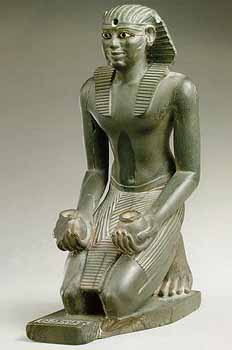
Pepi I was the third king of the 6th Dynasty.
The throne name Meryre means "Beloved of Re".
This was a period that would eventually fall into the abyss of the First Intermediate Period. Pepi I was this pharaoh's birth name, though we may also find him listed as Pepy I, Piopi I, Pipi and the Greek Phiops. His throne name was Mery-re, meaning "Beloved of Re", though he actually used the throne name, Nefersahor during the first half of his reign, later changing it to Mery-re. He ruled Egypt from about 2332 through 2283 BC. He probably ascended the throne as an early age, and appears to have ruled for some 50 years (or at least 40 years).
It is entirely possible that Pepi I did not follow his father to the throne. Kings Lists include the name of a King Userkara between that of Teti and Pepi I, and it may be that this king usurped the throne for a short time.
He was probably the son of Teti and his queen, Iput I. Though he may have had at least six, the wives of Pepi I that we know of were Ankhnesmerire I and II (Sometimes also found as Meryre-ankh-nas), who were the daughters of an influential official (Probably governor of the region) at Abydos named Khui. Pepi I made his brother-in-law, we believe a son of Khui named Djau, vizier.
A woman named Were-Imtes may have been his first wife but some Egyptologists have suggested that she might not have been his wife at all. It may have been Were-Imtes who plotted a conspiracy against her husband from the harem, but she was found out and punished. This happened in the twenty-first cattle census, or about year 42 of the king's rule. An accomplice in this plot might have been Rewer, a vizier of Pepi I who's name has been erased from his tomb. However, Callender has suggested that the conspiracy was not by one of Pepi's queens, but was instead a plot by perhaps the mother of the mysterious King Userkare. There is considerable confusion between the explanations provided by various Egyptologists about this conspiracy.
Apparently, he married Ankhnesmerire I late in his rule, perhaps even after the harem conspiracy, and may have married her younger sister after the first sister's death, but this is by no means clear. His sons, Merenre (by Ankhnesmerire I) and Pepi II (by Ankhnesmerire II) would rule Egypt through the end of the 6th Dynasty.
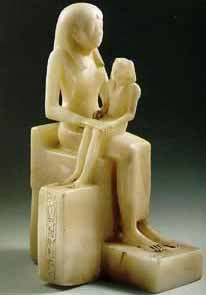
Ankhnesmerire II holds the infant Pepi II
He also had a daughter by Ankhnesmerire I called Neith, who would later marry her half brother Pepi II. It appears that Pepi II was born either just before or soon after Pepi I's death. Pepi I may have had a number of other wives, including a Nebuunet (Nebwenet) and Inenek-Inti, who's small pyramids are near his at South Saqqara. An inscription has also been found documenting another queen, perhaps from Upper Egypt, named Nedjeftet. Other family members, though we are not so sure of their relationships, probably included a woman named Meretites, and another woman named Ankhesenpepi (or Ankhnesmerire) III. In June 2000 Dr. Zahi Hawass announced the discovery of another pyramid that has been discovered by the French team near Pepi I's that appears to be that of Ankhnesmerire II, though in this report she is referred to as Ankhes-en Pepi.
At least four statues of the king have survived, including the earliest known life size sculpture in metal. This state cane from the temple of Hierakonpolis (Nikhen) in upper Egypt and is made of copper. Found with it was also a copper statue of his young son and future king, Merenre. Other statues include a small green statue of the king probably making offerings to gods, and a small alabaster statue of Pepi I holding the royal crossed flail and scepter (crook).
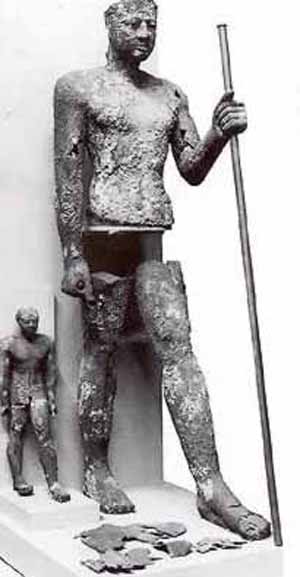
Copper statue of Pepi I and Merenre
The reign of Pepi saw the rising influence and wealth of nobles outside the royal court, a condition that perhaps had much to do with a decline into the First Intermediate Period. These nobles built fine tombs for themselves and often boasted of privileges resulting from friendship with Pepi I.
Pepi I initiated a number of trading and other expeditions, often for fine stone to be used in his many building projects. One inscription found at the alabaster quarries at Hatnub is dated to year 50 of his reign. It refers to the 25th cattle count, which was a biennial event. He was also active at the Wadi Maghara turquoise and copper quarries in the Sinai, the greywacke and siltstone quarries of Wadi Hammamat, where his first Sed Festival is mentioned. We believe he also maintained diplomatic and commercial relations with Byblos and Ebla.
He may have also sent expeditions to the mines of Sinai and as far away as Palestine. The expedition into Palestine was led by a person named Weni the Welder (Uni?) and involved landing troops from the sea. A single inscription is the only document of the five campaigns led under Pepi I Palestine, the Land of the Sand Dwellers as the Egyptians called the regions east of Egypt.
Pepi I probably did considerable building but little of it remains, as such. Some of his building projects were probably incorporated into later projects, but he did leave behind many inscriptions. Building projects of Pepi I include the remains of a chapel (Hwt-ka) at Bubastis, as well as projects at Elephantine and Abydos. He may have carried out work at Dendara too.

The Pyramids of Pepi I & II
He built his pyramid at South Saqqara and the Pyramid Text inscribed on the pyramid walls were the first to be found by Egyptologists, though not the first recorded in a pyramid. This pyramid was called Mn-nfr, meaning (Pepi is) established and good". The corruption of this name by classical writers provided our modern name for Egypt's ancient capital, Memphis. His palace may have been very near his pyramid in South Saqqara.
Pepi is further attested to by decrees found at Dahshure (now in Berlin) and Coptos. He was mentioned in biographies of Weni in his tomb at Abydos, Djaw from his tomb at Abydos, Ibi in his tomb at Deir el-Gabrawi, Meryankhptahmeryre in his tomb at Giza, Qar in hist tomb at Edfu and the biography on a tomb at Saqqara by an unknown person.
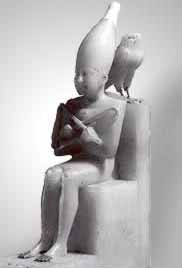
There are a number of interesting questions to be answered about this period. Unas, the last king of the 5th Dynasty began to distance himself from the sun cult so closely connected to the earlier dynasty rulers. However, he did not seem to completely withdraw from this cult. But by the time of Teti, the first ruler of the 6th Dynasty, ties seem to have been severed. He was murdered, we are told and then we find perhaps a new king usurping the throne of Egypt named Userkare. His name means the "Ka of Ra is powerful", reflecting back on the old sun cult.
When Pepi I does ascend the throne, perhaps only after a year of rule by Userkare, he has the name of Userkare removed wherever possible, as one might imagine he would under the circumstances. However, Pepe I himself is next the subject of a plot, who at least a few Egyptologists believe might have been initiated by the mother of Userkare. Most resources explain the murder of Teti, the ascension to the throne of Userkare and the plot against Pepi I as three different events, but could much of the trouble of this period have been the results of the pharaohs' abandonment of the sun cult? We also see Pepi I reaching out to the power structure of Abydos, perhaps as allies. This is all simply speculation, historical fiction if you will allow, but the point being is that there is much left to be learned about this period of Egypt's history.
Reference: Egypt Tour
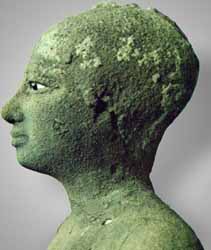
He was the fourth king of the 6th dynasty
This copper statue, found with a much larger copper statue of Pepi I, has long been assumed to be of Merenre and a boy or young man. However, it has been questioned lately whether it is instead a statue of Pepi II. These are believed to be the oldest, large copper statues ever found, but some are now questioning whether the statue of the boy is actually that of Merenre, or rather a young Pepi II.
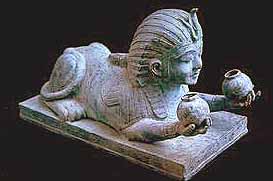
There is also a very small sphinx of Merenre in the National Museum of Scotland, Edinburgh.
Merenre, sometimes referred to as Merenre I as there was a much later king by the same name, was the third ruler of Egypt's 6th Dynasty. As the oldest living son of Pepi I, he succeeded his father, we believe, at a fairly young age, and probably died unexpectedly young, perhaps between his fifth and ninth year of rule. He was succeeded by his younger half brother, Pepi II. The Oxford History of Ancient Egypt places the years he ruled as 2287-2278 BC while Chronicle of the Pharaohs gives him from 2283 until 2278.
Merenre was this king's throne name, which means "Beloved of Re". He is sometimes also referred to as Merenra. His birth name was Nemty-em-sa-f, which means, "Nemty is his Protection". His Horus name was Ankh-khau.
His mother was Ankhnesmerire I (Ankhesenpepi I), who, along with her younger sister by the same name, married Pepi I in the later part of his rule. Labrousse, who's team is excavating in South Saqqara where Merenre's pyramid is located, now believes that Ankhnesmerire II (Ankhesenpepi II), married Merenre. She was a late wife of Pepi I, Merenre's father, and by him, the mother of Pepi II, Merenre's half brother. She may have not been as old, or much older then Merenre, but sometimes working out relationships is interesting. Not only would she be Merenre's queen, but also his stepmother and aunt.
Pepi II would not only be his half brother and his cousin, but also his stepson. In addition, the Labrousse team excavating at Saqqara now believes that a Queen Ankhnesmerire III (Ankhesenpepi III) who's pyramid is located very near Pepi I's was a daughter of Merenre, and became the wife of Pepi II. Lets see. That would make her Pepi II's wife, niece and if Ankhnesmerire II was her mother, also his half sister. He had another daughter named Ipwet (Iput II) who's pyramid is also in the South Saqqqara pyramid field.
Merenre may have served as his father's coregent for a few years prior to Pepi I's death. Uni (Weni?), who had worked under Pepi I, continued to make expeditions, and the governor of Aswan, Harkhuf, also led expeditions into Africa. Around, his ninth regnal year, Merenre himself visited Aswan to receive a group of southern chieftains. It is interesting to note that this was a time when new people, who archaeologists refer to as the Nubian C Group, were migrating from the south into northern Nubia. Because of the growing relationship with Nubia during this period, merenre also attempted to improve travel in the first cataract region which was navigated by way of the Dunqul Oasis and canals.
The Nubian rulers are said to have helped by supplying the wood needed to construct the barges. (Since there was no wood in Lower Nubia, they would have had to procure it from sources much farther south). At the same time the Lower Nubian rulers seem also to have profited greatly by sending their fighting men to Egypt for hire. By the end of the Old Kingdom (ca. 2150 BC), the Egyptian armies were mainly composed of Nubian mercenaries, many of whom would ultimately settle in Egypt, marry Egyptian women, and become assimilated into the Egyptian population. During the Old Kingdom, Egyptian texts speak of a land in Upper Nubia called "Yam." Besides troops from "Wawat, Irtjet, and Setju" (Lower Nubia), troops from Yam, too, were hired for service in the Egyptian army. The only source that provides any real information about Yam is a biography of the Aswan governor, Harkhuf, preserved in his tomb at Aswan. Harkhuf tells us that, on behalf of the pharaohs Merenre and Pepi II, he led four expeditions to Yam, each of which took eight months.
The Nubian rulers are said to have helped by supplying the wood needed to construct the barges. (Since there was no wood in Lower Nubia, they would have had to procure it from sources much farther south). At the same time the Lower Nubian rulers seem also to have profited greatly by sending their fighting men to Egypt for hire. By the end of the Old Kingdom (ca. 2150 BC), the Egyptian armies were mainly composed of Nubian mercenaries, many of whom would ultimately settle in Egypt, marry Egyptian women, and become assimilated into the Egyptian population. During the Old Kingdom, Egyptian texts speak of a land in Upper Nubia called "Yam." Besides troops from "Wawat, Irtjet, and Setju" (Lower Nubia), troops from Yam, too, were hired for service in the Egyptian army. The only source that provides any real information about Yam is a biography of the Aswan governor, Harkhuf, preserved in his tomb at Aswan. Harkhuf tells us that, on behalf of the pharaohs Merenre and Pepi II, he led four expeditions to Yam, each of which took eight months.
Merenre, like his predecessors, maintained diplomatic and commercial relations with Byblos, and we know from inscriptions and tomb biographies that he had alabaster quarried from Hatnub and greywacke and siltstone from Wadi Hammamat. A copper statue of Merenre as a young boy was found with a much larger copper statue of his father, Pepi I. These are believed to be the oldest, large copper statues ever found, but some are now questioning whether the statue of the boy is actually that of Merenre, or rather a young Pepi II. There is also a very small sphinx of Merenre in the National Museum of Scotland, Edinburgh.
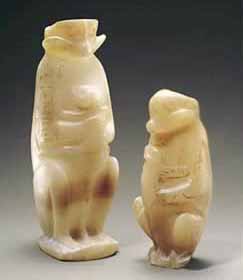
Merenre is further attested to by a Box (Hippopotamus ivory) in Paris, Louvre Museum, a rock inscriptions near Aswan, the inscriptions on an ivory mother monkey that was probably a gift to an official, decrees of the king found at the pyramid temple of Menkawre and in biographies of Uni (Weni) in his tomb at Abydos, Djaw from his tomb also at Abydos, The tomb of Harkhuf at Elephantine, The tomb of Ibi at Deir el-Gabrawi, the Tomb of Qar at Edfu, and an unknown persons tomb at Saqqara.
He is also mentioned in an inscription in the tomb of Maru at Giza (though this inscription is now in Brussels). Recently another inscription has also been found by a Polish team that mentions Merenre on a rock wall at Deir el-Bahari on the West Bank at Luxor (ancient Thebes).
Merenre was probably buried in his pyramid at South Saqqara, though apparently because of his unexpected death, this pyramid was not yet completed. Until fairly recently, it was believed that the first ever mummy was that of Merenre I, though in reality the mummy found in his pyramid may not have been that of Merenre. Nevertheless, in 1997, excavations began at Hierakonopolis revealing a large predyanstic cemetery full of older mummies. However, if the mummy is indeed that of Merenre, it would remain the oldest know royal mummy.
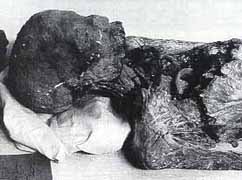
The mummy discovered by Gaston Maspero in 1881, while working at the pyramid of Merenre I at Saqqara South, presents us with somewhat of a problem with regard to its identification.
Based on the place where it was discovered, in the black granite sarcophagus inside the pyramid, it has been identified as belonging to Merenre I. If this identification is correct, this mummy would be the oldest complete royal mummy known to us today.
An important part of the problem is the fact that the current whereabouts of the mummy are unknown, making it impossible to examine it with more modern tools and equipment than was available in the late 19th and the early 20th century.
Reference: Egypt Tour
"Beautiful is the Soul of Re"
He was the fifth ruler of the 6th dynasty.
According to the Turin King-list, he ruled for over 90 years, which appears to be confirmed by Manetho, who recorded 94 years. This would make Pepi II the longest ruling king of Ancient Egypt. Some doubt has however been shed on this high number, and some researchers believe that it was the result of a miss-reading of 64.
However, because of the onset of the First Intermediate Period, the latter part of his reign was probably ineffectual, perhaps at least somewhat due to his advanced age. While the power of the nomarchs grew, the power of pharaoh dissolved. With no central power, local nobles began raiding each other's territories.
His mother Ankhnesmerire II most likely ruled as regent in the early years of his reign.
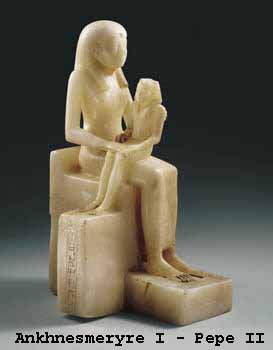
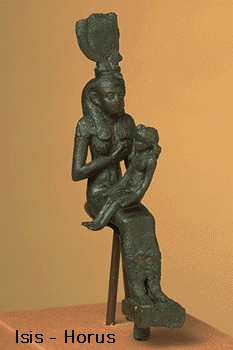
An alabaster statuette in the Brooklyn Museum depicts a young Pepi II, in full kingly regalia, sitting on the lap of his mother. Despite his long reign, this piece is one of only three 3D representations (i.e. statuary) in existence of this particular king. She may have been helped in turn by her brother Djau, who was a vizier under the previous king.
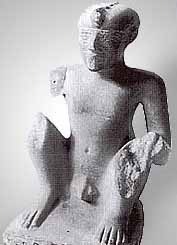
Another statue, shows Pepi II as a naked child.
A glimpse of the personality of the early child king can be found in a letter he wrote to Harkhuf, a governor of Aswan and the head of one of the expeditions he sent into Nubia. Sent to trade and collect ivory, ebony and other precious items, he captured a pygmy. News of this reached the royal court, and an excited young king sent word back to Harkhuf that he would be greatly rewarded if the pygmy were brought back alive, likely to serve as an entertainer for the court. This letter was preserved as a lengthy inscription on Harkhuf's tomb, and has been called the first travelogue.
Wives
Over his long life Pepi II had several wives, thought to include Neith (A), Iput II, Ankhenespepy III, Ankhenespepy IV, and Udjebten. Following a long tradition of royal incestuous marriage, Nieth was Pepi II's half-sister (daughter of Ankhnesmerire I) and Iput was his niece (a daughter of his brother Merenre). Of these queens, Neith, Iput, and Udjebten each had their own minor pyramids and mortuary templates as part of the king's own pyramid complex in Saqqara.
Foreign Relations
It is thought that Pepi II carried on in the tradition of his predecessors and continued with existing foreign relations, and possibly expanding further trade links into southern Africa. Copper and turquoise mining were undertaken at Wadi Maghara, and alabaster was quarried from Hatnub, both in the Sinai. There is at least one trade expedition to Punt recorded. Diplomatic records also exist of missions to Byblos in ancient Palestine.
Pepi II is thought to have taken a policy of pacification in Nubia, with Harkhuf making at least two further expeditions into the area. Over time it appears as though relations grew strained, for while Harkhuf managed to return safely from each of his expeditions, one of his successors was not so lucky.
There were also military forays into adjacent lands, but it is noted that there was an increasing reliance upon Libyan and Nubian mercenaries. Further possible evidence of a relative lack of success in these ventures comes from the fact that a scene from the king's pyramid, depicting him as a Sphinx trampling his enemies - including a Libyan chieftain and his family - is wholly derivative from the mortuary complex of previous pharaoh Sahure, which calls into question the veracity of the events supposedly being depicted.It is also known that near the end of his reign, some foreign relations were completely broken off, a further sign of the disintegration of central rule.
The Decline of the Old Kingdom
The decline of the Old Kingdom arguably began before the time of Pepi II, with nomarchs (regional representatives of the king) becoming more and more powerful and exerting greater influence. Pepi I for example, married two sisters who were the daughters of a nomarch. That king later made their brother a vizier. Their influence was extensive, both sisters bearing sons who were chosen as part of the royal succession: Merenre and Pepi II.
Increasing wealth and power appears to have been handed over to high officials during Pepi II's reign. Large and expensive tombs appear at many of the major nomes of Egypt, building by the reigning nomarchs, the priestly class and other administrators. Nomarchs were traditionally free from taxation and their positions became hereditary. Their increasing wealth and independence led to a corresponding shift in power away from the central royal court to the regional nomarchs.
Later in his reign it is known that Pepi divided the role of vizier into two: one for Upper Egypt and one for Lower, a further decentralization of power away from the royal capital of Memphis. Further, the seat of vizier of Upper Egypt was moved several times. The southern vizier was stationed at Thebes.
It is also thought that Pepi II's extraordinarily long reign may have been a contributing factor to the general breakdown of centralized royal rule. While there are some doubts that he reigned as long as 94 years (some scholars such as Von Beckerath believe this to be a misreading of long-lost original texts by early historians such as Manetho, and ascribe him a seemingly more realistic figure of 64 years, which seems more feasible if he was succeeded by his son as Egyptian tradition states, rather than a grandson), most believe that his reign was unusually long.
This almost certainly produced a succession crisis and also led to a stagnation of the central administration. A better documented example of this type of problem can be found in the long reign of much later Nineteenth Dynasty pharaoh Ramesses II and his successors. It should be stressed that Pepi II's highest date is the "Year after the 31st Count, 1st Month of Shemu, day 20" from Hatnub graffito No.7, according to Spalinger.
This date would be equivalent to only Pepi II's Year 62 (on the biennial dating system) and conforms well with the suggestion of a 64 Year reign for him given the noticeable absence of known dates for Pepi II from his 33rd to 47th Count. (a previous suggestion that the Year of the 33rd Count occurs for Pepi II in a royal decree for the mortuary cult of Queen Udjebten was withdrawn by Hans Goedicke in 1988 in favour of a more probable reading of the Year of the 24th Count instead.)
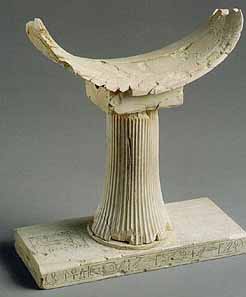
Scene From Pepi's Valley Temple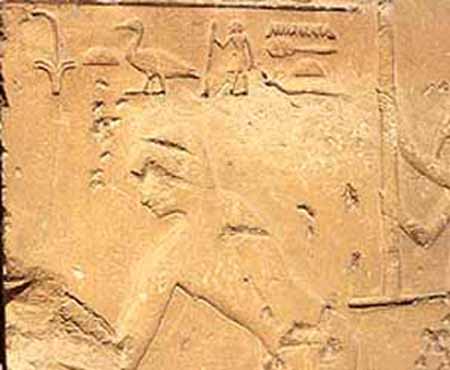
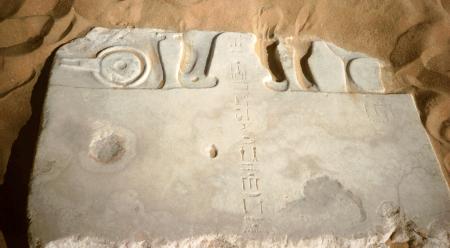
The South Saqqara Mound Mystery
Pepi II's pyramid complex (originally known as Pepi's Life is Enduring) is located in Saqqara, close to many other Old Kingdom pharaohs. His pyramid is a modest affair compared to the great pyramid builders of the Fourth Dynasty, but was comparable to earlier pharaohs from his own dynasty. It was originally 78.5 metres high, but erosion and relatively poor construction has reduced it 52 metres.
The pyramid was the center of a sizable funerary complex, complete with a separate mortuary complex, a small, eastern satellite pyramid. This was flanked by two of his wives' pyramids to the north and north-west (Neith (A) and Iput II respectively), and one to the south-east (Udjebten), each with their own mortuary complexes. Perhaps reflecting the decline at the end of his rule, the fourth wife, Ankhenespepy IV was not given her own pyramid but was instead buried in a store room of the Iput's mortuary chapel. Similarly, Prince Ptahshepses, who likely died near the end of Pepy II's reign, was buried in the funerary complex of a previous pharaoh, Unas, within a "recycled" sarcophagus dating to the Fourth Dynasty.
The ceiling of the burial chamber is decorated with stars, and the walls are lined with passages from the Pyramid texts. An empty black sarcophagus bearing the names and titles of Pepi II was discovered inside.
Following in the tradition of the final pharaoh of the Fifth Dynasty, Unas and of his more immediate predecessors Teti, Pepi I and Merenre, the interior of Pepi II's pyramid is decorated with what has become known as the pyramid texts, magical spells designed to protect the dead. Well over 800 individual texts (known as "utterances") are known to exist, and Pepi II's contains 675 such utterances, the most in any one place.
It is thought that this pyramid complex was completed no later than the thirtieth year of Pepi II's reign. No notable funerary constructions of note happened again for at least 30, and possibly as long as 60 years, due indirectly to the king's incredibly long reign. This meant there was a significant generational break for the trained stonecutters, masons, and engineers who had no major state project to work on and to pass along their practical skills. This may help explain why no major pyramid projects were undertaken by the subsequent regional kings of Herakleopolis during the First Intermediate Period.
The complex was first investigated by John Shae Perring, but it was Gaston Maspero who entered it first in 1881. Gustav Jequier investigated in detail between 1926 and 1932.
Successors
There are no official contemporary records or inscriptions of Pepi's immediate successors, and for this reason in many books Pepi II is typically credited as being the last verifiable pharaoh of the Sixth Dynasty and of the Old Kingdom.
However, according the Manetho and the Turin King List, he was succeeded by his son Merenre II, who reigned for just over a year. He in turn may have been succeeded by Nitocris, who was likely Merenre II's sister as well as wife. If she did in fact rule, she would be the first female ruler of Egypt. According to the story as told by Manetho, Merenre II was assassinated, and Nitocris saw to it that his murderers were punished prior to committing suicide. There is now considerable doubt in the academic community as to whether she in fact existed, given the paucity of physical evidence in such things as the various Kings Lists attesting to her rule.
This was the end of the Old Kingdom of Egypt, a prelude to the roughly 200-year span of Egyptian history known as the First Intermediate Period.
Reference: Dodson, Aidan. Hilton, Dyan. 2004. The Complete Royal Families of Ancient Egypt
Pepi II is followed in the king-lists by Merenre II, sometimes also called Nemtimsaf II. If the name of Nemtimsaf II was indeed Merenre, this would make him indistinguishable from Merenre I, so it is generally believed that the name Merenre has been given to Nemtimsaf II by mistake.
Merenre II is only known through king-lists, among which the Turin King-list, that credits him with a reign of slightly more than 1 year. He is assumed to have been a son of Pepi II. He was perhaps married to Nitocris, who may have been his sister.
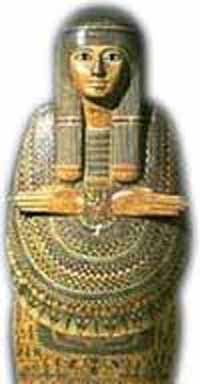
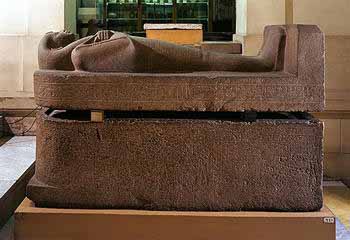
Nitocris has been claimed to have been the last pharaoh of the Sixth Dynasty. Her name is found in the Histories of Herodotus and writings of Manetho but her historicity is questionable.
According to Herodotus (Histories ii), she invited the murderers of her brother, the "king of Egypt", to a banquet, then killed them by flooding the sealed room with the Nile. Then, to avoid the other conspirators, she committed suicide (possibly by running into a burning room).
Manetho claims she built the "third pyramid" at Giza, which is attributed by modern historians and archaeologists to Menkaure. Herodotus also has a Babylonian queen of the same name and talks of her constructions in Babylon, mainly connected with diverting the Euphrates. His story about her tomb and the inscription on it which fooled Darius into opening it, only to have another inscription on the inside that chastised the opener for being so greedy is an early example of a familiar cultural meme.
Nitocris is not mentioned, however, in any native Egyptian inscriptions and "she" probably did not exist. It was long claimed that Nitocris appears on a fragment of the Turin King List, dated to the Nineteenth Dynasty, under the Egyptian name of Nitiqreti. The fragment where this name appears was thought to belong to the Sixth Dynasty portion of the king list, thus appearing to confirm both Herodotus and Manetho.
However, microscopic analysis of the Turin King List suggests the fragment was misplaced in reassembling the fragmentary text, and that the name Nitiqreti"is in fact a faulty transcription of the praenomen of a clearly male king Netjerkare Siptah I, who is named on the Abydos King List as the successor of the Sixth Dynasty king Nemtyemsaf II. On the Abydos King List, Netjerkare Siptah is placed in the equivalent spot that Neitiqreti Siptah holds on the Turin King List.
First Intermediate Period - c.2181 - 2040 BC
Dynasties 7-10
The First Intermediate Period is the name conventionally given by Egyptologists to that period in Ancient Egyptian history between the end of the Old Kingdom and the advent of the Middle Kingdom. As such, depending on when individual historians place the 'downfall' of the Old Kingdom - with the end of either the Sixth or the Eighth Dynasties - the First Intermediate Period (sometimes abbreviated as "FIP") can be considered to embrace the Seventh, Eighth, Ninth, Tenth, and most of the Eleventh Dynasties.
The Old Kingdom was weakened by famine and weak leadership. One theory holds that a sudden, unanticipated, catastrophic reduction in the Nile floods over two or three decades, caused by a global climatic cooling, reduced the amount of rainfall in Egypt, Ethiopia, and East Africa, contributing to the great famine and subsequent downfall of the Old Kingdom.
The last pharaoh of the Sixth Dynasty was Pepi II (or possibly Nitocris). He was 6 when he ascended the throne and believed to have been 100 years old when he died, for a reign of 94 years, longer than any monarch in history. The latter years of his reign were marked by inefficiency because of Pepi's advanced age. A dark time marked by unrest followed.
The Union of the Two Kingdoms fell apart and regional leaders had to cope with the famine.Around 2160 BC a new line of pharaohs (the Ninth and Tenth Dynasties) consolidated Lower Egypt from their capital in Herakleopolis Magna, descended from a pharaoh named Akhtoy.
In the meantime, however, a rival line (the Eleventh Dynasty) based at Thebes reunited Upper Egypt and a clash between the two rival dynasties was inevitable.Around 2055 BC a descendant of Inyotef defeated the Heracleopolitan Pharaohs, reunited the Two Lands, and ruled as Mentuhotep II thereby ending the First Intermediate Period.
There are various accounts of what happened in Egypt after Pepi II died. People sought stability, but things continued in turmoil. Pepi ll's long reign had weakened central government, as the nomarchs (local governors) increasingly began to assert their independence from Pharaoh. Any nominal authority exerted by central government disappeared, as the nomarchs jostled for position, attempting to found their own dynasties.
There was a downside to the technological progress made during the Old Kingdom. Feats of engineering like the Sphinx and the pyramids at Giza had made the Egyptians complacent. This feeling of invincibility was exacerbated by the position of their country, hidden as it was in the fertile Nile Valley.
A word encapsulated how Egyptians felt about their civilization - 'Ma'at' meaning 'Stability' or 'Balance'.
Papyri dating from the Middle Kingdom show this breakdown very clearly. Due to the unstable nature of this period, no firm historical records survive from the First Intermediate Period.
There are some sources that mention a seventh dynasty which had 70 kings and which reigned for a total of 70 days. These are apocryphal, but nevertheless show how much the system had broken down.
We can place an eighth dynasty, which was possibly descended in some way from Pepi II and which ruled from Memphis, but we must assume that any influence they exerted was confined to the area immediately around Memphis, as the Nile Delta has been invaded by "asiatics" (the name given by Egyptians to people from what we now call the Middle East).
The kings of the eighth dynasty are somewhat ephemeral, but we know of 2 possible ones - Wajdkare and Qakare Iby.
After perhaps between 20 and 30 years, the eighth dynasty fell and the nomarchs once again jostled for supreme power. We now see the emergence of a ninth dynasty, ruling from Herakleopolis, perhaps founded by one Meryibre Khety.
Both this dynasty and its Herakleopolitain successor, the tenth dynasty, seem to have been highly unstable, with frequent changes of ruler.
Both this dynasty and its Herakleopolitain successor, the tenth dynasty, seem to have been highly unstable, with frequent changes of ruler.
Running concurrent to the tenth dynasty, another dynasty was being established in Thebes (the eleventh dynasty). Founded by Intef I in c. 2134 BC, the first 3 kings of DXI (all called Intef and buried in an area called Dra Abu el-Naga, near to what would later become the Valley of the Kings) fought an ongoing conflict with the Herakleopolitain DX monarchs, with requent clashes in the area around Abydos, where their two spheres of influence met.
- Journal of the Society for the Study of Egyptian Antiquities
The only direct evidence for the existence of a Seventh and Eighth Dynasty in Egyptian history appears in two inconsistent, badly garbled, and heavily redacted copies of Manetho¼s history of Egypt. One copy was prepared by Africanus in the third century and the other by Eusebius in the fourth century. According to Africanus, the Seventh Dynasty consisted of seventy kings of Memphis, who reigned for 70 days" and the Eighth Dynasty consisted of „twenty-seven kings of Memphis, who reigned for 146 years.
Eusebius has a slightly different account. He has a Seventh Dynasty that consisted of five kings of Memphis, who reigned for 75 days and an Eighth Dynasty that consisted of five kings of Memphis, who reigned for 100 years.
These descriptions present Egyptologists with some problems. Not only does the description of the Seventh Dynasty appear to be either spurious or badly garbled, but no archaeologists would allow much more than a quarter of a century for both dynasties combined.
Adding to the difficulty is that there are three additional Egyptian king-lists that encompass this period, and while all have a different number of Memphite kings beginning with the Sixth Dynasty, none of them indicates any sort of dynastic break for a Seventh and/or Eighth Dynasty.
These two dynasties fall into Egypt's First Intermediate Period, and because of the great chaos in this time and the scarcity of records, Egyptologists generally assume that the differences among the two Manetho copies and the various king-lists simply reflect the confusion among the various scribes who attempted to recreate the political records of this earlier era.
The original authors of the king-lists, had a clear picture of the First Intermediate Period and that the differences among the king-lists reflect not confusion but political/theological alternatives. More specifically, the political/theological problem involved the determination of when Horus stopped ruling in Memphis and started ruling in Thebes.
Different cult centers, as reflected in the king-lists, had different answers. In addition, I am going to argue that the original Manetho king-list never had a Seventh and Eighth Dynasty and that what appears in the Africanus and Eusebius copies are garbled transmissions of lines of summation.
Dynasty 7 was originally a line of summation for the entire Memphite line of kings, beginning with the First Dynasty and ending with the Sixth Dynasty; Dynasty 8 was a line of summation for just the Sixth Dynasty.
There were three major political events that took place during First Intermediate Period.
One was the termination of the Memphite line of kings sometime after the start of the Sixth Dynasty.
Two was the foundation of a line of kings in Herakleopolis, which line belongs to Dyns. 9 and 10. Three was the foundation of the Eleventh Dynasty in Thebes.
There was some overlap between the last Memphite kings and the earliest Herakleopolitan kings, but where in the Memphite sequence this overlap began is not known.
There was also some overlap between the Herakleopolitans and the Eleventh Dynasty Thebans, which period lasted about 100 years, ending when Menthotpe II defeated his Herakleopolitan rival.
Whether or not there was some overlap between the kings of Memphis and the kings of Thebes is unknown.
Each of the various king-lists for this time period provides a different roster of kings and dynasties. The three earliest are the Table of Sakkara, the Table of Abydos, and the Turin Canon of Kings.
All three date to the Nineteenth Dynasty. The other relevant king-list is Manetho's, which dates to the third century B.C., about one thousand years later than the others. But his original manuscript is lost, and for the First Intermediate Period we have to rely on the badly garbled copies of Africanus and Eusebius.
The most abbreviated account of the First Intermediate Period comes from the Table of Sakkara. It ends the Sixth Dynasty after the fourth king, Phiops, and then immediately jumps to the reign of Menthotpe II, the Theban pharaoh who defeated Herakleopolis and united Egypt.
This list, therefore, omits part of the Sixth Dynasty, all of the Seventh, Eighth, Ninth, and Tenth Dynasties, and part of the Eleventh Dynasty. The period omitted comes closest to what we currently describe as the First Intermediate Period. That the Sakkara list ends the Sixth Dynasty with the reign of Phiops, who apparently ruled in excess of ninety years, provides a good clue that whatever went wrong politically began either during or immediately after the reign of this king.
The Table of Abydos presents a different perspective. Beginning with the first king of the Sixth Dynasty, it lists 22 Memphite kings, and there is no indication of any dynastic breaks anywhere in this list. The Abydos list, like the Sakkara list, omits any mention of the Herakleopolitans, and also skips the first few Theban kings, jumping directly to the reign of Menthotpe II.
The Turin Canon shows a Sixth Dynasty consisting of twelve Memphite kings, and, although the lengths of reign are badly damaged, a summation line indicates that the total duration was either 181 or 187 years.
There is no indication therein of a Seventh or Eighth Dynasty from Memphis. (Following the Sixth Dynasty Memphite kings, the Turin Canon allows for eighteen Herakleopolitan kings, but does not divide them into two separate dynasties as Manetho does.
Many Egyptologists believe that at least one of the two Herakleopolitan dynasties, Nine or Ten, is spurious. After the Herakleopolitans, the Turin Canon lists several Eleventh Dynasty Theban kings prior to Menthotpe II.
While most Egyptologists tend to dismiss these differences as reflecting the chaotic nature of the First Intermediate Period, I suggest that a more logical interpretation is that these three king-lists each present a different political viewpoint about the legitimacy of various kings.
The Egyptians were a very conservative people and did not approve of abrupt changes in the political order. The king was thought of as a human aspect of the god Horus, and a challenge to the legitimate king was the equivalent of a challenge to the god Horus. During the First Intermediate Period, however, there were three rival kingdoms, Memphis, Thebes, and Herakleopolis.
Only one could be the legitimate center of power. Horus could only rule from one throne.
The central theological problem of the First Intermediate Period, then, was "When did Horus stop ruling in Memphis and when did he begin to rule from another city?"
The three king-lists, I suggest, each show a different political interpretation.
The Sakkara list represents a 'plague on all your houses' point of view. Implying that the outbreak of troubles began either during or immediately after the reign of Phiops, the fourth king of the Sixth Dynasty, the Sakkara scribe refuses to recognize any legitimate authority until Menthotpe II reunites Egypt. The list omits the entire period in which there were competing claims.
The Abydos list presents a very different perspective, that of the Memphite loyalist. What we see reflected here is a hard core support for the Memphite throne, complete rejection of the Herakleopolitan claims, and some distaste for the Theban upstarts.
It is only after the Memphite throne has ceased to exist and Menthotpe II has reunited Egypt that the Abydos scribe confers legitimacy on the Theban monarchy. If any Theban kings ruled between the time that the Memphite line ended and Menthotpe II reunited Egypt, the Abydos scribe refuses to recognize their legitimacy.
A still different set of values is reflected in the Turin Canon of Kings. The Turin Canon is a Theban document, written by a Theban scribe during a Theban administration. It presents a Theban political viewpoint.
Because it is Theban, it begins the Eleventh Dynasty with the founders of the Theban line rather than with the later reign of Menthotpe II. But the Thebans can not allow a document to show Memphite kings on the throne at the same time as Theban kings. This would be sacrilege, an affront to Horus in Memphis.
This raises the question of whether the Memphite line ended before Thebes came to the throne or after. The Turin Canon, however, only has twelve kings listed where the Abydos list has twenty-two. Since Thebes had an interest in showing a smooth transition from Memphis to Thebes, with no gaps, I suggest that the Turin Canon¼s Sixth Dynasty ended at exactly the point where it began the Eleventh Dynasty and that the Thebans deliberately omitted the last ten Memphite kings in order to avoid any appearance of conflict.
On the other hand, the Turin Canon does show a line of Herakleopolitan kings. This is politically significant. Theban authority stems from its defeat of the Herakleopolitan kings. Therefore the Herakleopolitan kings need to be mentioned. But the inclusion of the Herakleopolitan kings also serves to remind Egyptians that the Memphites couldn¼t defeat the Herakleopolitans, and that Horus must have abandoned Memphis in favor of those kings who did defeat the Herakleopolitans.
Before turning to Manetho¼s Seventh and Eighth Dynasties, one more observation about the king-lists is in order. Manetho and the Table of Sakkara both make Phiops the fourth king of the Sixth Dynasty.
The Turin Canon and the Table of Abydos make him the fifth king. The latter two lists place an additional king between Manetho's first and second king. This king appears to be named Usarkare and he is documented in the archaeological record, but his reign seems to have been relatively brief.
This suggests that Manetho and the Table of Sakkara both omitted Usarkare from the sequence of Memphite kings. Therefore, if Manetho originally had intended to include a complete list of Memphite kings in his chronology, he would have had only 21 kings, instead of the 22 in the Table of Abydos. This figure of '21' is significant in our reconstruction of Manetho.
Article with Table - Continued
The way I see it, it's all based on mathematics. The names and exact dates are not as important as the metaphors and the geometry.
2152 - 2130
Netrikare
Menkare
Neferkare II
Neferkare III
Djedkare II
Neferkare IV
Merenhor
Menkamin I
Nikare
Neferkare V
Neferkahor
Neferkare VI
Neferkamin II
Ibi I
Neferkaure
Neferkauhor
Neferirkare II
Attested Kings about whom nothing more is known:
Wadjkare - "Prosperous is the Soul of Re"
Sekhemkare
Iti
Imhotep
Isu
Iytenu
Neferkare
Mery-ib-re Khety - dates uncertain - "Beloved is the Heart of Re"
Mery-ka-re - dates uncertain - "Beloved is the Soul of Re"
Ka-nefer-re - dates uncertain - "Beautiful is the Soul of Re"
Neb-kau-re Akh-toy - dates uncertain - "Golden are the Souls of Re"
This dynasty was also known as the Herakleopolis Dynasty because the rulers controlled lower Egypt from Herakleopolis. This dynasty is also often called the "House of Khety" because many of the ruler's names were Khety, but it is considered to be fairly unstable due to frequent changes in rulers. The Herakleopolitans expelled Asiatic immigrants from the Nile delta and fortified the eastern border of Egypt. This dynasty was responsible for establishing the importance of Memphis.
The Herakleopolitans improved irrigation works, reopened trade with Byblos, and began the "Coffin Texts". One of the kings wrote the "Instruction to Merikara." They also had frequent outbreaks of fighting against the Thebans north of Abydos. Eventually they were conquered by the Thebans and this marked the end of the Herakleopolis Dynasty and the beginning of the Middle Kingdom.
The only person from this era to have left an impression on posterity is a woman called Nitokris who appears to have acted as king. There are no contemporary records but Herodotus wrote of her:
She killed hundreds of Egyptians to avenge the king, her brother, whom his subjects had killed, and had forced her to succeed. She did this by constructing a huge underground chamber. Then invited to a banquet all those she knew to be responsible for her brother's death. When the banquet was underway, she let the river in on them, through a concealed pipe. After this fearful revenge, she flung herself into a room filled with embers, to escape her punishment."For a time petty warlords ruled the provinces. Then from the city of Herakleopolis there emerged a ruling family led by one Khety who for a time held sway over the whole country. However, this was short lived and the country split into two, the north ruled from Herakleopolis and the south ruled from Thebes.
Whereas the Theban dynasty was stable, kings succeeded one another rapidly at Herakleopolis. There was continual conflict between the two lands which was resolved in the 11th dynasty.
King Ouakha-Re KHETY III (2110to 2075 BC) taught his son, the future king MERIKARE of the 10th dynasty (2075 to 2060BC), thus : (Papyrus of the Hermitage Museum - N0. 1115 at Copenhagen.)
"Life on earth passes quickly, and happy are those without sin, because a million men will serve as nothing to the king of heaven and earth when they appear as sinners in the next life. The memory of the good man will live for ever. The essence of life is in the word of the ancestors; it is contained in books. Open and read them.Practice justice as long as you are on earth, Comfort those that cry, do not oppress the widow and the orphan. (sentences that the Bible repeats often.)
God knows the treacherous and paid for their sins in His blood... Go down the difficult path, because the soul of the man is drawn to the place that it knows, does not depart from the way of truth; and no-one can prevent it!
Know that the judges in the courthouse of the next world will examine a life as if it were only an hour. Happy is the one that reaches the next life : he will be like a god, he will move freely like the masters of eternity, because there is no-one who can oppose the CREATOR, who is omnipresent and omniscient. Honor your invisible God on your way, practice truth and justice,
Act for God so that he can do the same for you. After having punished men (in the deluge?), his light (Re) again shines in the sky, so that men may see it.
These sublime words were written toward 2080BC, within one or two hundred years of the birth in UR in the Chaldees of a young man called Abraham."
11th Dynasty (Thebes Only)
Mentuhotep I was a local Egyptian ruler at Thebes during the First Intermediate Period. He founded the Eleventh dynasty which eventually reunited Egypt under the Middle Kingdom. He is associated with Mentuhotep II. It is commonly thought that the two rulers were one and the same.
Antef I was the son of a local ruler of Thebes named Mentuhotep I. He was the first Theban ruler to have proclaimed himself king, assuming a Horus-name and writing his personal name in a cartouche. He thus opposed the kings of the 9/10th Dynasty of Heracleopolis and started a civil war.
That a local ruler of a relatively small city was able to oppose the ruling dynasty can be explained by the strong decentralisation of the Ancient Egyptian government, which, in turn, may have been the result of the low inundation of the Nile at the end of the Old Kingdom. He conquered some of the cities to the north of Thebes, among them Koptos and Dendara. To the south, he extended his reign to Elkab.
He was buried in a long, narrow rock-tomb on the West-bank of Thebes.
Antef II - Inyotef Il - Intef ll - 2118-2069 BC
During the reign of Antef II, which, according to the Turin King-list lasted for as long as 49 years, the kings of the 9/10th Dynasty tried to re-conquer the territory they had previously lost to Antef I, in an attempt to establish their rule over the whole of Egypt.
Antef II, however, succeeded not only in warding off the Heracleopolitan attacks, but also in conquering even more of their territory: Abydos, Akhmim and Kaw el-Kabir. In the south, he extended the Theban rule to the First Cataract, the traditional southern border of Ancient Egypt.
Antef II was buried in a rock-tomb next to his predecessor's. This tomb is known from the representation of the king's dogs, which had foreign names. The tomb is also mentioned in the texts from the end of the New Kingdom about the tomb robberies of that era.
Little is known about the reign of Antef III. The Turin King-list credits him with a reign of at least 8 years. He was the father of Mentuhotep II, who would re-unite Egypt under one rule. It does not appear that this king gained or lost territory to the kings of the 9/10th Dynasty.
He was buried in a narrow rock-tomb next to Antef II.
MIDDLE KINGDOM BEGINS - ALL OF EGYPT
The Middle Kingdom is a period in the history of ancient Egypt stretching from the establishment of the Eleventh Dynasty to the end of the Fourteenth Dynasty, roughly between 1991 BC and 1648 BC.
The Middle Kingdom has been usually dated to the time when Pharaoh Mentuhotep II from Thebes defeated the last king of the Tenth Dynasty around the 14th Year of his reign to reunite Egypt thus bringing an end to the First Intermediate Period. Some authorities point to cultural differences between the Eleventh and Twelfth Dynasties, and date the Middle Kingdom to the beginning of that dynasty.
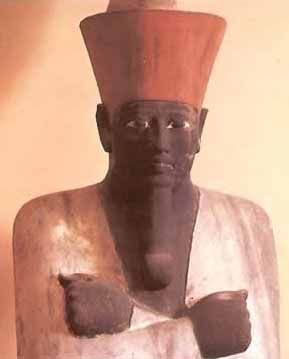
He was the first ruler of the Middle Kingdom.
His throne name was Neb-hetep-re, meaning "Pleased is the Lord Re".
Mentuhotep II was the son of the Theban ruler Antef III and a woman named Iah. When he came to power, his predecessors had already conquered a territory that stretched far beyond Thebes, from the 1st cataract in the south, to the region of Qaw el-Kabir in the north.
The Turin King-lists credits this king with a reign of as much as 51 years. In light of the many events that occurred during his reign, this is not unlikely.
Mentuhotep II was responsible for the reunification of Egypt.
His achievements can be reviewed by looking at how his Horus name changed during his rule. He started off calling himself "He who gives heart to the Two Lands", and then moved on to "Lord of the White Crown" (the White Crown being symbolic of Upper Egypt). Finally, he became known as "Uniter of the Two Lands".
The first years of his reign have left us with only few testimonies. This could mean that he reached the throne at a young age, something that is also suggested by the long duration of his reign. His 14th regnal year was apparently a turning-point in the life of Mentuhotep. Its name "year of the crime of Thinis" suggests that there was some trouble in the Thinite province, where the age-old holy city of Abydos was located. Apparently the Heracleopolitan king Kheti of the 9/10th Dynasty had succeeded in re-conquering this province and was threatening to do the same with the rest of Upper-Egypt. During this re-conquest, a large part of the old necropolis of Abydos was destroyed.
Mentuhotep immediately reacted and not only repelled the Heracleopolitans from Abydos, he also continued the war against them, conquering Assiut, Middle-Egypt and finally Heracleopolis itself. With the fall of the Heracleopolitan Dynasty, nothing stood in the way for the final re-unification of Egypt under Theban rule.
At the latest by his 39th year, but presumably somewhere around his 30th year, Egypt was united again and Mentuhotep II was the first Theban who could rightfully call himself King of Upper- and Lower-Egypt thus ushering in the Middle Kingdom.
Mentuhotep's military efforts were not only aimed at reuniting the Two Lands. Inscriptions in Nubia show his desire to re-establish the Egyptian supremacy over this region. A mass-tomb found in Deir el-Bahari contained 60 bodies of slain Egyptian soldiers who perhaps lost their lives in Nubia. That these soldiers were given a burial so near the king's own funerary monument, demonstrates how much importance was attached to them.
Even during the re-conquest of Egypt, Mentuhotep built or restored several temples throughout his territory. He was particularly active in Upper-Egypt as is shown by monuments in Dendara, Abydos, Elkab and Elephantine. The warrior-king paid special homage to the war-god Montu, who, at that time, was the principal god of the Theban province. For him he built temples in Medamud, Armant and Tod.
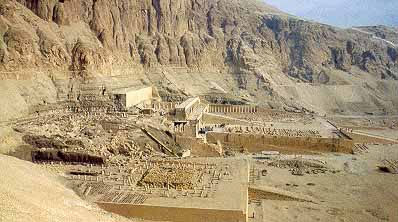
A view on the remains of Mentuhotep's funerary temple (foreground). The larger building in the background is Hatshepsut's temple, the design of which was largely based on Mentuhotep's.
The most famous monument built by Mentuhotep II was his funerary monument. Unlike his predecessors, who were buried in relatively simple tombs in Dra Abu el-Naga', Mentuhotep chose to build his mortuary temple and tomb at Deir el-Bahari. The design of this building was unique: a terrace was built against the cliffs of Deir el-Bahari. Upon the roof of that terrace was built a massive stone construction, identified by some archaeologists as a pyramid, by others as a mastaba. The tomb of the king was located in the rock behind and underneath the temple.
Mentuhotep III was the son and successor of Mentuhotep II. He is attested as "eldest son of the king" in his father's mortuary temple in Deir el-Bahari.
Because of his father's long reign, he may already have been relatively old by the time he reached the throne. The Turin King-list has recorded 12 years for this king.
After the military reign of his father, Mentuhotep III's reign was peaceful. The king's main concern was no longer the conquest of new territory, but the protection of Egypt against foreign states and roaming Bedouin. The cult for this Mentuhotep in the eastern Delta is probably related to his policy to fortify the north-eastern border against the Asian nomads.
The most important event during this king's reign was an expedition, led by a man named Henenu, through the Wadi Hammamat to the Red Sea and from there to the legendary land of Punt, from where many exotic products and incense were brought to Egypt.
Despite its relatively short duration, this reign has produced several temples throughout Upper-Egypt, from the southern most border in Elephantine, over Elkab, Tod and Armant to Abydos, as evidenced by a relief found in Armant.
A tomb was apparently started for this king, near Deir el-Bahari, but it was left unfinished.
Mentuhotep IV was the last king of the 11th Dynasty. He was the son of a woman named Imi, who was a secondary wife of either Mentuhotep II or Mentuhotep III.
This Mentuhotep is missing in most king-lists. The Turin-king-list merely notes 7 missing years at the end of this dynasty, just after the reign of Mentuhotep III. This probably refers to a gap in the documentation of about 7 years, which may have been filled by Nebtawire's reign. An offering table found in Karnak mentions the "Father of the God" Sesostris, the father of Amenemhat I, the founder of the next dynasty, in his place.
Either Mentuhotep IV was considered as an usurper, or the kings of the 12th Dynasty decided to re-write history to justify their claims to the throne. That he was not recognised as the legitimate king of the country may perhaps be supported by the many opponents to his reign: Antef, who may have been a member of the royal family, Iy-ib-khent-re and Segerseni all assumed royal titulary, thereby stating that they had more rights to the throne.
During the second year of his reign, he organised an expedition to the quarries of the Wadi Hammamat, located to the north-east of Thebes, between Koptos and the Red Sea. The 19 inscriptions left behind there by the members of the expedition are the only testimony to this Mentuhotep's reign.
The expedition was led by a vizier named Amenemhat, who is assumed by most Egyptologists to have been the later king Amenemhat I. A stone plate found at Lisht, bearing both the names of Mentuhotep IV and of king Amenemhat I may perhaps indicate that Amenemhat I was a co-regent during the later years of Mentuhotep's reign. This in turn could perhaps indicate that Mentuhotep IV had intended Amenemhat to be his successor.
TWELFTH DYNASTY - (1937-1759 BC)
According to Manetho, the 12th Dynasty comprised seven kings from Thebes, who ruled for a total of 160 years in the version of Africanus, and for 245 years in the version of Eusebius. Oddly enough, this does not include the founder of the dynasty, Amenemhat I, who is added in succession to the kings of the 11th Dynasty.
In the Turin King-list, the dynasty started with Amenemhat I and consisted of 8 kings who ruled for a total of 213 years, 1 month and 17 days. All kings listed in the Turin King-list are also attested by contemporary sources and monuments.
The circumstances into which the 12th Dynasty came to power are not known. What is known is that Amenemhat I was not related to his predecessors. His father was a priest in Thebes named Senuseret. His mother was named Nefret and, according to the Prophecy of Neferti, came from Elephantine in the South of Egypt.
It is possible that Amenemhat was the vizier of Mentuhotep IV, the last king of the 11th Dynasty. A stone plate found at Lisht, bearing both the names of Mentuhotep IV and of king Amenemhat I may perhaps indicate that Amenemhat I was a co-regent during the later years of Mentuhotep's reign. This could perhaps indicate that Mentuhotep IV had intended Amenemhat to be his successor.
With the 12th Dynasty, a local god of obscure origin, Amun, would become the most important god of the Ancient Egyptian pantheon. The popularity of Amun is closely linked to the origin of Amenemhat I, whose name, containing the element Amun, shows a particular allegiance to this god. Even when Amenemhat moved the political center of the country from Thebes to the newly built capital Itj-tawi in the Fayum oasis, located to the southwest of the old capital Memphis, Thebes would remain an important religious center. This would determine the religious and political history of Ancient Egypt for the following millennium.
The kings of the 12th Dynasty ruled the country firmly and were able to maintain the power of balance between the central authorities and the local administrations, to their own advantage. They also imposed their rule on northern Nubia and pacified the Bedouins in the deserts to the east and west of the Nile Valley. Imposing fortresses were built in Nubia and at the Eastern border, to protect trading routes from raiding Bedouins.
The wealth and stability the 12th Dynasty has brought to the country is evidenced in the high quality of statues, reliefs and paintings found throughout the country. Rather typical for this period are statues with big ears, seen by some as an indication that the king and his nobility listened to their subjects.
Deviating from the standard way of representing kings, Sesostris III and his successor Amenemhat III (see image to the left) had themselves portrayed as mature, aging men. This is often interpreted as a portrayal of the burden of power and kingship. That the change in representation was indeed ideological and should not be interpreted as the portrayal of an aging king is shown by the fact that in one single relief, Sesostris III was represented as a vigorous young man, following the centuries old tradition, and as a mature aging king.
The dynasty came to an end when Amenemhat IV appears to have died without male heirs and he was succeeded by his sister/wife Nefrusobek.
Reference: Monarchs of the Nile Aidan Dodson, 1995
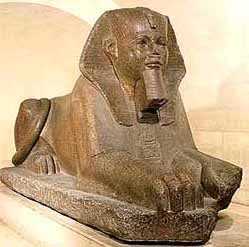
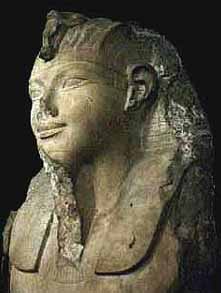
Amenemhat I was the first ruler of the 12th Dynasty.
Some Egyptologists believe that recovery from the First Intermediate Period into the Middle Kingdom only really began with his rule. He was probably not of royal blood, at least if he is the same Vizier that functioned under his predecessor, Mentuhotep IV. Perhaps either Mentuhotep IV had no heir, or he was simply a weak leader. This vizier, named Amenemhet, recorded an inscription when Mentuhotep IV sent him to Wadi Hammamt. The inscription records two omens. The first tells us of a gazelle that gave birth to her calf atop the stone that had been chosen for the lid of the King's sarcophagus. The second was of a ferocious rainstorm that, when subsided, disclosed a well 10 cubits square and full of water. Of course that was a very good omen in this barren landscape.
Many Egyptologists believe that Amenemhet's inscription implies that a great ruler will come to the throne of Egypt upon the death of Mentuhotep IV, who will lead the country into prosperity.
It is fairly certain that Amenemhet the vizier was predicting his own rise to the throne as Amenemhet I. However, we are told that he had at least two other competitors to the throne. One was called Inyotef, and the other a Segerseni from Nubia. It would appear that he quickly dealt with these obstacles. We believe that he ruled Egypt for almost 30 years. Peter A. Clayton places his reign between the years of 1991 and 1962 BC while the Oxford History of Ancient Egypt gives him a reign lasting from 1985 through 1956 BC. Dodson has his reign lasting from 1994 until 1964 BC.
Amenemhet I's Horus name, Wehem-mesut, means "he who repeats births", and almost certainly was chosen to commemorate the new dynasty and a return to the values and prosperity of a united Egypt. Amenemhet (Amenemhat) was his birth name and means "Amun is at the Head". He was called Ammenemes I by the Greeks. His throne name was Sehetep-ib-re, which means "Satisfied is the Heart of Re".
Neferu, who was the principal wife of Senwosret I, the kings mother, Nefret, and a principal wife, Nefrytatenen
Amenemhet was probably the son of a woman named Nofret (Nefret), from Elephantine near modern Aswan, and a priest called Senusret, according to an inscription at Thebes. So his origins are probably southern Egypt. We know of three possible wives including Neferytotenen (Nefrutoteen, Nefrytatenen), who may have been the mother of Amenemhet I's successor, Senusret I, Dedyet, who was may also have been his sister, and Sobek'neferu, Neferu).
It is fairly clear that Amenemhet established Egypt's first co-regency with his son, Senusret I, in about the older kings 20th year of rule. He was not only seeking to assure the succession of his proper heir, but also providing the young prince valuable training under his tutelage. Senusret was given several active roles in Amenemhet I's government, specifically including matters related to the military matters. Several pieces of literature that probably date from his reign, some of which appears to support his reign with fables of kingship. One, the Discourse of Neferty, has a ruler emerging named Ameny, who was foretold by a prophet in the Old Kingdom (Neferty).
Neferti was a Heliopolis sage who seems familiar to us from Djedi in the Papyrus Westcar. He is summoned to the court of Snofru, during who's reign the story is suppose to have taken place. This tale has Ameny delivering Egypt from chaos, but it should be noted that it is the chaos of the late 11th Dynasty, not the First Intermediate Period.
Then a king will come from the South, Ameny, the justified, my name, Son of a woman of Ta-Seti, child of Upper Egypt, He will take the white crown, he willjoin the Two Mighty Ones (the two crowns)
Asiatics will fall to his sword,
Libyans will fall to his flame,
Rebels to his wrath, traitors to his might,
As the serpent on his brow subdues the rebels for him,
One will build the Walls-of-the-Ruler,
To bar Asiatics from entering Egypt...
We do not know what year this literature dates to within Amenemhet I's reign. But while there are other text that refer to the chaos before the arrival of new kings, the references to Asiatics and the Walls-of-the-Ruler are new.
Amenemhet I set about consolidating the country in a very purposeful manner. He moved his capital north to the capital he apparently established named Amenemhet-itj-tawy, which means, "Amenemhet the Seizer of the Two lands". It was located south of Memphis, on the edge of the Fayoum Oasis, though the city ruins have not yet been discovered. This gave him a more central control of Egypt, as well as placing him nearer to problem areas in the Delta. It also signaled the end of an old era and new beginnings. This move was perhaps only carried out a short time after he took the throne.
Many Egyptologists believe that the move was made at the very beginning of his reign, while a few believe it may have been much later, around the time of his twentieth year as ruler. However, he did begin a tomb at Thebes, and then abandoned it for a pyramid at el-Lisht, near the new capital. It appears that the work on the tomb at Thebes may have taken between three and five years to complete. Also, there are very few of his monuments located near Thebes, suggesting that he soon moved away.
His pyramid at el Lisht is instructional, for it seems to portray a return to some of the values of the Old Kingdom, while still embracing the Theban concepts of the region of his birth. Egyptologists who believe Amenemhet I may have waited until his twentieth year to make the move to his new city base their evidence on an inscription found on the foundation blocks of the pyramid's mortuary temple. It records Amenemhet's royal jubilee, and also that year one of a new king had elapsed, suggesting that the pyramid was started very late in the king's reign. Therefore, considerable debate remains over the timing of his move.
He also reorganized the administration of the country, keeping the nomarchs who had supported him, while weakening the regional governors by appointing new officials at Asyut, Cusae and Elephantine. An inscription records that he also divided the nomes (provinces) into different sets of towns and redistributed the territories by reference to the Nile flood. We see a steady march during Amenemhet I's rule back to a more centralized government, together with an increase in bureaucracy. Another move, both to dilute the army's power and to raise personnel for coming conflicts, was his reintroduction of conscription.
Undoubtedly, in the Discourse of Neferty, Asiatics refer to the people who were causing trouble on the Egypt's eastern frontier. One of Amenemhet I's earliest campaigns were against these Asiatics, though the scale of these operations is unknown. He drove these people back, and indeed did build the Walls-of-the-Ruler, as series of fortifications along Egypt's northeastern frontier. However, even as late as his 24th year of rule, we still find inscriptions recording expeditions against these "and-dweller". None of these fortifications has ever been found, though the remains of a canal in the region may date from the period. Apparently, in the midst of the Asiatic campaign, he also found time to crush a few unrepentant local governors (nomarchs).
In Nubia, Amenemhet I first pushed his army southward to Elephantine, where he consolidated his rule and seems to have been satisfied for a number of years. This expedition was apparently lead by Khnemhotpe I, governor of the Oryx nome, who traveled up the Nile with 20 boats. But by year 29 of his rule, the king appears to have no longer been happy with the lose trading and quarrying network with Nubia that we find in the Old Kingdom.
The new policy was one of conquest and colonization with the principle aim of obtaining raw materials, especially gold. An inscription at the northern Nubian site of Korosko about half way between the first and second cataracts (rapids) states that the people of Wawat (northern Nubia) were defeated in his 29th year, and he apparently drove his army as far south as the second cataract.
In order to protect Egypt and fortify captured territory in Nubia, he founded a fortress at Semna and Quban in the region of the second Nile Cataract, which would begin a string of future 12th Dynasty fortresses. Along with protecting his newly acquired territory and the gold mines in Wadi Allaqi, he also created a stranglehold over economic contacts with Upper Nubia and further south. We also know that he constructed a fortress at Mendes named Rawaty.
From a foreign relations standpoint, we also know that diplomatic and commercial relations were renewed, after a long absence, with Byblos and the Aegean world.
Amenemhet I took part in a number of building projects. Besides his fortresses, we know he built at Babastis, el-Khatana and Tanis. He undertook important building works at Karnak, from which a few statues and granite naos survive. He may have even established the original temple of Mut to the south of the Temple of Amun.
He also worked at Koptos (Coptos), where he partly decorated the temple of Min, at Abydos, where he dedicated a granite altar to Osiris, at Dendera, where he built a granite gateway to Hathor and at Memphis, where he built a temple of Ptah. Also a little north of Tell el-Dab'a, he apparently began a small mudbrick temple at Ezbet Rushdi, that was later expanded by Senusret III.
Religiously, being from southern Egypt, Amenemhet I's allegiance was probably to the god Amun, and in fact, we find from this period forward the rise of Amun, at the expense of Montu, god of war, as the supreme deity of Thebes.
It is also notable that we find an increase in the mineral wealth of the royal family. We find a huge increase in the jewelry caches found in several 12th Dynasty royal burials. It is obvious from several sources of evidence that even the standard of living form middle class Egyptians was on the increase, though their level of wealth was proportional to their official offices.
Amenemhet I appears to have been a very wise leader, setting about to correct the problems of the First Intermediate Period, protecting Egypt's boarders from invasion and assuring a legitimate succession.
Yet he was murdered in an apparent harem plot while his co-regent was leading a campaign in Libya. Again, we find two literary works, the Tale of Sinuhe and the Instructions of Amenemhet I, reflecting this king's tragic end. One literary work from the time of Senusret I presents the account of Amenemhet I's murder, supposedly provided by the king himself from beyond the grave:
"It was after supper, when night had fallen, and I had spent an hour of happiness. I was asleep upon my bed, having become weary, and my heart had begun to follow sleep. When weapons of my counsel were wielded, I had become like a snake of the necropolis. As I came to, I awoke to fighting, and found that it was an attack of the bodyguard. If I had quickly taken weapons in my hand, I would have made the wretches retreat with a charge! But there is none mighty in the night, none who can fight alone; no success will come without a helper. Look, my injury happened while I was without you, when the entourage had not yet heard that I would hand over to you when I had not yet sat with you, that I might make counsels for you; for I did not plan it, I did not foresee it, and my heart had not taken thought of the negligence of servants."
Apparently, his foresight in creating the co-regency with his son proved successful, for Senusret I succeeded his father and their seems to have been little or no disruption in the administration of the country.
Amenemhat I was murdered. His body was buried in his pyramid at el-Lisht, near the Fayum oasis.
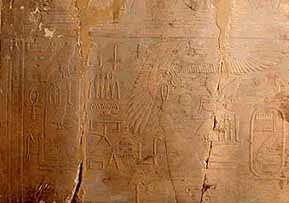
Image of Amenemhet I from his
mortuary complex at el-lisht
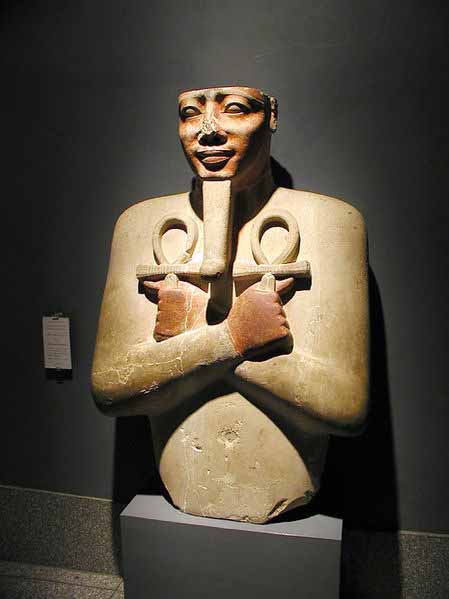
Senusret I was the second king of the 12th Dynasty.
He ascended to the throne after the murder of his father, Amenemhet I. There had apparently been a harem plot, and with good timing, Amenemhet I was assassinated in the absence of his son, who was fighting in Libya. It would seem that his son either swiftly left the campaign, or was already heading home at the time of the murder. However, this was not the first harem conspiracy, and Amenemhet I had performed his due diligence in respect to assuring a successful transition for his heir. For the first time that we know of in Egyptian history, Senusret I was made a co-regent.
Senusret I was this king's birth name, and means "Man of goddess Wosret". However, it was also the name, we believe, of his non-royal grandfather and so it may give little insight into his character. In references, he is also sometimes called Senwosret I, or Sesostris I (Greek). His throne name was Kheper-ka-re, which means, "The Soul of Re comes into Being". His mother was probably Neferytotenen (Nefrutoteen, Nefrytatenen), one of Amenemhet I's chief wives.
He married a Queen Nefru, who was the mother of his successor son, Amenemhet II. Like his father, Amenemhet II was also made a coregent, but only perhaps three years prior to Senusret I's death. The coregency was recorded by a private stele of Simontu that is now in the British Museum. From her pyramid near her father's we also know that he had a daughter (or possibly a wife) by the name of Itakaiet. He may have had other daughters, including princesses Nefru-Sobek, Nefru-Ptah and Nenseddjedet.
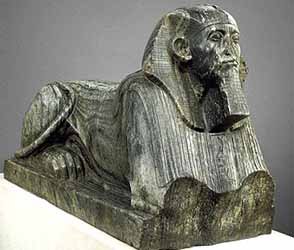
Senusret I probably ruled Egypt for a period of about 34 years after his father's death during a period in Egypt's history where literature and craftsmanship was at its peek. We believe he may have been a co-regent of his father far perhaps another ten years. He probably ruled Egypt from about 1956 through 1911 BC.
It was a period of affluence, and a remarkable time for mineral wealth, gold and the fine jewelry produced with this abundance. Jewelry masterpieces have been found, particularly in the tombs of the royal ladies at Dahshur and Lahun, attributable to his reign. Considerable efforts were made to procure amethyst, turquoise, copper and gniess for both jewelry and sculptures. But it was also a time of great stability and development.
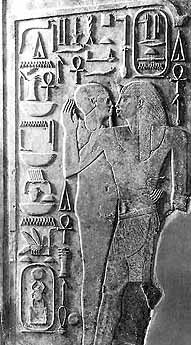
Senusret I embraces the creator god, Ptah at Karnak
However, we also learn from letters of an old farmer named Hekanakhte to his family, that there was apparently a famine during the time of Senusret, a fact that is also implied by an inscription in the tomb of a nomarch (governor) named Amenemhat at Beni Hassan. But along with this news, we also are provided considerable insight into the life of the common Egyptians of this period by Hekanakhte's letters, and a better understanding of the details of agricultural.
He continued many of his father's policies, including the expansion in northern Nubia. We know that he sent one expedition to Nubia in his tenth year of reign, and that eight years later, he sent another army as far south as the second cataract. His general, Mentuhotep, went even deeper into Nubia.
However, Senusret I established Egypt's southern border at the fortress of Buhen near the second cataract, where he placed a garrison and a victory stele, thereby adding to the already substantial military presence established by his father. Now, there were at least 13 fortresses that extended as far as the Second Cataract, and while Egypt's border may have been at the Nile's second cataract, he exercised control of Nubia as far as the Third Cataract. Inscriptions attributable to Senusret I can be found as far south as the island of Argo, north of modern Dongola.
He also protected the Delta region and the Western desert Oases from Libyan invasion by means of a series of military campaigns and by establishing control over oases in the Libyan Desert. Several of the expeditions also appear to have been lead by him personally.
However, he radically changed the policy towards Syria/Palestine by seeking stable commercial and diplomatic relations rather then a policy of expansion and control. Trading caravans passed between Syria and Egypt exchanging cedar and ivory for Egyptian goods.
Religiously, Senusret contributed considerable attention to the cult of Osiris, and over his long rule, this deity's beliefs and practices flourished in Egypt. Osiris was a god of the people and in expanding this cult, Senusret I gave his subjects what John Wilson has described as the 'democratization of the afterlife'.
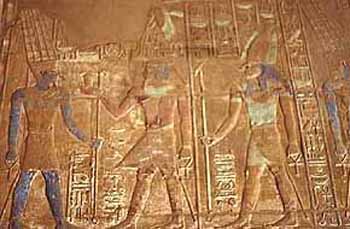
Senusret I with Amun-Re at Karnak
Senusret I had already established himself as a builder during the co-regency with his father by extending and and embellishing some major temples, particularly at Karnak, where he is considered to have founded the temple of Ipet sut (Karnak), and Heliopolis.
As early as year two of his reign, he rebuilt the very important temple of Re-Atum at Heliopolis, a center of the sun cult. He probably even personally participated in the foundation ceremonies for the temple's reconstruction.
He also had two, massive 20 meter (66 foot) red granite obelisks erected at the same temple on the occasion of his jubilee celebrating his 30th year in office. These monoliths would have weighed 121 tons each. One of the pair remains the oldest standing obelisk in Egypt. He also built the famous bark shrine, or White Chapel, that has been reconstructed by Henri Chevrier in the Open Air Museum at Karnak.
It was built in order to celebrate his sed festival (Jubilee) in the 30th year of his reign, but the blocks for the temple were reused to build the third Pylon at Karnak. A scene within the White Chapel records the coronation of Senusret I, and is the oldest such scene so far discovered.

The White Chapel at Karnak
The more important projects included remodeling the temple of Khenti-amentiu-Osiris at Abydos. He also erected many memorial stele and small shrines, or cenotaphs, at Abydos, a practice that would be followed by many Middle and New Kingdom pharaohs. One also also finds temples built by Sunusret I at Elepantine and Tod. In fact, he is attested to at almost three dozen sites from Alexandria to Aswan and down into Nubia where he carried out building projects.
Senusret I also set up a program to build monuments in each of the main cult sites all over Egypt. This was really an extension of an Old Kingdom policy, but in reality he was following his fathers efforts to consolidate and centralize power. This move undermined the power bases of local temples and priests.
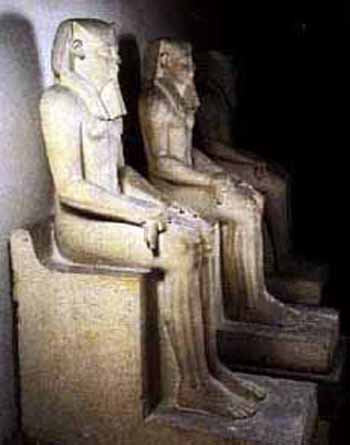
In order to facilitate these building projects, he sent expeditions to exploit the stone quarries of Wadi Hammamat, the Sinai at Serabit el-Khadim, Hatnub, where two expeditions were sent in years 23 and 31 of his reign for alabaster, and Wadi el Hudi. One of these expeditions extracted enough stone to make sixty sphinxes and 150 statues. Many of his statues did not survive the ages, but the Egyptian Antiquity Museum includes a large collection of those that did.

Fragment from Karnak pillar with King and Horus
He also built a large pyramid, very reminiscent of older complexes, at Lisht, near Itjtawy, the capital apparently founded by his father. His pyramid is located just to the south of his father's pyramid at el-Lisht.
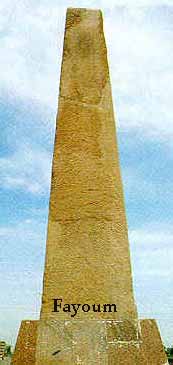 -
- 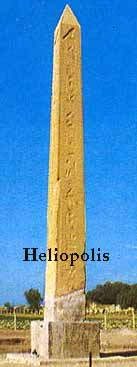
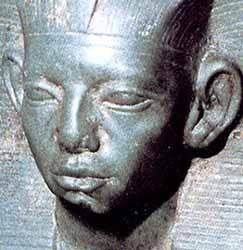
He was the third king of the 12th Dynasty
His throne name was 'Nub-kau-re'
'Golden are the Souls of Re'
Ammenemes II (Greek)
Amun is at the Head

Amenemhet II was the son of Senusret I and one of his chief queens, Nefru. Like his father, he served the first three years of his reign as co-regent with his father. During this time Amenemhet II led a Nubian expedition.
Family:
Apparently, Amenemhet II also took his son, Senusret II as a co-regent, but also for only a brief time before his own death. He had four daughters - Ita, Khnemet, Itiueret and Sithathormeret
Dates:
According to Manetho, Amenemhat II ruled for 38 years, a number which is generally accepted. The Turin King list is fragmentary at this point and only confirms 10 or more years. In view of the long reign of his predecessor, it is not impossible that Amenemhat II was already quite aged when he came to the throne, in which case a shorter reign is to be favored. The Oxford History of Ancient Egypt gives his reign as lasting from 1911 through 1877 BC, while Clayton gives it as 1926 through 1895 BC.
Government:
Domestically, Amenemhet II failed in one important respect. Under the rule of his predecessors, nomarchs, who were basically the governors of the various nomes (provinces), had been personally appointed by the king. This was a measure taken to assure the centralization of government. The First Intermediate Period was at least partially caused the chaos resulting from strong regional rulers who destabilized this central control.
However, Amenemhat II apparently allowed this important office to revert back to a hereditary position. The nomarchs soon took advantage of this change by adapting pretentious titles sometimes imitating those of the royal court. However, Amenemhat did keep a firm hand on these matters and appears to not let these local rulers forget their allegiance to the crown. In return for royal favors, they were expected to help protect the Egyptian borders, to undertake expeditions for the king and to generally act as his deputies.
Foreign Policy:
The foreign policy of Amenemhat II appear to have been a continuation of his father's. There is evidence of extensive trade with parts of the Near East, Mesopotamia and even Crete. Several Egyptian objects, among them small statues and scarabs, were found at several Near Eastern sites. Among them a sphinx of princess Ita, that was probably sent to Syria as a trading gift. Especially favored were the Syrian port of Byblos, where the native ruling elite even made short inscriptions in hieroglyphic, referring to Egyptian gods. The foundation deposits of the temple of Tod, dated to the reign of Amenemhat, contained objects of Mesopotamian and Cretan origin.
Not all contacts with Asia were as peaceful, however, as is shown by raids of Bedouin, probably in the Sinai and some Egyptian military activity against two unnamed Asian cities.
There was also at least one military expedition against Nubia and during his 28th year, Amenemhat II sent the official Khentikhetaywer as an envoy to Punt.
Monuments:
Not many buildings from the time of Amenemhat II remain. A pylon at Hermopolis, in Middle Egypt and the foundation deposits at Tod are, along with his pyramid at Dashur, the only notable monuments that were left from his reign.
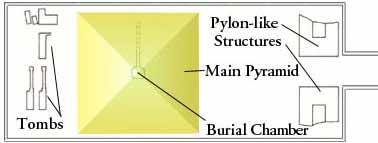
The choice of location for his pyramid at Dashur, not far from the Bent and Red Pyramids built by 4th Dynasty king Snofru, raises the question why he did not build his funerary monument at El-Lisht like his father and grandfather. It is possible that Amenemhat sought to create a relationship between his dynasty and that of Snofru by doing so.
The pyramid complex is poorly preserved and is mostly known because of the exquisite jewelry that was found in some of the tombs of Amenemhat's daughters, located in the forecourt of the complex. The jewelry included rings, braces, necklaces and diadems and shows the excellent craftsmanship of the era.
From 1894 through 1895, Jacques de Morgan made a cursory investigation of the ruins. Unfortunately he was too focused on the jewelry finds in some surrounding princess' tombs that he never examined the mortuary temple, the causeway or the valley temple. In fact, no casing stones have ever been found nor even the base of the pyramid cleared for a proper measuring. Therefore, we are not sure of its size, the angle of its slop, or its height.
The mortuary temple was almost completely destroyed, though we know it was probably called "Lighted is the place of Amenemhet's pleasures". The ruins, which stand to the east of the pyramid have yet to be closely examined, though they must be very inviting to archaeologists. There are many building fragments, some of which include relief decorations. Most interesting, however, might be the massive, tower-like structures resembling pylons in the temple's east facade.
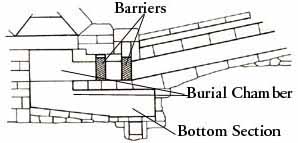
The causeway, which was broad with a steep slope and enters the enclosure wall on the middle of the east side, has not been investigated at all, and we are told that the valley temple has not even been found. The core of the pyramid was built much like that of Senusret I's pyramid , with a core that had corners radiating out. A framework was made with horizontal lines of blocks to form a grid, or framework between the corners. Here, however, the filling was sand. The entire complex was surrounded by an enclosure wall that was much more rectangular then that found in older pyramids. It was oriented east-west.
Behind the pyramid between it and the west part of the enclosure wall are found tombs of the royal family. The belong to his other son prince Amenemhetankh and princesses Ita, Khnemet, Itiueret and Sithathormeret. Within these tombs, Morgan found the remains of funerary equipment, including wooden coffins, canopic chests and alabaster vessels for perfumes. But of course he also found wonderful jewelry in the tombs of Ita and Khnemet, that stole his attention. These pieces may now be found in the Treasure Chamber of the Cairo Museum.
Books: Genut
We have considerable knowledge of Amenemhet II's reigns because of a number of important documents. Some historical information about the 12th Dynasty comes from a set of official records know as the genut, or 'day-books'.
They were found in the temple at Tod. Some of Amenemhet II's buildings also contain parts of these annals. They describe the day to day process of running the royal palace. One very important set of annuals were discovered at Mit Rahina (a part of ancient Memphis) that record detailed descriptions of donations made to temples, lists of statues and buildings, reports of both military and trading expeditions and even royal activities such as hunting. These documents not only provide information on Amenemhet II, but other kings of the period as well.
Amenemhet II is probably best known for consolidating the work of his predecessors in foreign affairs. He exchanged gifts with other rulers in the Mediterranean (Levant) region. We find jewelry inscribed with his name in royal tombs at Byblos in Lebanon, as well as local copies of Egyptian jewelry. These items were particularly prevalent in the tomb of a local prince named Ipshemuabi. In addition, native rulers at Byblos even wrote short inscriptions in hieroglyphs, held the Egyptian title of count, and made references to Egyptian gods.
They acquired royal and private statuary. On the other hand, four bronze boxes found at the temple of Montu at Tod and inscribed on their lids with the name of Amenemhet II bore a large number of silver cups of Lavantine and Aegean origin. There were also cylinder seals and lapis Lazuli amulets from Mesopotamia. These items were probably either a gift, or tribute, and it is noteworthy that at the time, silver was more rare then gold in Egypt, so also more valuable.
The Shipwrecked Sailor
One story during the time of Amenemhet II tells of the travels of a ship captain who had been to a magic island in the sea far south beyond Nubia. The sailor told the vizier (prime minister) about a tempest which arose suddenly and drove the ship towards a mysterious land. He suddenly heard a noise like thunder, and saw a huge serpent with a beard. Upon hearing that the sailor was sent by the pharaoh, the serpent let him go back, with gifts to "Amenemhet". It told him that it was Amon-Ra¹s blessing that has made this island rich and lacking nothing. Upon hearing this amusing story, "Amenemhet II" ordered it to be documented on a papyrus. The story is known to historians as "The Shipwrecked Sailor".
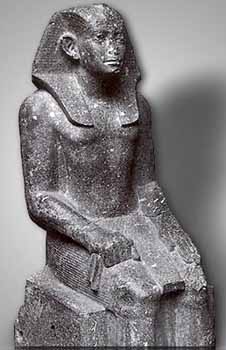
Senusret II was the fourth king of the 12th Dynasty.
His name means 'Man of Goddess Wosret' . It was the name that seems to enter the royal linage because of this king's non-royal, great, great grandfather, the original Senusret and father of the founder of the Dynasty, Amenemhet I.
Senusret II's name is also found in various references as Senwosret II, or the Greek form, Sesostris II. His throne name was Kha-khaeper-re, meaning "Soul of Re comes into Being".
He succeeded hisfather, Amenemhet II in about 1895 BC, after a short co-regency of at least three years.
References differ on the length of his rule, varying between about seven and fifteen years. The Oxford History of Ancient Egypt gives his reign as 1877-1870, while Clayton gives him a reign from 1897-1878 BC.
A group of statues was discovered, two of which had been usurped by Ramesses II, portraying Senusret II with wide, muscular shoulders like his father, but with a more vigorous face, lacking the blandness of older 12th Dynasty statuary.
This was a period of fine portraitures art, reflected in the distinctive broad cheekbones and other characteristics portrayed in the statues. In fact, even a number of private statues have been found that also reflect this high art, and the late 12th dynasty is seen as a milestone of human portraiture in Egyptian art.
Better known then Senusret II's statues are a pair of of highly polished black granite statues of a lady Nefret, who did not carry the title of "Royal Wife", but who was probably either a wife of Senusret II's who died before he ascended the throne, or a sister.
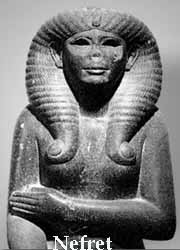
She did, however, have other titles usually reserved for queens.
His principal royal wife was Khnumetneferhedjetweret (Weret), who's body was found in a tomb under the pyramid of her son, Senusret III at Dahshure. Senusret III would become Senusret II's successor.
So far their is no evidence of a co-regency with his father as their had been for every king from the time of Amenemhet I.
Senusret II probably also had several daughters, one of which would have probably been Sathathoriunet (Sithathoriunet) , who's jewelry was discovered in a tomb behind the king's pyramid.
Like his father, Senusret II's reign is considered to be a peaceful one, using more diplomacy with neighbors then warfare. We are told that trade with the Near East was particularly prolific. His cordial relations with the regional leaders in Egypt is attested to at Beni Hassan, for example, and especially in the tomb of Khnumhotep II, who he gave many honors.
There sem to be no recorded no military campaigns during his rule, though he undoubted protected Egypt's mineral interests and their expanded territory in Nubia.
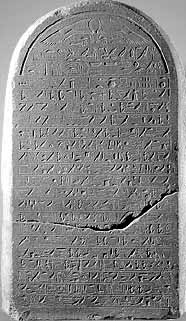
A Stele of Senusret II in Brown Quartzite
His efforts seem to have been more directed at expanding cultivation within the Fayoum rather then making war with his neighbors and regional nobles.
In the Fayoum, his projects turned a considerable area from marshlands into agricultural land. He established a Fayoum irrigation project, including building a dyke and digging canals to connect the Fayoum with a waterway known today as Bahr Yusef.
He seems to have had a great interest in the Fayoum, and elevated the region in importance. Its growing recognition is attested to by a number of pyramids built before, and after his reign in or near the oasis (though the Fayoum is not a true oasis). It should also be remembered that kings usually built their royal palaces near their mortuary complexes, so it is likely that many of the future kings made their home in the Fayoum.
These later kings would also continued and expanded upon Senusret II's irrigation projects in the Fayoum. Senusret II built a unique statue shrine of Qasr es-Sagha on the north eastern corner of the region, though it was left undecorated and incomplete.
Senusret II's Pyramid
His father, Amenemhet II built his pyramid at Dahshure, but Senusret II built his pyramid closer to the Fayoum Oasis at Lahun.
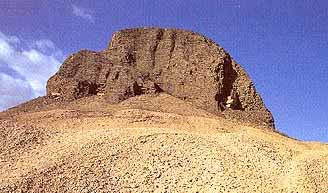
His pyramid definitely established a new tradition in pyramid building, perhaps begun by his father.
Senusret II chose to build his pyramid, called Senusret Shines, near the modern town of Lahun (Kahun) at the opening of the Hawara basin near the Fayoum rather then at Dahshure where his father's Amenemhet II pyramid is located.
The location of Senusret II's valley temple is known but no ground plan can be made from its ruins. The causeway is likewise ruined, but must have been broad, and of the completely destroyed mortuary temple on the east side of the pyramid, all that is known is that it must have been built of decorated granite, judging from the few fragments that remain.
Beginning with Senusret II, the location of the door was less important from a religious then from a security standpoint, so rather then being on the north side of the structure, it was hidden in the pavement of the south side.
To the south side of the pyramid Petrie excavated four shaft tombs that belonged to Senusret II's family and in one of these, discovered a fine, gold inlaid uraeus that may have come from the king's mummy.
In building this pyramid Senusret II's archetects took advantage of a natural stump of yellow limestone that they cut down into four steps to serve as the pyramid's base core. Mudbrick was used to build the upper part of the core, and as several pyramids before, wings were built out from this core and cross walls within the wings were built to form a framework.
The resulting sections were then filled with mudbrick. Also like some prior 12th Dynasty pyramids, the casing was set into a foundation trench at the base of the pyramid. Most of the casing was carried off to build a structure for Ramesses II, though parts of the black granite pyramidion that set atop the pyramid have been found. There was also a cobble filled drainage ditch around the pyramid that was filled with sand to channel rain water.
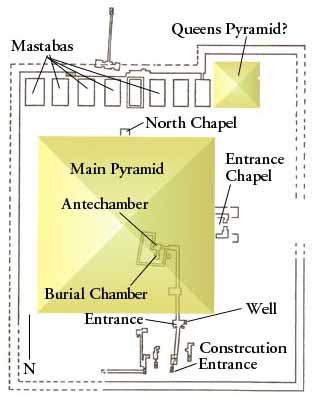
While the pyramid had been robbed in antiquity, it nevertheless took Petrie months to located the entrance to this pyramid. The reason is that for the first time, the builder's were more interested in security then religious tradition, and therefore hid the entry passage in the pavement of the pyramid courtyard near the east end of the pyramid's south side.
Prior to this, just about all pyramid entrances were in the middle of the north side. This was because in the astral and celestial religion of the old kingdom, the king was to leave his tomb to the north where he was himself to become both a star and a deity. However, because of the rise in the cult of Osiris, this became less important, and it was more meaningful for the tomb to resemble the underworld of Osiris.
Interestingly, the builders of the pyramid must have thought this would be sufficient insurance against thieves, as they did not even include a barrier in the entrance corridor.
Also interesting is the "entrance chapel, not located above the entrance, or on the north side of the pyramid (these are also typically referred to as "North Chapels").
It was located in the middle of the east wall of the pyramid. However, there was actually a north chapel, though smaller and less structurally similar to older north chapels then the entrance chapel on the east side of the pyramid.
The vaulted entrance corridor was too narrow for a large sarcophagus and the blocks used to line the burial chamber, though another entrance was hidden farther south, beneath a sloping passage to the tomb of an unknown princess. This shaft is about 16 meters (52 feet) deep, and a corridor at the bottom leads to an entrance hall below the formal entrance shaft.
The hall has a vaulted ceiling and a niche at the east end of the hall contains a ritual well, the bottom of which has never been reached. It drops to at least the water table. Because ritual shafts did not become prominent until much later, some Egyptologists maintain that the shaft may have been built to monitor the ground water, or for other unknown purposes.
After the entrance hall another corridor gradually rises before passing through a chamber to the left and finally arriving at an antechamber. From the antechamber, the substructure takes a 90 degree left turn, passing through a short corridor to the burial chamber, which lies under the southeast quadrant of the pyramid. The burial chamber is sheathed in granite and has a gabled roof. A red granite sarcophagus fills the west end of the chamber. Before it stood an alabaster offering table.
From the southeast corner of the burial chamber a short corridor leads to a small side chamber where leg bones, presumably of the king, were found. At the northwest corner at the head of the sarcophagus is the entrance to a passage that loops around the burial chamber to a doorway in the short corridor between the antechamber and the burial chamber.
This corridor presented a symbolic exit to the north for the king's spirit. But it also creates a symbolic subterranean island that can be related to the god, Osiris, who's worship was on the rise during the 12th Dynasty.
In addition to the tombs of the princesses to the southeast, between the pyramid and the north section of the enclosure wall, eight mastabas were built using mudbrick to cover a superstructure carved from the bedrock, similar to the manner in which the pyramid was built.
A small pyramid lies at the north end of this row of mastabas, thought to be that of a queen. If it is not the pyramid of a queen, but an unlikely cult pyramid, it would have been the last such structure built, rather then that of his grandfather's, Senusret I. Though this pyramid does have a North Chapel, Petrie never found a subterranean structure even after exhaustive investigation.
The only evidence we do have that the pyramid belonged to a queen is its placement within the complex and a partial name from a vase that Petrie found in a foundation deposit.
West of the entrance shaft of the pyramid Petrie discovered the ruins of the tomb of Princess Sathathoriunet (Sithathoriunet), where he discovered the famous Treasure of el-Lahun, which included wonderful jewelry and other items from the her burial equipment.
These items included a gold headband, a gold necklace of small leopard's heads, two gold pectorial ornamented with precious stones one of which was inscribed with Senusret II's name and the second with the name of Amenemhet III. There were also other bracelets, rings and alabaster and obsidian vessels that were decorated with gold, all of which today can be found in the Egyptian Antiquities Museum.
Nearby the complex to the northwest lies the ruins of the pyramid town that grew up around the construction of Senusret II's pyramid. Coriginally named Hetep Senusret, meaning "May Senusret be at Peace". It has provided considerable information to Egyptologists on the lives of common Egyptians and urbanism. This ancient village is today known as Lahun, or Kahun, after the local nearby village.
Senusret II is further attested to by a sphinx, now in the Egyptian Antiquity Museum in Cairo and by inscriptions of both he and his father near Aswan.
It should also be mentioned that the pyramid town associated with Senusret II's complex, known as Lahun (Kahun) after the nearby modern village, provided considerable information to archaeologists and Egyptologists on the common lives of Egyptians. Pyramid towns were communities of workmen, craftsmen and administrators that grew up around a king's pyramid project.
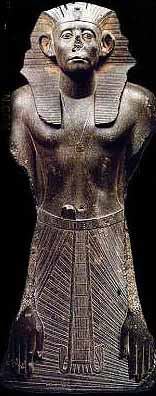
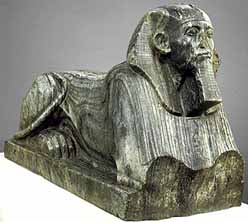
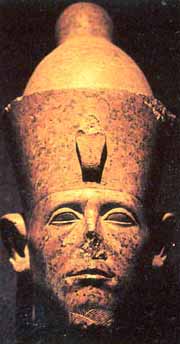
The fifth king of the 12th Dynasty
Senusret III is probably the best attested king of the New Kingdom. He ruled the country for perhaps as long as 37 years as the 5th pharaoh of Egypt's 12th Dynasty from around 1878 until 1841 BC. He is probably also the best known of the Middle Kingdom pharaohs to the public because of his many naturalistic statues showing a man with often heavy eye-lids and lined continence.
Later statues seem to portray him with increasing "world-weariness". Taken along with contemporary text, these statues seem to wish us to believe Senusret III was a king possessed of a concerned, serious and thoughtful regard for his high office.
Senusret III's statuary is much loser in terms of the rigid ideological representations of earlier kings and illustrates a shift in both the function of art and a change in the ideology surrounding the king. The human qualities of the statues give a sense of age and tension, rather then the all powerful king portrayed in older works. We see in these statues a shift away from the king as god, and more towards the king as leader.
Senusret was this king's birth name, which mean, "Man of Goddess Wosret". He is also sometimes referred to as Senwosret III and Senusert III, or by the Greeks, Sesostris III.
His throne name was Kha-khau-re, meaning "Appearing like the Souls of Re". Senusret III was most surely the son of Senusret II, changing a trend of having alternate leaders named Senusret and Amenemhet.
We know of no co-regency with his father, though most of the previous 12th Dynasty kings shared at least a few years of their reign with their sons, and a co-regency would clear up some questions about Senusret III's long reign.
His mother may have been Khnumetneferhedjetweret (Khanumet, Weret), who we believe was buried in a tomb near his pyramid at Dahshur.
He was married to a principle queen named Mereret, who outlived him, and may have also been married to his sister, Sit-Hathor. His son and successor was Amenemhet III.
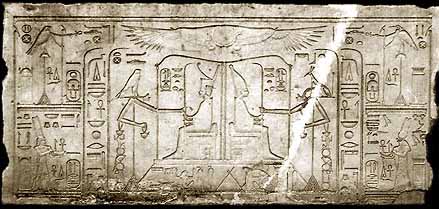
A Papyrus commemorating Senusret III's Sed-festival
Senusret III must have been a very dominant figure within his time. Manetho describes him as a great warrior, not surprisingly, because he also says he was "of great height at 4 cubits, 3 palms and 2 fingers" (over 6 ft, 6 in or 2 meters). In addition, he may also have been the model for the Sesostris of Maetho and Herodotus, who was probably a composite, heroic Middle Kingdom ruler who was suppose to be a model for future kings.
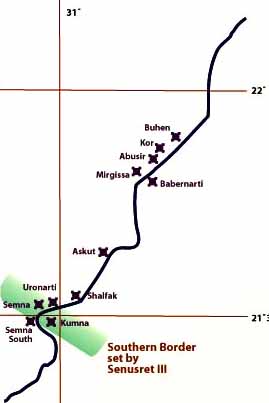
While there had been fortifications built in Nubia,
Apparently, the Nubians were a troublesome lot during his reign, for Senusret III would again have to mount campaigns in at least the years 8, 10, 16 and 19 of his reign. Regardless, these campaigns seem to have been for the most part successful, for the king had inscribed on a great stele at Semna erected in year 8 of his rule, now in Berlin, "I carried off their women, I carried off their subjects, went forth to their wells, smote their bulls; I reaped their grain, and set fire thereto". In other words, he killed their men, enslaved their women and children, burnt their crops and poisoned their wells. The stele also provides that no Nubians were allowed to take their herds or boats to the north of the specified border.
To facilitate these military actions in Nubia, he had an existing bypass canal around the First Cataract (rapids) at Aswan, originally dug in the Old Kingdom by Merenre - or Pepi I cleared, broadened and deepened. According to an inscription, he had it repaired again in year eight of his reign. This canal was near the island of Sehel.
His predecessors had also established a policy of building fortresses in Nubia, but in order to further secure the area, Senusret III built more fortresses then any of the the other Middle Kingdom rulers. In the 64 km (40 mile) length of the Second Cataract in Lower (northern) Nubia there were no less then eight such fortresses between Semna and Buhen However, many Egyptologists disagree with exactly how many of these fortresses were built by Senusret III, or were instead, simply rededicated or enlarged.
These fortresses were in close contact with each other, and with the region's vizier, reporting the slightest movements of Nubians. At least some of the fortresses appear also to have been specialized.
For example, the one at Mirgissa was more involved with trade, whereas others, such as the fortress at Askut, were used as supply depots for campaigns into Upper (southern) Nubia.
Senusret III managed to expand Egypt's boarders further south then anyone ruler before him, of which he was proud. A stele at Semna with a duplicate at Uronarti records:
I have made my boundary further south than my fathers,
I have added to what was bequeathed me.
I am a king who speaks and acts,
What my heart plans is done by my arm.
One who attacks to conquer, who is swift to succeed,
ln whose heart a plan does not slumber.
Considerate to clients, steady in mercy,
Merciless to the foe who attacks him.
One who attacks him who would attack,
Who stops when one stops,
Who replies to a matter as befits it.
To stop when attacked is to make bold the foe's heart,
Attack is valor, retreat is cowardice,
A coward is he who is driven from his border.
Since the Nubian listens to the word of mouth,
To answer him is to make him retreat.
Attack him, he will turn his back,
Retreat, he will start attacking.
They are not people one respects,
They are wretches, craven-hearted.
My majesty has seen it, it is not an untruth.
I have captured their women,
I have carried off their subjects,
Went to their wells, killed their cattle,
Cut down their grain, set fire to it.
As my father lives for me, I speak the truth!
It is no boast that comes from my mouth.
He not only stabilized Egypt's southern border at Semna, his troops regularly penetrated the area beyond and we know of a record recording the height of the inundation as far south as Dal, many miles beyond Semna. This stele continues with an admonishes later kings;
Now as for every son of mine who shall maintain this boundary, which My Majesty has made, he is my son, he is born of My Majesty, the likeness of a son who is the champion of his father, who maintains the boundary of him that begat him. Now, as for him who shall relax it, and shall not fight for it; he is not my son, he is not born to me.
His son, Amenemhet III heeded this warning, and interestingly, Senusret III was later deified in Nubia as a god.
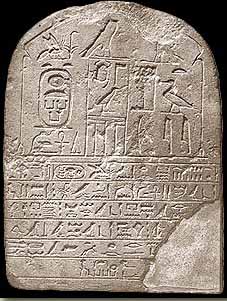
Senusret III Stele from Aswan
However, we also know that, in what we believe to be his final campaign in Nubia in year 19 of his reign, his efforts were less successful. Apparently, due to a drop in the Nile's water level, his forces had to make a retreat to avoid being trapped.
Most of Senusret III's military attention was directed towards Nubia, but he is also noted for a campaign in Syria against the Mentjiu, where rather then a goal of expansion, he seems to have been after retribution and plunder. We owe this information to a a stele belonging to an individual named Sobkkhu, who apparently also participated in the Nubian campaigns. The king apparently led this campaign himself, capturing the town of Sekmem, which may have been Shechem in the Mount Ephrain region.
It was probably during Senusret III's reign that we also find the "Execration Texts"These were inscriptions found in Nubia and Egypt, usually inscribed either on magical figurines or on pottery. The inscriptions were usually a list of enemies of Egypt. These objects were often ritualistically smashed, and the shards placed under the foundations of new building, thus "smothered", or nailed at the edge of the area they were meant to protect.
The plunder from the Nubian and Syrian campaigns was mostly directed towards the temples in Egypt, and their renewal. For example, at Abydos, an inscription by a local official named Ikhernofret states that the king commissioned him to refurbish Osiris's barge, shrine and chapels with gold, electrum, lapis lazuli, malachite and other costly stones.
He also adorned the temple of Mentuhotep II at Deir el-Bahari at Luxor with a series of six life size granite standing statues of himself wearing the nemes and headdress. They once lined the lower terrace
Religiously, we are told in a graffiti that, even though his capital, burial ground and other interests were in Northern Egypt, he also helped maintain a large number of priests associated with the cult of Amun in Upper (southern) Egypt at Thebes.
He also had built a large temple to the old Theban war god, Montu, just north of Karnakat Nag-el-Medamoud.
While this temple was refurbished in the New Kingdom and again in the Greek and Roman period, nothing remains of it save two finely carved granite gateways that were discovered in 1920, along with some very splendid statues and a few inscriptions.
Domestically, Senusret III was able to carry on his military campaigns and building projects because he had matters at home largely under control. He divided the country into three administrative divisions (waret), including a North, South and the Head of the South (Elephantine and Lower Nubia), that were each administered by a council (djadjat) of senior staff who in turn reported to a vizier.
This sufficiently weakened the power of local nomarchs (governors) and other high officials who had once again begun to challenge the central government and the monarch. Decentralization due to powerful local officials and nobles had, in the past, created chaos and ultimately led to the dark times of the First Intermediate Period. It would seem that most all of the Middle Kingdom rulers were aware of this threat, and were constantly on guard.
This new administrative scheme apparently also had another effect, in that it promoted the rise of the middle class, many of whom were incorporated into the administration, and were no longer under the influence and control of the local nobles.
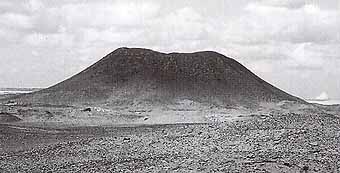
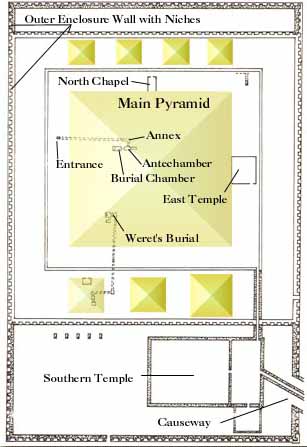
Senusret III had his pyramid built at Dahshur, a mostly Middle Kingdom necropolis. It was the largest of the 12th Dynasty pyramids, but like the others with mudbrick cores, after the casing was removed it deteriorated badly.
In the excavation season of 1894-1895, Jacques de Morgan also found the tombs of Queen Mereret and princess Sit-Hathor near the northern enclosure wall of Senusret III's pyramid complex. Also found with these tombs were some fine jewelry, missed by earlier robbers.
Some Egyptologists doubt that Senusret III was buried in this pyramid. He also had an elaborate tomb and complex built in South Abydos. This huge complex stretches over a kilometer between the edge of the Nile floodplain and the foot of the high desert cliffs that form the western boundary of the valley. This complex consists of an underground tomb which, at least at one time, was considered to be the largest in Egypt - that may have been eclipsed by the discovery of the Tomb of Ramesses II's Sons in the Valley of the Kings.
Other components include a mortuary temple at the edge of the cultivated fields and a town south of the tomb that supported the complex. The name of this funerary complex was 'Enduring are the Places of Khakaure Justified in Abydos'.
Senusret III is further attested by blocks from a doorway found near Qantir and by his rock inscriptions near the island of Sehel south of Aswan that record the reopening of the bypass canal.
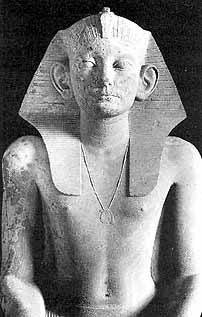

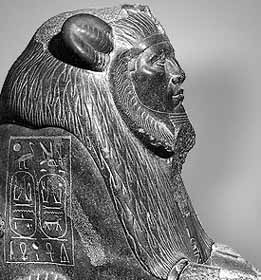
TYhe sixth ruler of the 12th Dynasty
Amenemhet III was the son of Senusret III and the last great ruler of the Middle Kingdom. Amenemhet III appears to have shared the throne with is father as co-regent for at least a while before the death of his father. The king's principle wives were buried in his pyramid at Dahshur in their own chambers, a very unusual feature at this time.
The Chief wife was probably Aat. The second queen we are unsure of. We also know of a daughter named Neferuptah and of course his successor who was probably his son, Amenemhet IV. However, Amenemhet IV may have been a grandson, but in any event, Amenemhet III probably made him a co-regent. It is also possible that the queen who ruled as the last pharaoh of the 12th Dynasty, Sobkhotpe IV was also his daughter.
Every king before him or after him in the 12th Dynasty, with perhaps the exception of the last female ruler, would either be named Amenemhet, as the dynasty's founder was, or Senusret, the first of whom was probably the non royal father of Amenemnet I. This is the king's birth name, meaning 'Amun is at the head'. His throne name was Ny-maat-re, meaning 'Belonging to the Justice of Re'. To the Greeks, he was Ammenemes III. Amenemhet III was the 6th ruler of the 12th Dynasty, and may have reigned for as long as 45 years. He supposedly ruled from 1842 through 1797 BC.
It was a good thing he ruled this long, because his first tomb, his pyramid at Dahshur, started collapsing about the time it was finished. It took about 14 or 15 years to build, and he had to start completely over with a new pyramid near to the Fayoum at Hawara. At Hawara, we believe the complexity and splendor of his mortuary temple made it commonly known as the Labyrinth. Herodotus, Diodorus Siculus, Strabo and Pliny all make reference to this structure. According to Diodorus, Daedalus was so impressed by the temple that he built his own labyrinth for Minos in Crete based on Amenemhet III's temple.
In some respects, the disaster associated with his first pyramid worked in this king's favor, for it provided him the opportunity to build his tomb closer to the region that he seemed to flourish with attention. Because of his interest in the agricultural economics of the Fayoum, his reign became perhaps the apex of the Middle Kingdom and he reciprocated with an interest in its needs, as well as founding temples and building statues.
Building activity in the Fayoum, besides his pyramid, included the Temple of Sobek, the principle local deity, in the city the Greeks called Crocidopolis. In the Fayoum, Sobek was closely related to a more national god, the falcon, Horus the Elder. He also built a chapel dedicated to Renenutet the goddess of the harvest, at Medinet Maadi.
He participated in agricultural projects in the Fayoum as well. He built a barrage to regulate the flow of water into the large lake, Birket Qarun from the Bahr Yousef canal. This reclaimed a large fertile area, perhaps as much as 17,000 acres, that was further protected by an earthen embankment. To celebrate this achievement, he erected two colossal statues of himself at Biyahmu. The statues stand upon very impressive bases, and overlook the lake. He was so much connected to the Fayoum that during the Greco-Roman era, during which time there was a revival of the area, he was probably worshipped as a god under the name Lamares.
Probably because of the connecting mortuary temple, his pyramid complex at Hawara was world renown. The mortuary temple was complex with many columned courtyards, chambers and passages.
Outside of the Fayoum he built a temple of Quban in Nubia and expanded the temple of Ptah at Memphis.
Considering his building projects, it is not surprising that Amenemhet III was very active in various quarries. He was especially interested in the turquoise mines in Sinai such as those at Serabit el-Khadem.
He probably at least extensively rebuilt and enlarged the Temple dedicated to Hathor and other gods at Serabit el-Khadem. In fact, there were some 49 rock inscriptions there, as well as ten more at Wadi Maghara and Wadi Nasb in the Siani that record almost continuous mining operations between years two and forty-five of his reign. Yet within Egypt, is is curious that we actually have very few inscriptions from Amenemhet III. But he was also active at Wadi Hammamat, where alabaster is mined, in the diorite quarries of Nubia, at Tura for its fine while limestone, and other mining sites.
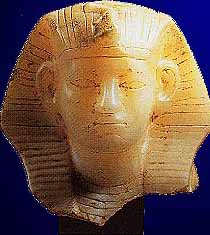
What we do not see during Amenemhet III's time is a lot of military action, other then perhaps strengthening the defenses at Semna. The military activities of his predecessors allowed him a peaceful reign upon which to build, as well as to exploit the mineral wealth of the quarries. He does build, politically, reorganizing the domestic administration. He continued to reform the national administration as did his father. It was probably his father that divided the country into three administrative regions, controlled by departments based at the capital. This federal bureaucracy oversaw the activities of local officials, who no longer possessed any extensive power. Amenemhet III continued to refine this new administration.
Amenemhet III was also able to continue with good foreign relations also without much military action. It is said that he was honored and respected from Kerma to Byblos, and during his reign many eastern workers, including peasants, soldiers and craftsmen, came to Egypt.
However, the extensive building works, together with possibly a series of low Nile floods, may have exhausted the economy by the end of his reign. Ironically, all of these foreign workers, many employed for building activities, may have also encouraged the Hyksos to settle in the Delta, thus leading eventually to the collapse of native Egyptian rule. Upon the king's death, he was buried in his second pyramid at Hawara.
Amenemhet III is also attested to by an unusual set of statues probably of Amenemhet III and Senusret III that shows the two in archaic priestly dress and offering fish, lotus flowers and geese. These statues are very naturalistic. but show the king in the guise of a Nile god.. There was also a set of sphinxes that were once thought to have been attributable to the later Hyksos rulers, but are now believed to have been built on the orders of Amenemhet III. Originally all these statues were discovered reused in the Third Intermediate Period temples at Tanis. We also know of an inscription by the king at Koptos(Coptos).
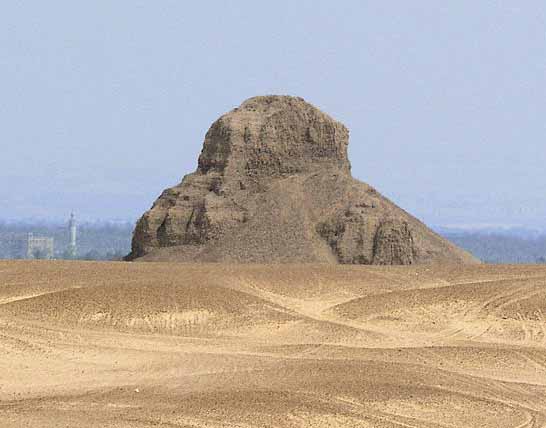
Amenemhet III attempted to build his first pyramid at Dahshur, but it turned out to be a disaster as it was built on unstable subsoil. Today the pyramid named 'Amenemhet is Mighty' is a sad dark ruin on the Dahshur field, aptly sometimes called the Black Pyramid.
Even though it took 15 years to build, rather then being buried in this pyramid, Amenemhet III chose to build a second pyramid at Hawara, closer to his beloved Fayoum.
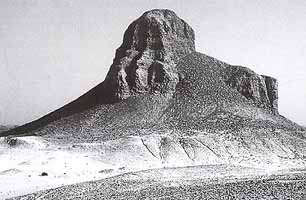
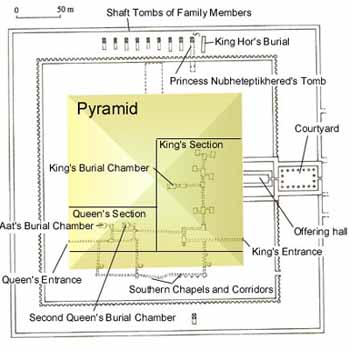
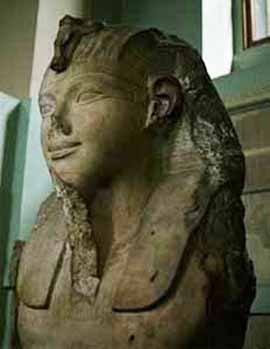
Because of the long reign of Amenemhat III, it is possible that Amenemhat IV was the grandson of his predecessor rather than his son. It should be noted, however, that the fact that there is no trace of Amenemhat III ever having had a son, does not rule out that Amenemhat IV may have been the son of his predecessor.
It is generally believed that he was married to Nefrusobek, who is assumed to have been a daughter of Amenemhat III. If both assumptions are correct, it is more likely that Amenemhat IV may still have been a son of his predecessor.
In any case, the name of the mother of Amenemhat IV is not known, which might perhaps mean that she was already deceased when he got to the throne. According to Manetho, this king ruled for only 8 years, a number that is confirmed by the 9 years, 3 months and 27 days credited to him in the Turin Kinglist. This short reign is confirmed by the relatively few sources that have survived from his reign. It might also indicate that Amenemhat IV was already an elderly man when he came to power.
He shared the first year of his reign in co-regency with Amenemhat III. Amenemhat IV completed several temples that were started during by Amenemhat III. Inscriptions in Nubia also show that he still controlled the territory that was conquered during the reign of Sesostris III.
He appears to have died without heir and was succeeded by Nefrusobek. He was probably buried in his pyramid in Masghuna.
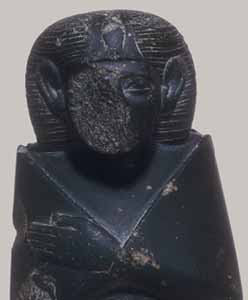
The last ruler of the 12th Dynasty, Nefrusobek is generally believed to have been a daughter of Amenemhat III and the widow of Amenemhat IV. According to Manetho, she may have been a sister of Amenemhat IV.
Her marriage to Amenemhat IV seems to have left them with no male heir, so Nefrusobek became one of the few women to have become king in Ancient Egypt.
The 4 years credited to her by Manetho are confirmed by the 3 years, 10 months and 24 days that have been recorded in the Turin Kinglist. The fact that she is listed in the Turin Kinglist is, in itself, interesting because it shows that she was not considered as a mere regent or as an usurper.
Nefrusobek is the first known female king to have had a full royal titulary. Her titulary still shows the typical ending for feminine words, thus combining the traditionally male titles with the reality that Nefrusobek was a woman.
A graffito in the Nubian fortress of Kumma indicates that like here predecessor, Nefrusobek was still in charge of the Nubian territory that had been conquered by Sesostris III. She also contributed to the Labyrinth of Amenemhat III and probably granted her ancestor divine status in the Fayum.
Several pieces of statues of Nefrusobek have been found. Like her titulary, her statues too combine the traditional aspects of kingdom with the reality that this king was female. Thus we find a headless statue of Nefrusobek in the Louvre Museum that still has a part of the nemes head-cloth showing on her shoulders, while she is still wearing a typically female dress.
Her tomb has not yet been identifies, although it has sometimes been assumed that she was buried in a pyramid in Mashguna.
Dynasties 13-17
There were more than 70 kings in this dynasty. They were not all related to each other. Some of them may only have ruled for a couple of months, or less. Some may also have ruled at the same time as others.
Wegaf 1783-1779
Amenemhat-senebef
Sekhemre-khutawi
Amenemhat V
Sehetepibre I
Iufni
Amenemhat VI
Semenkare
Sehetepibre II
Sewadjkare
Nedjemibre
Sobekhotep I
Reniseneb
Hor I
Amenemhat VII
Sobekhotep II
Khendjer
Imira-mesha
Antef IV
Seth
Sobekhotep III
-------
Neferhotep I 1696 - 1686
Neferhotep I was the 22nd king of the 13th Dynasty. He ruled Egypt from 1696 till 1686 BC. He was the son of a temple priest in Abydos. His father's position helped him to gain the royal image as the king because he did not have any royal blood in his family. Neferhotep is inspirited on some stones discovered near Byblos. Also, they found other stones in Aswan that were carved with texts which documents all his reign. It seems that all his power reached the Delta in the north and the Nubian Nome in the south.
-------
Sihathor 1685 - 1685
Sobekhotep IV 1685 - 1678
Sobekhotep V 1678 - 1674
Iaib 1674 - 1664
-------
Ay 1664 - 1641
Ay was the 27th king of the 13th Dynasty. He ruled Egypt from 1664 till 1641 BC. The king did not have any royal blood. He was from Avaris, a city located in Eastern Delta that was heavily populated with Heksus. The Heksus are the Asiatics who controlled Northern Egypt till 1500 BC. Ay built his pyramid near Avaris but only ruins remain from his temple.
------
Ini I
Sewadjtu
Ined
Hori
Sobekhotep VI
Dedumes I
Ibi II
Hor II
Senebmiu
Sekhanre I
Merkheperre
Merikare
DYNASTY 14
Nehesi
Khatire
Nebfaure
Sehabre
Meridjefare
Sewadjkare
Heribre
Sankhibre
Kanefertemre
Neferibre
Ankhkare
DYNASTY 15
-------
Bnon
-------
Apachnan (Khian) -
Apachnan was the third king of the 15th Dynasty. He was considered one of the "Great Heksus". Apachnan's power reached beyond his kingdom in Northern Egypt. Archeologists found some scarabs and seals bearing his name in Northern and Southern Egypt and some Mediterranean islands such as Crete.
-------
Apophis (Auserre Apepi)
-------
Khamudi -
Khamudi was the last king of the 15th Dynasty and was the last king of the "Great Heksus". The king was listed in the Turin Canon. Khamudi's Obelisk was discovered near the ancient city of Avaris. The king was responsible for negotiation of the Hiksus army's withdrawal from Avaris and most of the Delta. Khamudi was pressured to withdraw due to the successful campaign of Ahmose I's army on his capitol. However, the southern Pharaohs did not keep their agreement and pushed the Heksus out of Egypt and raided their cities in the Middle East for several years by the Theben kings of the 18th Dynasty.
DYNASTY 16
Anat-Her
User-anat
Semqen
Zaket
Wasa
Qar
Pepi III
Bebankh
Nebmaatre
Nikare II
Aahotepre
Aaneterire
Nubankhre
Nubuserre
Khauserre
Khamure
Jacob-Baal
Yakbam
Yoam
Amu
DYNASTY 17
Antef V
Rahotep
Sobekemzaf I
Djehuti
Mentuhotep VII
Nebirau I
Nebirau II Semenenre
Suserenre
Sobekemzaf II
Antef VI
Antef VII
-------
Tao I (Senakhtenre) - The fourteenth king of the Theban Dynasty, ruling Egypt contemporaneously with the Hyksos 15th and 16th Dynasties, was the son of Tao I and Queen Tetisheri. When Tao received word from Apophis, ruler of the Hyksos capital in Avaris, that the hippopotami in the sacred pool at Thebes kept him awake with their snoring, Tao regarded it as an insult. The hippopotami were 400 miles from Apophis sleeping chambers! Tao declared war but was soon killed. His mummy shows evidence of blows by battle-axes, spears and lances. His ribs, vertebrae and skull were fractured. His heir, Kamose, assumed the throne and the war, and was victorious.
-------
Tao II (Sekenenre) - The fourteenth king of the Theban Dynasty, ruling Egypt contemporaneously with the Hyksos 15th and 16th Dynasties, was the son of Tao I and Queen Tetisheri. When Tao received word from Apophis, ruler of the Hyksos capital in Avaris, that the hippopotami in the sacred pool at Thebes kept him awake with their snoring, Tao regarded it as an insult. The hippopotami were 400 miles from Apophis sleeping chambers! Tao declared war but was soon killed. His mummy shows evidence of blows by battle-axes, spears and lances. His ribs, vertebrae and skull were fractured. His heir, Kamose, assumed the throne and the war, and was victorious.
-------
Kamose (Wadjkheperre) - The 15th king of the 17th Dynasty was the son of Sekenenretao and Queen Ahhotep and was the brother of Ahmose I. Kamose's father had been at war with the Hyksos. When Sekenenretao died suddenly, Kamose assumed the throne and the war. Kamose went into war with horse and chariot. His chariots were lighter and more maneuverable than in previous eras. He also had the advantage by having the Medjay as allies. These Nubian forces were ferocious hand to hand combatants that fought in the front lines. Kamose overcame the enemy at Nefrusy and moved into the oasis of Baharia. He then sailed up and down the Nile in search of traitors. When Kamose died, either of natural causes or of battle wounds, without an heir, his brother, Ahmose I took the throne. Kamose was the last king of the 17th Dynasty. Ahmose I was to begin the New Kingdom.
-------
With the decline of the 13th Dynasty, Egypt lost its military power as well. The military leaders and soldiers stationed in Nubia became more and more independent. Some of them may even have permanently settled in Nubia. The fortresses built along the Eastern border were either abandoned, or control on who passed the borders was not as strict as it used to be. Palestinian nomads had free entrance into a country which they considered a country of wealth and abundance.
Most of these Palestinians settled and became traders, farmers or craftsmen, but at least one of them, Khendjer, became a king. By the end of the 13th Dynasty, the Eastern Delta was populated with mostly Asians. During the early 2nd Intermediate Period, a group of Asians, known as the Hyksos, established their own dynasties in Egypt.
Little is known about their origins, or about the way they gained control over large parts of Egypt. It is commonly assumed that they invaded Egypt and overtook it by force. This theory may be supported by the name the Egyptians themselves gave to the Hyksos: "rulers of the foreign countries", which may indicate that the Hyksos ruled outside Egypt before invading it. The weakness of the Egyptians at the beginning of the 2nd Intermediate Period may have invited a military invasion.
On the other hand, there is no real proof of military conflicts between the Egyptians and the Hyksos at the end of the Middle Kingdom. It is also possible that the Asian settlers who had been coming to Egypt for some generations had become so powerful, that they were able to gain political control and establish their own dynasties, without a military show of force. The fact that some of them used Egyptian names and that they did not try to integrate their own Asian heritage into the Egyptian culture, may indeed lead to suppose that the Hyksos had been living long enough in Egypt before they seized power to have adapted themselves to the Egyptian culture.
By whatever means the Hyksos came into power in Egypt, they were largely accepted throughout the country as the ruling dynasty. They did, however, tolerate other dynasties to coexist with their own. The 15th Dynasty was not the only dynasty of Hyksos: there was also the less important 16th Dynasty, about which little is known. It is possible that there were still some kings of the 13th Dynasty who ruled a part of the country. The kings of the 14th Dynasty -if there ever was a 14th Dynasty- are said to have ruled the Western part of the Delta. And in Thebes ruled an Egyptian house: the 17th Dynasty.
Although the time the Hyksos ruled Egypt has often been depicted as a time of chaos and misery (especially by later generations of Egyptians), it was also a time of technological advance. Before the Hyksos, Egypt has stayed largely ignorant of the advances made in the rest of the Ancient Near East.
Copper and bronze were introduced into Egypt during this period, together with many new tools and, most importantly, weapons. The rule of the Hyksos during the 2nd Intermediate Period would prepare the Egyptian for the adventure of the New Kingdom.
Around 1550, the 17th Dynasty first started opposing the dominion of the Hyksos kings. A New Kingdom tale teaches us how the Hyksos king Apophis sent a letter to the Theban king Seqenenre, complaining that the noise made by Seqenenre's hippopotamuses prevented him from sleeping. Seqenenre, of course, would not take such an insult, but unfortunately, this is where the story breaks of. That this story may have been based on fact, is suggested by the mummy of Seqenenre, which shows that he died a violent death, perhaps on the battlefield.
The first historically recorded traces of a war against the Hyksos are dated to the reign of Seqenenre's son, Kamose.
Two stelae commemorate Kamose's struggle against the Hyksos and their vassals. Against the advice of his council, Kamose started or continued the war, punishing all those who had collaborated with the foreigners. He almost succeeded in conquering Avaris, the capital of the Hyksos in the Delta, but he too may have fallen on the battlefield.
It would be Kamose's younger brother and successor, Ahmose, who would finally succeed in overthrowing the Hyksos. With his reign, a new period of prosperity and wealth would begin: the New Kingdom.
The New Kingdom - Dynasty 18 (1540-1070)
Egypt's 18th Dynasty that established the New Kingdom is, to most people interested in Egypt, a dynasty of stars. It is the dynasty of Tutankhamun who was a fairly minor king, but perhaps the best known of any of the pharaohs. It was also the dynasty of the well known Akhenaten, and of Queen Hatshepsut.
Possibly as a result of the foreign rule of the Hyksos during the Second Intermediate Period, the New Kingdom saw Egypt attempt to create a buffer between the Levant and Egypt. The New Kingdom saw Egypt attain its greatest territorial extent. It expanded far south into Nubia and held wide territories in the Near East. Egyptian armies fought Hittite armies for control of modern-day Syria.
The Eighteenth Dynasty contained some of Egypt's most famous Pharaoh's including Hapshepsut and Thothmosis III, Egypt's answer to Napoleon. One of the best-known New Kingdom pharaohs was Amenhotep IV, who changed his name to Akhenaten in honor of the Aten and whose exclusive worship of the Aten is often interpreted as history's first instance of monotheism (and was argued in Sigmund Freud's Moses and Monotheism to have been the ultimate origin of Jewish monotheism).
Akhenaten's religious fervor is cited as the reason why he was subsequently written out of Egyptian history. Under his reign, in the 14th century BCE, Egyptian art flourished and attained an unprecedented level of realism.
Another celebrated pharaoh was Ramesses II ("the Great"), who sought to recover territories in Palestine, Lebanon and Syria that had been held by Eighteenth-Dynasty Egypt. His campaigns of reconquest culminated in the Battle of Kadesh, where he led Egyptian armies against those of the Hittite king Muwatalli II and was caught in history's first recorded military ambush. Ramesses II was famed for the huge number of children he sired by his various wives and concubines; the tomb he built for his sons, many of whom he outlived, in the Valley of the Kings has proven to be the largest funerary complex in Egypt. Still greater military ability, if less self-promotion, was shown by Ramesses III.
Two other very important pharaohs were Queen Hatshepsut and Thutmose III. Queen Hatshepsut concentrated on expanding Egypt's external trade, sending a commercial expedition to the land of Punt. Thutmose III ("the Napoleon of Egypt") expanded Egypt's army and wielded it with great success.
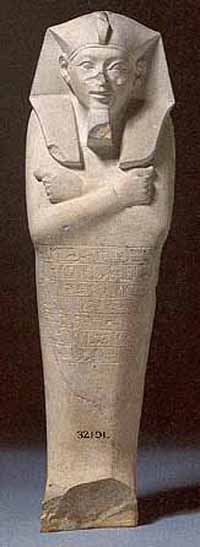
Ahmose I, is less well known to the general public, but unquestionably of major importance to Egyptian history. He reigned between approximately 1550 BC-1525 BC.
During his reign Egypt was finally and completely liberated from the Hyksos. Examination of his well preserved mummy suggest he was about 35 when he died.
Ahmose I (Amosis to the Greeks) was given the birth name Ah-mose (The Moon is Born).
His thrown name was Neb-pehty-re (The Lord of Strength is Re). He was probably a boy when he assumed the thrown, having lost his father Seqenenre Taa II, the last king of the 17th dynasty, and his brother Kahmose within three years of each other. He was 10 years old when he assumed the throne.
His mother was Queen Ashotep, a powerful woman who was perhaps his co-regent during his early years.
Egyptologists believe that during his very early reign, little was probably accomplished and perhaps the Hyksos may have even gained some ground, recapturing Heliopolis. However, by the end of his first decade in power, we know from an autobiography of Ahmose, son of Ibana, a naval officer from El-Kab, that he laid siege on Avaris (The tomb of Ahmose Pennekheb, another soldier also records the campaigns).
This was a long battle interrupted by the need to put down insurrections in already liberated territories, but appears to have been successful sometime between his 12th and 15th year as ruler. Afterwards, he attacked the southwest Palestinian fortress of Sharuhen in a six year siege that would finally put an end to Hyksos control of Egypt.
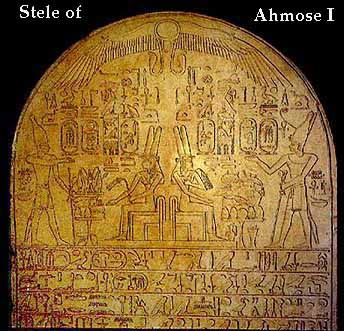
Next, he turned his attention to Nubia (Kush) and, while Kamose (his predessor) may have gained some ground prior to his death, Ahmose I pushed the boundaries south to the Second Cataract.
Here, he established a new civil administration at Buhen probably initially headed by a Viceroy named Djehuty. Apparently, while Ahmose I was in Nubia, former Kyksos allies again attempted a few uprising in the north lead by an arch enemy of Kamose named Teti-en.
In this instance, Ahmose I's mother, Ahhotpe, was probably responsible for putting down the rebellion and for this she was awarded the gold flies, an award for valor that was found on her mummy in her intact tomb at Thebes.
After Ahmose I's campaigns in Nubia, he once again returned to Palestine during his 22nd year in power and may have fought his way as for as the Euphrates, according to information on a stela of Tuthmosis I.
Amosis married his sister, Ahmose-Nefertiri, and had a number of children including:
Merytamun - eldest daughter of Ahmose-Nefertari (died young)
Tair - daughter of Kasmut
Satamun - 2nd daughter of Ahmose-Nefertari (died infant)
Sapair - eldest son of Ahmose-Nefertari (died young)
Saamen - 2nd son of Ahmose-Nefertari (died infant)
Aahotep - 3rd daughter of Ahmose-Nefertari (Queen)
Amenhotep I - 3rd son of Ahmose-Nefertari (King)
Satkames - 4th daughter of Ahmose-Nefertari (died aged ~30)
Henttameh- daughter of Thenthapi
Ahmose - daughter
We also know from Ahmose, son of Ibana that he supported his reign and rewarded local princes who had supported the Theban cause during the Second Intermediate Period by gifts of land (as recorded in Ahmose, son of Ibana's tomb at el-Kab).
We also know that he initiated some temple building projects, notably at Abydos. Though we know he reopened the Tura limestone quarries, little survives of his construction apart form a few additions to the temples of Amun and Montu at Karnak.
A recent Dutch-Egyptian team of archaeologists believe they may have unearthed the remains of Ahmose's palace in the Al-Dabaa area in the Sharqiya Governorate of Egypt, a location that was probably the ancient Hyksos capital.

He was buried in the Dra Abu el-Naga area, but his tomb has yet to be found.
His actual mummy was found in the Deir el-Bahari cache. He did have a cenotaph at South Abydos, consisting of a cliff temple and a pyramid and temple on the edge of the Nile valley.
The pyramid which measures about 70 meters square is the last known royal example built in Egypt. Some battle scene decorations within the pyramid may have depicted his wars with the Hyksos. In these scenes are some of the earliest representation of horses in Egypt.
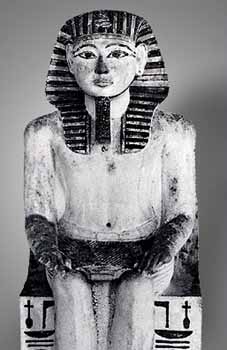
The son of Ahmose and Queen Ahmose Nefretiri, Amenhotep I was the second king of the18th Dynasty. He may have ascended to the throne at a relatively young age, for an elder brother had been designated as heir only about five years earlier. He may have even served a brief co-regency with his father, however. He evidently carried on many of the practices of his father, and his mother certainly played an important part in his reign, acting as God's Wife of Amun.
Amenhotep I may have been married to his sister, (Ahmose-) Merytamun, though there is apparently little documentation to substantiate this relationship. Better known is this king's daughter, Satamun, who is known both from her coffin found in one of the royal mummy caches, and from two statues at central and southern Karnak.
Because of chronology problems, the king's rule is uncertain. We believe that a heliacal rising of Sirius was seen during his reign, as recorded by the Papyrus Ebers, which states:
Ninth year of the reign of his majesty the king of Upper and Lower Egypt, Djeserkare - may he live forever! Festival of the New Year: third month of summer, ninth day - rising of Sirius.
If this is evidence for a helical rising of Sirius, the astronomical calculation gives the date 1537 BC for the rising, and therefore 1546 BC for the beginning of Amenophis' reign, but only if the astronomical observation was made at Memphis. If, however, the observation was made at Thebes - which would logically have been the reference point if it was the capital - twenty years have to be deducted from the figure, giving the date of 1517 BC for the astronomical event and 1526 BC for the coronation of Amenophis I
Most Egyptologists assign Amenhotep I a reign of 25 or fewer years. However, it should be mentioned that on a number of his monuments at the Temple of Karnak are found various Jubilee (Sed-festival) scenes. The Sed-festival was normally celebrated after 30 years of the king's rule, but in this case the structure may have been built in anticipation of the festival.
Amenhotep was this kings birth name, which means 'Amun is Pleased'
He is also known as Amenhotpe I, and Amenophis I by the early Greeks.
His throne name was Djeser-ka-re, or 'Holy is the Soul of Re'.
His Horus name was Ka-Waf-Taw - 'Bull who conquers the land'.
His 'Two Ladies' name was Aa-nerw - 'He who inspires great terror'
Regardless of the ferocity of his name, Amenhotep I seems to have had a fairly peaceful reign. He may have faced a Libyan uprising his first year as king, but if he did, Amenhotep I successfully overcame the ancient enemies preventing an invasion in the Delta area. We learn from inscriptions provided by Ahmose son of Ebana, with verification from Ahmose-Pen-Nekhbet, that Amenhotep I also led a military expedition into Kush (Nubia) in about year eight of his reign past the second cataract of the Nile, and apparently after his victory, brought captives back to Thebes. However, this appears to have been little more than a skirmish. He appointed a man named Turi as Viceroay of Kush, and established a temple marking Egypt's southern boundary at the Nubian down of Sai.
Because of perhaps a dozen years of peaceful rule during Amenhotep I's reign, his accomplishments included elaborate building work. Amenhotep I repaired and restored many ancient temples along the Nile.
We find evidence of his work in Upper Egyptian sites such as Elephantine, Kom Ombo, Abydos, and the temple of Nekhbet, but he seems to have done little building work in Lower Egypt.
Many of the sites where Amenhotep I built had also seen activity by his father, and at Abydos, for example, he erected a chapel commemorating Ahmose I.
But the building projects Amenhotep I is best known for were at the Temple of Karnak in Thebes where he utilized different types of stone including alabaster from Hatnub (and Bosra) and sandstone from the quarries of Gebel el-Silsila.
Amenhotep I was responsible for a large, limestone gateway at Karnak that has now been reconstructed. It was decorated with Jubilee festival decorations. The gate may have at one time been the main south entrance that was later replaced by the Seventh Pylon. He also had a bark shrine built for the god Amun that was probably erected in the west front court of the temple.
Later, Amenohotep III would use some of his predecessor's work at Karnak as fill for his Third Pylon, including a sacred bark chapel of the finest alabaster and a limestone copy of the White Chapel of Senusret I.
Many of Amenhotep I's relief carvings on the limestone monuments at Karnak are so much of a conscious emulation of Senusret I's artists that it has been difficult for archaeologists to determine to whom they should be assigned.
Apparently, his building works were caused him to also restore the mines at Serabit el-Khadim in the Sinai where he also expanded the Middle Kingdom temple of Hathor.
It would seem that by the end of Amenhotep I's reign, the main characteristics of the 18th Dynasty had been established, including a clear devotion to the cult of Amun at Karnak, its successive military conquests in Nubia and its closed royal family with a developing administrative organization drawn from powerful families and collateral relatives.
Amenhotep I was given the rare honor of being declared a titular god upon his death by the priests. He was regarded as the patron god of the Theban necropolis, alongside his mother, Ahmose Nefretiri, who's posthumous renown probably exceeded that of her son. In fact, her name appears in the litany of Amenhotep I's own cult.
Amenhotep I and his mother were especially worshipped at Deir el-Medinaon the west bank at Thebes, where the craftsmen and who build and decorated the royal tombs lived. This community was probably either established in his or his father's reign.
Peret, the third month in ancient Egypt, was devoted to and named after Amenhotep I, and several rituals dramatizing his death, burial and resurrection took place at Deir el-Medina during the month of Peret. However, Amenhotep I became a fairly major deity with a number of festivals throughout the year.
The king and his mother's cult remained strong, particularly at Deir el-Medina, throughout the New Kingdom. However, most houses during the Ramessid era contained, in their front rooms, a scene honoring the two. They were usually depicted with black or blue skin, the colors of resurrection, and so were associated with that religious element.
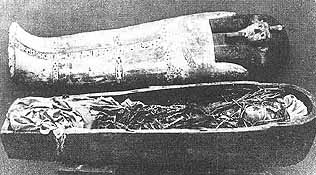
He was probably the first pharaoh to build his tomb some distance from his mortuary temple, a practice that would be emulated by his successors.
While the mortuary temple itself has been located, his tomb remains a mystery. Some Egyptologists believe it to be an uninscribed tomb at Dra Abu el-Naga, outside of theValley of the Kings, while others believe it might be KV 39 within the Valley proper.
While we have not established its location, and inspection report on the tomb in year 16 of Ramesses IX's rule reported the tomb to be intact at that time. His mummy, along with his father's and a number of others, was found in excellent condition in the royal mummy cache of 1881.
Some information appears to indicate that Amenhotep I's son died in infancy, while other resources tell us he died childless.
At any rate, his military commander, Tuthmoses (I), who was married to the king's sister, princess Ahmose, assumed the throne upon Amenhotep I's death.
There is even a possibility that Tuthmosis I was a grandson of Ahmose, the father of Amenhotep I. He may have even served as a co-regent prior to Amenhotep I's death.
It should be noted that Papyrus Ebers, which dates from Amenhotep I's rule and is now in the Leipzig Museum, is one of our main sources of evidence on ancient Egyptian medicine. Also, the existence of a festival calendar recorded on this papyrus, along with other evidence suggesting an increased interest in astronomical observations, suggest that Amenhotep I may possibly have wished to rework earlier calendars.
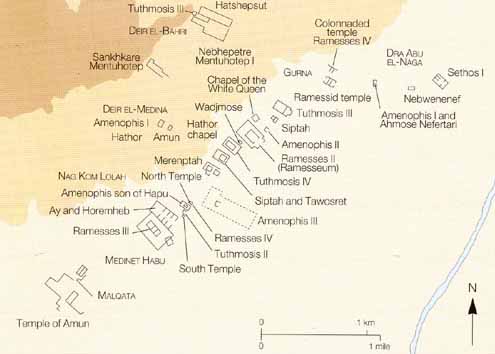
THE NEW KINGDOM - DYNASTY 18 (1540-1070)
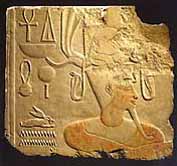
Third King of Egypt's 18th Dynasty was a commoner by birth and a military man by training. We do not know his fathers name, but his mother was Semiseneb, a rather common name during the Second Intermediate Period and the early 18th Dynasty. He had married Ahmose, who may have been a sister of Amenhotep I and daughter of Ahmose I and Queen Ahmose Nefertary (who still held the title, 'God's Wife of Amun' during her grandson's rule) and thus legitimized his rule.
However, others have suggested that Ahmose was in fact Tuthmosis I's own sister. He may have also served as a co-regent under Amenhotep I, and was most certainly an important military commander under his predecessor.
His birth name we are told was Tuthmosis, meaning "Born of the god Thoth", though this is a Greek version.
His actual Egyptian name was Djehutymes I, but he is also sometimes referred to as Thutmose I, or Thutmosis I.
His thrown name was A-Kheper-ka-re (Aakheperkara).
He gained the thrown at a fairly late age, and may have ruled for about six years.
The Oxford History of Ancient Egypt gives his reign lasting from 1504-1492 BC, while Peter Clayton indicates 1524-1518 and Monarchs of the Nile as 1503-1491.
Nevertheless, he staged a series of brilliant military campaigns that were to establish Egypt's 18th Dynasty. So effective were these efforts that we believe he must have started preparations the the military operations during the last years of Amenhotep I's rule.
Ahmose son of Ebana, an admiral during Tuthmosis I's reign, tells us that a campaign into Nubia where he penetrated beyond the Third Cataract was highly successful. Tuthmosis may have defeated the Nubian chief in hand to hand combat and returned to Thebes with the body of the fallen chief hanging on the prow of his ship.
His greatest campaigns were in the Delta and his battles against the Syrians as he finally reached the Euphrates River. This expedition opened new horizons that led later to Egypt's important role in he trade and diplomacy of the Late Bronze Age Near East.
Tuthmosis I brought Egypt a sense of stability and his military campaigns healed the wounds of Thebians.
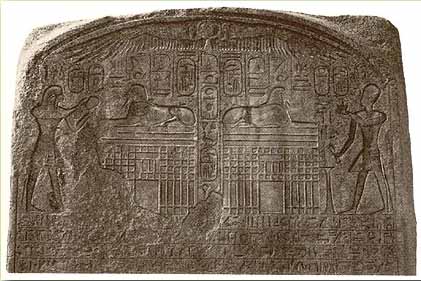
Tuthmosis I's Abydos Stele
We learn from his Abydosstele of his building works at Thebes. His architect, Ineni, built an extension to the temple of Amun atKarnak, adding pylons (the fourth and fifth), courts, statues and one of Egypt's largest standing Obelisks. To commemorate his victory he built a hypostyle hall made entirely of cedar wood columns..
He also expanded the Treasury begun by his predecessor at the northeast corner of the complex. The Abydos stele also tells us that Tuthmosis I he made contributions to the temple of Osiris, including cult objects and statues.
Further, he apparently did some substantial work at Giza.
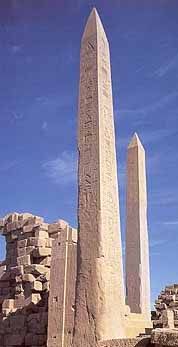
His Obelisk at Karnak, with that of Hatshepsut behind
He was responsible for a number of building projects within Egypt proper, where he left indications of structures at Elephantine, Armant, Ombos (near the late 17th to early 18th Dynasty palace center at Deir el-Ballas), el-Hiba, Memphis and probably at Edfu.
However, there are also a number of monuments in Upper and Lower Nubia left by Tuthmosis I and his viceroy, Turi. We believe that there are several structures that may date from his reign near Kenisa at the fourth cataract and at Napata. Traces of ruins also exist at Semna, Buhen, Aniba, Quban and Qasr Ibrim, though most of these were probably small, or additions to earlier buildings. We also find a few votive objects dedicated in his name in the Sinai at the temple of Serabit el-Khadim.
Ahmose bore him two sons named Wadjmose and Amenmose (though their parentage is a bit uncertain), but they apparently preceded their father to the grave. So it was by Mutnofret (Mutnefert), a minor queen who was the sister of his principle wife, Ahmose, that his heir, Tuthmosis II was born.
However, his more famous offspring was Queen Hatshepsut, a daughter by Ahmose who would rule after her husband and brother's death. After the death of Ahmose, he probably even took Hatshepsut as his own wife until his death. Ahmose may have also provided him with another daughter by the name of Nefrubity who is depicted with Tuthmosis I and Ahmose in the temple of Hatshepsut at Deir el-Bahri.
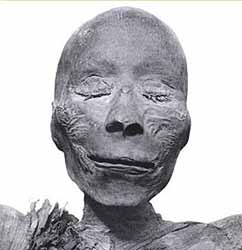
His mummy discovered in the Deir el Bahri Cache
We think that Tuthmosis I buried in two different tombs in the Valley of the Kings on the West Bank at Luxor (ancient Thebes).
It appears that he may have originally been buried in KV 20, which may have been intended as a tomb for both him and his daughter, Hatshepsut. It contained two yellow quartzite sarcophagi, one inscribed for him and the other for his daughter, as well as a canopic chest for her.
However, when KV 38 was investigated by Victor Loret in 1899, he found a sarcophagus for the king in that tomb as well.
It is possible that his grandson, Tuthmosis III had his grandfather's body removed from the tomb of his despised stepmother's burial and relocated it to KV 38. However, his remains were found in the cache, with others, at Deir el Bahri.
Tuthmosis II might never have ruled Egypt but for the early death of Wadjmose and Amenmose, the eldest sons of Tuthmosis I, leaving him as the only heir. He became the fourth ruler of Egypt's 18th Dynasty.
He was apparently the oldest son of Mutnefert, a minor royal queen of Tuthmosis I, who was herself the sister of Tuthmosis I's principal queen, Ahmose.

In order to strengthen his position and legitimize his rule, he was married to Hatshepsut, the oldest daughter of Tuthmosis I and Queen Ahmose. She was very possibly older then Tuthmosis II. During this period, Hatshepsut also carried the title, "God's Wife of Amun", a position she may have had even before the death of Tuthmosis I. Hatshepsut would have been both Tuthmosis II's half sister and cousin. In the light of history she became a much better known pharaoh then her husband.
It is believed that Tuthmosis II had only one son by a harem girl named Isis (or Iset). However, Tuthmosis III would have to wait to rule Egypt until after Hatshepsut death.
Tuthmosis II must have realized the ambitions of his wife, because he attempted to foster the ascent of his son to the throne by naming his son as his successor before he died. But upon Tuthmosis II's death, his son was still very young, so Hatshepsut took advantage of the situation by at first naming herself as regent, and then taking on the full regalia of the pharaoh. He may have also had as many as two daughters by Hatshepsut. We are fairly sure one of them was named Neferure and another possible daughter named Neferubity.
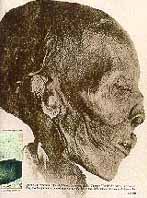
The mummy of Tuthmosis II
We know that Tuthmosis II was a physically week person, and many Egyptologists speculate that even during his rule, Hatshepsut may have been the real power behind the throne.
It is believe that Tuthmosis II (Born of the God Thoth) which was his birth name (called by the Greeks), ruled for about fourteen years before dying in his early thirties. However, recent scholars wish to have his rule shortened to three years. He is also sometimes called Thutmose II, or Thutmosis II and his throne name was A-kheper-en-re., which means "Great is the Form of Re"
The Oxford History of Egypt places his reign from 1492-1479, while the Chronicle of the Pharaohs provides dates of 1518 to 1504. Aidan Dodson's Monarchs of the Nile gives his reign as 1491-1479 BC.
We know that he sent campaigns to Palestine and Nubia, attested to by a short inscription in the temple at Deir el-Bahari and a rock-cut stele at Sehel south of Aswan. We are told that he had to crush a revolt in Nubia in his first year and that this bought about the demise of the kingdom of Kush at Kerma. Apparently, to punish the Kushites for their rebelion, he had everyone put to death with the exception of a royal son, who was bought back to Egypt as a hostage. We are told that the Palestine campaign was against the Shosu Bedouin in the region of Nahrin. However, the term Shosu may also refer to Nubians, and some Egyptologists believe that this reference really relates to the campaign in Nubia.
We also have evidence of Tuthmosis II's building projects. Traces of a temple built by him have been found just north of the temple of Medinet Habu on the West Bankat Luxor (ancient Thebes).
This small temple, known as Shespet-ankh (Chapel of Life), was finished by his son, Tuthmosis III. He also had built a pylon shaped limestone gateway in front of the Fourth Pylons forecourt at Karnak which also had to be completed by Tuthmosis III. The material from this gate and another limestone structure were later reused in the building of Karnak's Third Pylon foundation.
However, the gate has since been rebuilt in Karnak's Open Air Museum. Scenes on the gate sometimes depict Tuthmosis II with Hatshepsut, and sometimes Hatshepsut alone. On one side of the gate, Tuthmosis II is shown receiving crowns, while other scenes depict his daughter, Nefrure and Hatshepsut receiving life from the gods. We also know of a building project in Nubia at Semna and Kumma, and surviving blocks from his buildings at Elephantine.
A statue of Tuthmosis II was found at Elephantine that was probably commissioned by Hatshepsut.
We have not really identified either a tomb or a completed mortuary complex for Tuthmosis, though his mummy was found in a royal cache of mummies located at Deir el-Bahari.

Pharaoh Hatshepsut Maatkare
The Queen Who Would Be King - 1473-1458 B.C.
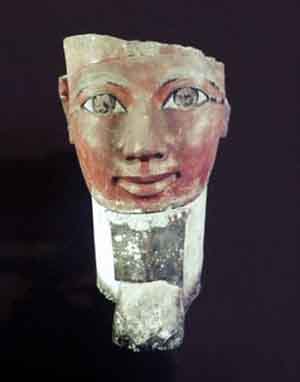
Hatshepsut was an 18th-dynasty pharaoh who was one of the handful of female rulers in Ancient Egypt. Her reign was the longest of all the female pharaohs. Her funerary temple still stands as a tribute to her incredible rise to power.
Men-kheper-re - Lasting is the Manifestation of Re
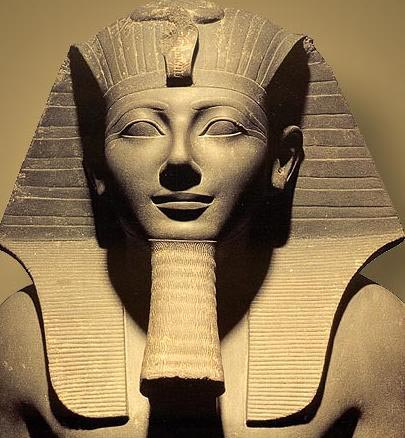
During the rule of hatshepsut he stayed well in the background, and perhaps even demonstrated some amount of cunning in order to simply keep his life. Because of the prowess he would later demonstrate on the battlefield, we assume he probably spent much of Hatshepsut's rule in a military position. To an extent, they did rule together, he in a foreign military position, and her taking care of the homeland. When Hatshepsut finally died, outliving her powerful ministers, Tuthmosis III was at last able to truly inherit the thrown of Egypt, and in doing so, proved to be a very able ruler.
It was not until the last years of his reign that he demonstrated what must have been some anger with his stepmother by destroying as much of her memory as possible. Her images were expunged from monuments throughout Egypt.
This is obvious to most visitors of Egypt because one of the most effected monuments was her temple at Deir el-Bahari. There, Tuthmosis III destroyed her reliefs and smashed numerous statues into a quarry just in front of the temple. He even went so far as to attack the tombs of her courtiers.
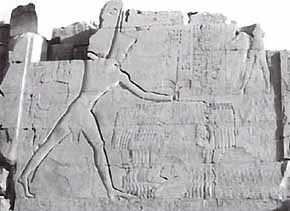
Tuthmosis III became a great pharaoh in his own right, and has been referred to as the Napoleon of ancient Egypt (by the Egyptologists, James Henry Breasted). But perhaps is reputation is due to the fact that his battles were recorded in great detail by the archivist, royal scribe and army commander, Thanuny. The battles were recorded on the inside walls surrounding the granite sanctuary at Karnak, and inscriptions on Thanuny's tomb on the west bank state that, "I recorded the victories he won in every land, putting them into writing according to the facts". Referred to as the Annals, the inscriptions were done during Tuthmosis' 42nd year as pharaoh, and describe both the battles and the booty that was taken. These events were recorded at Karnak because Tuthmosis's army marched under the banner of the god, Amun, and Amun's temples and estates would largely be the beneficiary of the spoils of Tuthmosis' wars.
Having close ties with his military, Tuthmosis undoubtedly received sage advice from his commanders. It was probably decided that the Levant offered the greatest potential for glory and wealth if the trade routes dominated by Syrian, Cypriot, Palestinian and Aegean rulers could be taken.
Tuthmosis III fought with considerable nerve and cunning. On one campaign, he marched to Gaza in ten days and from Yehem, planned the battle to take take Megiddo which was held by a rebellious prince named Kadesh. There were three possible approaches to Megiddo, two of which were fairly open, straightforward routes while the third was through a narrow pass that soldiers would only be able to march through in single file.
Though he was advised against this dangerous pass by his commanders, Tuthmosis not only took this dangerous route, but actually led the troops through. Whether by luck, or gifted intuition this gamble paid off, for when he emerged from the tight canyon, he saw that his enemies had arranged their armies to defend the easier routes
He emerged between the north and south wings of the enemy's armies, and the next day decisively beat them in battle. It apparently took a long siege (seven months) to take the city of Megiddo, but the rewards were great. The spoils were considerable, and included 894 chariots, including two covered with gold, 200 suites of armor including two of bronze, as well as over 2,000 horses and 25,000 other animals.
Tuthmosis III had marched from Thebes up the Syrian coast fighting decisive battles, capturing three cities, and then returned back to Thebes. Over the next 18 years, his armies would march against Syria every summer and by the end of that period, he established Egyptian dominance over Palestine. At Karnak he records the capture of 350 cities, and in the 42nd year of his rule, Kadesh itself was finally taken.
He also made campaigns into Nubia where he built temples at Amada and Semna and restored Senusret III's old canal in his 50th year of rule so that his armies could easily pass on their return to Egypt.
Queens and Vassals
Tuthmosis' main queen was Hatshepsut-Merytre, who survived him and lived as Queen Mother into the reign of her son. However, he also had several minor queens, some of whom had been acquired due to diplomatic exchanges. We know the names of three such minor queens, Menhet, Menwi and Merti from the discovery of their tomb west of Deir el-Bahri. He also took a number of foreign prices hostage, who then received training and indoctrination in Egyptian ways. They would later be returned to their homeland as obedient vassals of Egypt.
Building Projects
Tuthmosis is well attested in many parts of Egypt and outside of Egypt. We find blocks deep within Nubia at Gebel Barkal, and also at Sai, Pnubs at the third cataract, Uronarti, Buhen, Quban, Faras and Ellesiya, as well as his temples at Amada and Semna. He also built a temple dedicated to the goddess Satet at Elephantine, as well as projects at Kom Ombo, Edfu, ElKab, Tod, Armant, Akhmim, Hermopolis and Heliopolis. From a list of one of Tuthmosis' overseers, we also know of projects at Asyut, Atfish and various locations in the delta.
Tuthmosis III built his own temple near Hatshepsut's on a ledge between her temple and that of Mentuhotep. His small temple was excavated recently by a polish mission. The excavation revealed stunningly fresh reliefs, perhaps because a rock fall from the cliffs above covered the temple shortly after its completion. Close by, Tuthmosis built a rock cut sanctuary to the goddess Hathor. This monument was accidentally discovered by a Swiss team when a rock fall exposed its opening.Apparently, the shrine was in use up to the Ramesside period, when it was destroyed by an earthquake.
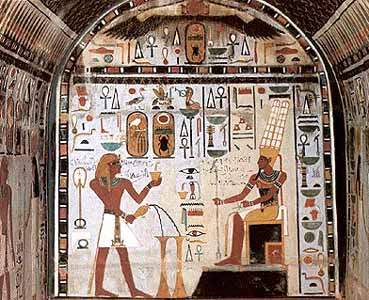
Tuthmosis III's Temple of Hathor
Of the many monuments associated with Tuthmosis III, none faired better then the temple of Karnak. Wall reliefs near the sanctuary record the many gifts of gold jewelry, furniture, rich oils and other gifts offered to the temple,. mostly from the spoils of war, by Tuthmosis III. He was responsible for the Sixth and Seventh Pylons at Karnak, as well as considerable reconstruction within the central areas of the temple. He erected two obelisks at the temple, one of which survives at the Hippodrom at Istanbul. There is also a great, black granite Victory Stele embellishing his military victories.
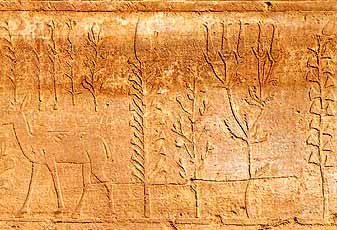
He also built a new and very unique temple at Karnak that is today referred to as his Festival Hall. The columns are believed to represent the poles of the king's campaign tent.
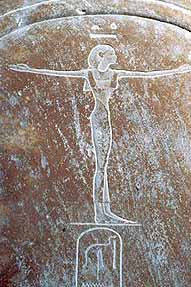
The tomb of Tuthmosis III (KV 34) is said to be one of the most sophisticated tombs in the Valley of the Kings.
Discovered by Victor Loret's workmen in 1898 during this famous Egyptologist's absence, work did not begin on clearing the rubble form the entrance until his return. He then excavated the site meticulously, using 24 square grids and recording the placement of even the smallest of objects.
The tomb itself can be found in a narrow gorge at the bottom of the Valley of the Kings. The entrance is 30 meters above ground level, but of course this did not stop ancient tomb robbers, though Loret did find some funerary furniture that had been left behind.
The orientation of the tomb is such that the entrance lies in the north, while the burial chamber deviates to the east, a tradition originating with the Middle Kingdom Pyramid of Sesostris II.
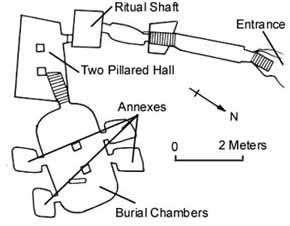
This complex path symbolized the region of the netherworld. Typically for this period, but a first for the Valley of the King's proper, the tomb begins with a stairway, a corridor, a second stairway and a second corridor before reaching the ritual shaft. The ceiling of the ritual shaft is painted with a blue sky and yellow stars. After the ritual shaft, like most tombs of this period, there is a 90 degree turn into the Vestibule, which is then followed by the burial chamber with its four lateral annexes. While the passages are not decorated, other areas were plastered and painted for the first time.
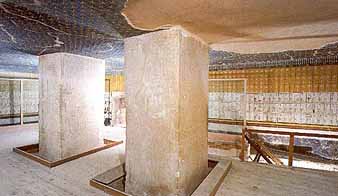
The vestibule has two pillars, and is decorated with the 741 divinities of the Amduat that generate the daily sun. A flight of stairs leads directly from there to the burial chamber, which is oval and also has two pillars. The oval burial chamber is common also to the tombs of Thutmosis I and Thutmosis II.
The burial chamber is large, and holds a beautiful red quartzite sarcophagus. However, Tuthmosis III's mummy was not found here, bur rather in tomb DB 320 at Deir el-Bahri (in 1881).
The walls of the burial chamber are designed like a huge ornamental scroll, with the complete text of the Book of Amduat.
The ancient Egyptians called this book the "Book of the Secret Room". Amduat meant "that which there is in the afterlife", and the book is divided into twelve parts, representing the hours of the night.
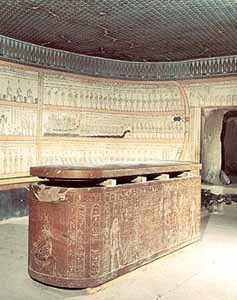
On the two square pillars of the burial chamber, and for the first time, we find passages from the Litanies of Re on seven of the surfaces, and on the eighth a unique scene in which the king is shown being nursed by a divine tree goddess labeled". It is likely, however, that these pillar decorations were added hastily, after the king's death.
This tomb had been brutally plundered by reckless robbers. They took no care whatsoever to prevent damage, and in some instances demonstrated almost a violent hatred, throwing objects forcefully against the walls, where traces of gold foil may still be seen. The principal item of funerary equipment found in the tomb was the sarcophagus.
Other items included a number of wooden statues of the king and various deities, pieces of wooden model boats, pottery and bones from a baboon and a bull.
However, a foundation deposit was also discovered that contained model tools, plaques and vessels. A number of other items from the tomb were also discovered by Daressy, Carter and John Romer in other areas of the Valley of the Kings. In the rear is a a small room with representations of animals and plants bought back from Syria during the 25th year of his reign. For obvious reasons, this room is referred to as the Botanical Garden.
The opulence of his reign is also reflected in the quality tombs built by his high officials. The tome of his vizier, Rekhmire is notable, with many scenes of daily life, crafts as well as a long inscription concerning the office of vizier. However, the presence of a military elite is also attested by no less then eleven Theban tombs from the reign of Tuthmosis.
He was buried in tomb KV 34 in the Valley of the kings. The tomb was halfway up a cliff face, and after his burial, masons destroyed the stone stairway leading up to it and concealed the tomb's entrance.
However, it would seem that no matter what initiatives pharaohs took to protect their tombs, robbers were sure to find them. Indeed, in 1898 when his tomb was discovered by Victor Loret, all he found was the carved sarcophagus and some remains of smashed furniture and wooden statues. Tuthmosis III, mummy likewise was not in the tomb, for it had been found in 1881 in the great royal cache at Deir el-Bahari. However, the tomb is covered with black and red painted hieratic renditions of the netherworld texts.

Amenhotep II was the 7th Pharaoh of Egypt's18th Dynasty.
Amenhotep (heqaiunuwas) his birth name, meaning "Amun is Pleased, Ruler of Heliopolis He is sometimes referred to by Amenhotpe II, or the Greek version of his name, Amenophis II. His throne name was A-kheperu-re, meaning "Great are the Manifestations of Re".
He was the son of Tuthmosis III, with whom he may have served a short co-regency of about two years. His mother was probably Merytra, a daughter of Huy, who was a divine adoratrice of Amun and Atum and chief of choristers for Ra. Apparently, she also served as, at least his publicly acknowledge, wife.
Amenhotep II's reign is considered pivotal by many Egyptologists, though it is certainly popularly overshadowed by that of his two predecessors and some of his successors of the 18th Dynasty. He is generally acknowledged to have taken care of his military duties early on, thereafter establishing a peaceful and prosperous reign suitable to fairly extensive expansion of temple monuments.
Notably, Amenhotep II was well known for his athletic abilities as a young man. A number of representations of him depict his participation in successful sporting pursuits. He lived in the Memphite region where he trained horses in his father's stables, and one of his greatest athletic achievements was accomplished when he shot arrows through a copper plate while driving a chariot with the reins tied about his waist.
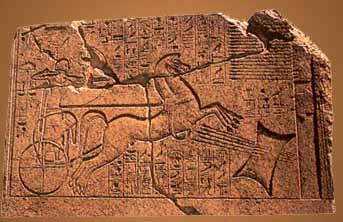
This deed was recorded in numerous inscriptions, including a stele at Giza and depictions at Thebes. So famous was the act that it was also miniaturized on scarabs that have been found in the Levant. Sara Morris, a classical art historian, has even suggested that his target shooting success formed the basis hundreds of years later for the episode in the Iliad when Archilles is said to have shot arrows through a series of targets set up in a trench. He was also recorded as having wielded an oar of some 30 ft in length, rowing six times as fast as other crew members, though this may certainly be an exaggeration.
As a king, Amenhotep II's athletic abilities may have served him very well, for within a short period after gaining the throne, his metal would be tested. Various sources disagree on how many military expeditions he made into Syria, and in what year of his reign these occurred. These military actions are recorded on stele erected at Amada, Memphis and Karnak.
Yet it is clear that there had been a revolt in the Syrian region, and possibly even in the ports on the Mediterranean sea. His father was well recognized as a military leader, sometimes referred to as the "Napoleon of ancient Egypt". Therefore it is perhaps not surprising that when a region in Syria known as Tikhsi heard of his father's death, they decided to test the new pharaoh (apparently not an uncommon practice).
Some references refer to his first expedition taking place as early as his 2nd year of rule, though others provide that it was during his 7th. Still other references indicate that he made both of these campaigns. Regardless, he fought his was across the Orontes river and claims to have subdued all before him. One city, Niy, apparently had learnt their lesson under his father, and welcomed Amenhotep II. But at Tikhsi (Takhsy, as mentioned in the Theban tomb of Amenemheb - TT85), he captured seven prices, returning with them in the autumn. They were hung face down on the prow of his ship on the return journey, and six of them were subsequently hung on the enclosure wall of the Theban temple. The other was taken south into Nubia where his was likewise hung on the walls of Napata, "in order to cause to be seen the victorious might of His Majesty for ever and ever".
According to the Stele recording these events, this first campaign netted booty consisting of 6,800 deben of gold and 500,000 deben of copper (about 1,643 and 120,833 pounds respectively), as well as 550 mariannu captives, 210 horses and 300 chariots.
All sources agree that he once again campaigned in Syria during his ninth year of rule, but only in Palestine as for as the Sea of Galilee.
Yet these stele, erected after year nine of Amenhotep II's rule, that provide us with this information do not bear hostile references to either Mitanni or Nahrin, the general regions of the campaigns. This is probably intentional, because apparently the king had finally made peace with these former foes. In fact, an addition at the end of the Memphis stele records that the chiefs of Nahrin, Hatti and Sangar (Babylon) arrived before the king bearing gifts and requesting offering gifts (hetepu) in exchange, as well as asking for the breath of life.
Though good relations with Babylon existed during the reign of Tuthmosis III, this was the first mention of a Mitanni peace, and it is very possible that a treaty existed allowing Egypt to keep Palestine and part of the Mediterranean coast in exchange for Mitannian control of northern Syria. Underscoring this new alliance, with Nahrin, Amenhotep II had inscribed on a column between the fourth and fifth pylons at Karnak, "The chiefs (weru) of Mitanni (My-tn) come to him, their deliveries upon their backs, to request offering gifts from his majesty in quest of the breath of life". The location for this column in the Tuthmosid wadjyt, or columned hall, was significant, because the hall was venerated as the place where his father received a divine oracle proclaiming his future kingship.
It is also associated with the Tuthmosid line going back to Tuthmosis I, who was the first king to campaign in Syria. Furthermore, we also learn that Amenhotep II at least asked for the hand of the Mitannian king, Artatama I, in marriage. By the end of Amenhotep II's reign, the Mitanni who had been so recently a vile enemy of Egypt, were being portrayed as a close friend.
After these initial campaigns, the remainder of Amenhotep II's long reign was characterized by peace in the Two Lands, including Nubia where his father settled matters during his reign. This allowed him to somewhat aggressively pursue a building program that left his mark at nearly all the major sites where his father had worked. Some of these projects may have even been initiated during his co-regency with his father, for at Amada in Lower Nubia dedicated to Amun and Ra-Horakhty celebrated both equally, and at Karnak, he participated in his father's elimination of any vestiges of his hated stepmother, Hatshepsut.
There was also a bark chapel built celebrating his co-regency at Tod.However, he also left monuments at Pnub on Argo Island, at Sai, Uronarti, Kumma, Buhen, Qasr Ibrim, Sehel, Elephantine, Gebel Tingar, Gebel el-Silsila, Elkab, Armant, Karnak, Thebes, including his tomb and a funerary temple, Medamud,
Of these, his building work at Giza and Karnak are particularly notable. At Giza he built a temple dedicated to the god Horemakhet, a sun-god identified with the Great Sphinx. This Sphinx and its adjoining amphitheater became the site of a cult of royal ancestors, including Amenhotep II himself and his son, Tuthmosis IV, who set up the great dream stele between its paws.

The Sphinx's (Horemakhet) cult lasted well into Roman times and pilgrims left votive offerings in the enclosure wall of the amphitheater or in the chapels if possible. Hence, Amenhotep II's addition of a chapel to the cult was significant.
At Karnak, after finishing his father's work of eliminating Hatshepsut's name, he set about creating his sed-festival just as his father had done before him. This pavilion, reconstructed in modern times by Charles Van Siclen, was a court of relief carved square pillars with decorated walls on the sides, and has been dated to the late part of his reign. Following an old tradition, the decorations featured elaborate royal regalia for the king, especially emphasizing solar connections, including multiple sun discs on top of crowns, and tiny falcons set above the sun discs, creating an association with Ra-Horakhty.
It also included scenes of his mother. The building was built in front of Karnak's south entrance at the eighth pylon, which in effect, created a new main gateway to the complex. An inscription on one of the pillars implies that this may not have been to celebrate his first sed festival, though such text is difficult to interpret, and is sometimes though to simply imply wishes expressed for the king's coming jubilees.
The gardens of Amun were directly in front of this chapel, but the building was dismantled at the end of the 18th Dynasty to accommodate alterations made by Horemheb. The material was later reused for a different building constructed by Seti I at the beginning of the 19th Dynasty.
Amenhotep II also built another temple to Amun in the northern Karnak district, a precinct that was later dedicated to Montu of Thebes. However, the material from this project was also later used to form part of the foundations of a temple constructed by Amenhotep III, which was still later adapted to building projects during the Greek Period. However, he apparently participated in several other building projects in the area of Karnak including probably building a ceremonial residence or palace.
Also notable was his additions to nearby temple of Montu at Medamud about eight kilometers north, particularly since later there was a processional way between northern Karnak and Medamud.
Other than his mother, Amenhotep II made public none of his wives, though he certainly demonstrated his procreative powers. A number of princes are attested to, including another Amenhotep, Tuthmosis, Khaemwaset (possibly), Amenemopet, Ahmose, Webensenu and Nedjem, among others. Yet though he probably also sired a number of princesses, they like his queens, are difficult to document.
The lack of documentary evidence of his queens and princesses was doubtless a conscious rejection of the dynastic role played by woman as "god's wives of Amun". Perhaps he (as well as his father) realized that queens such as Hatshepsut, who represented the dynastic family, could be dangerous if they became too powerful.
As usual, different resources provide different time frames for Amenhotep II's reign. While the Chronicle of the Pharaohs by Peter A. Clayton gives his reign lasting from 1453 until 1419 BC, The Oxford History of Ancient Egypt provides a reign between 1427 until 1400 BC. Regardless, upon his death he was buried in the Valley of the Kings on the West Bankat Luxor - (ancient Thebes) in tomb KV35. Prior to the discovery of Tutankhamun's tomb by Howard Carter, KV35 was the only royal burial in Egypt where the pharaoh was discovered in his own sarcophagus. However, he was not alone in his tomb for the priests in antiquity had used it for a hiding place for other royal mummies.
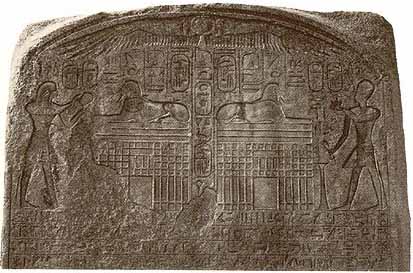
The 8th Pharaoh of Egypt's18th Dynasty.
The Pharaoh Tuthmosis IV, is probably most famous for his Dream Stele, that can still be found today between the paws of the great Sphinx at Giza. Dreams were important in ancient Egypt and were considered to be divine predictions of the future.
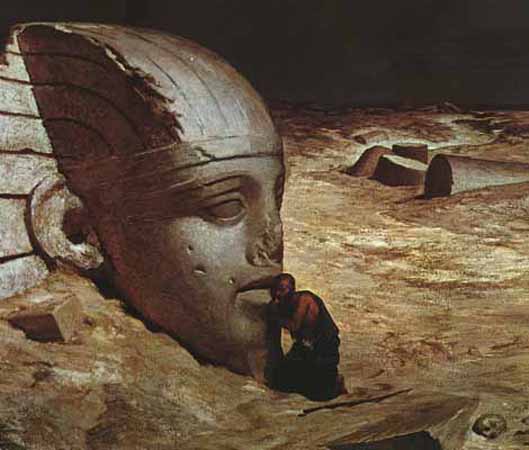 ">
">In Tuthmosis IV's Dream Stele, he tells us that, while out on a hunting trip, he fell asleep in the shadow of the Sphinx (or apparently, the shadow of the Sphinx's head, for the monument was apparently buried in sand at the time). In the young prince's sleep, Re-Harakhte, the sun god embodied in the Sphinx, came to him in a dream and promised that if he would clear away the sand that engulfed the monument, Tuthmosis would become king of Egypt.
The stele reads:
Now the statue of the very great Khepri (the Great Sphix) restin in this place, great of fame, sacred of respect, the shade of Ra resting on him. Memphis and every city on its two sides came to him, their arms in adoration to his face, bearing great offerings for his ka. One of these days it happened that price Tuthmosis came travelling at the time of midday. He rested in the shadow of the great god. (Sleep and) dream (took possession of me) at the moment the sun was at zenith. Then he found the majesty of this noble god speaking from his own mouth like a father speaks to his son, and saying, 'Look at me, observe me, my son Tuthmosis. I am your father, Horemakhet-Khepri-Ra-Atum. I shall give to you the kingship (upon the land before the living)... (Behold, my condition is like one in illness), all (my limbs being ruined). The sand of the desert, upon which I used to be, (now) confronts me; and it is in order to cause that you do what is in my heart that I have waited.
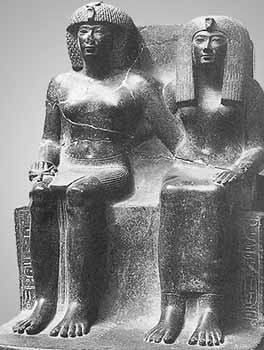
Tuthmosis IV and His Mother, Tiaa
Tuthmosis IV's name means, 'Born of the God Thoth'
His throne name was Men-kheperu-re, meaning 'Everlasting are the Manifestations of Re'. We can also find references to him under the names of Thuthmose IV, Thutmosis IV, and Djehutymes IV.
He was apparently the son of Amenhotep II by his wife, Tiaa, but Egyptologists speculate whether, because of the wording of the 'Dream Stele', his claim on the Egyptian throne was legitimate. In fact, other evidence supports this contention. His father, Amenhotep II, never recognized Tuthmosis as a co-regent, or announced any intent for Thutmosis to succeed him.
We know that Tuthmosis IV was probably married to Mutemwiya, who produced his heir to the throne, Amenhotep III, though he never acknowledged her as either a major or minor queen. It is possible, though now doubted by some, that she was the daughter of he Mitannian king, Artatama, who sent his daughter to the Egyptian court as part of a diplomatic exchange.
Other of his wives included Merytra, who we believe later changed her name to Tiaa (same as his mother's name) and a non-royal wife, Nefertiry. He probably also married one of his sisters named Iaret.
Tuthmosis IV is not the best documented of Egyptian pharaohs. We actually know very little about him in comparison to others of this dynasty. Little military action appears to have occurred during his reign, although our knowledge may be marred by the lack of texts. We do know that there was a Nubian campaign in Year 8 of his rule, and that apparently there were also campaigns in Syria. However, even though the king is referred to twice as the 'conqueror of Syria' these may have actually been little more then policing actions, rather than full scale battles.
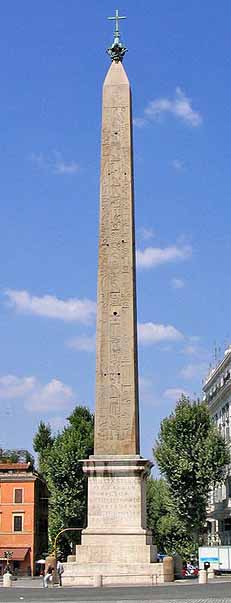
Little is also known of his building work. Tuthmosis IV did finish a giant obelisk that was originally quarried at Aswan under Tuthmosis III, his grandfather. At 32 meters (105 feet) it was the tallest Egyptian obelisk that we know of, and was uniquely intended to stand as a single obelisk at the Temple of Karnak. Most of the obelisks were usually erected in pairs. However, Tuthmosis III originally intended for there to be a pair of these Obelisks. Its counterpart developed a fault during the quarry process, and remains today joined to the bed-rock at Aswan Today, the finished obelisk stands outside St. John Leteran in Rome, rather then in Egypt.
He also began work work at most of Egypt's major temple sites and four sites in Nubia, but almost all of this was simply adding to existing monuments. Most of his work was adding to the temples of his father and grandfather, and perhaps suggesting new sites and monuments to his son.
We know of his minor building projects in the following locations:
His best attested building project we have available today is his own tomb KV 43, located in the Valley of the Kings and discovered by Howard Carter.
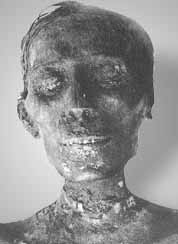
However, his mummy was missing from his tomb, having been found five years earlier in a cache of mummies located in the tomb of Amenhotep II. Perhaps better known are the fine private tombs built by his nobles on the West Bank at Luxor (ancient Thebes) in an area commonly referred to as the Tombs of the Nobles. These include such notable tombs as that of Nakht (TT 52) and Menna (TT 69).
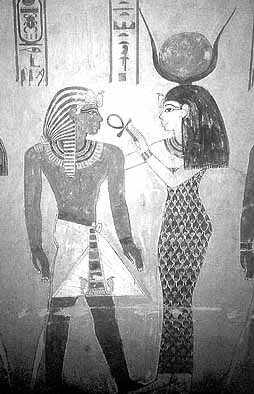
From his tomb, the Deceased Tuthmosis IV
Receiving the Gift of Life from the Goddess, Hathor
Howard Carter made the first modern entrance into the tomb of Tuthmosis IV (KV 43) on January 18th, 1903. This was not an accidental discovery by Carter, for he had been looking for this specific tomb. On February 3rd, it was formally opened.
Like all the tombs of the Valley of the Kings, it had been plundered during antiquity, but there were still some amount of items left.
The tomb is of phase one style, the earliest in the Valley of the Kings, with its L-shaped structure. It follows the general style of KV 35 Amenhotep II) in design, size and complexity, as well as its placement under a storm-fed waterfall.
From the entrance we find a stairway leading to the first corridor, another stairway leading to a second stairway, which in turn leads directly to the ritual shaft. At the bottom of the ritual shaft is another single chamber. The ritual shaft opens directly into a two pillared hall. From the two pillared hall, the tomb takes a 90 degree left turn down another set of stairs to a third corridor, which leads to a final stairway and then an antechamber. The antechamber takes another 90 degree turn into the burial chamber, which has six pillars and four annexes, two on either side. Between the last two pillars of this chamber is a small stairway that leads to the crypt.
This tomb differs from KV 35 in several respects, including the crypt area, the alignment of the storage rooms. Significantly, we find the first occurrences of the 'magical niches' built into the walls which are to be found in all succeeding tombs until the time of Ramesses II.
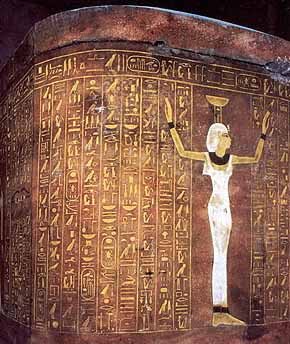
Interestingly, while the tomb was carefully cut, the decorative plan of the tomb is virtually missing. Only the ritual shaft and the anteroom are painted, and these decorations appear to be hastily done. Both areas have ceiling with yellow stars on a dark blue background, and Khekher-friezes appear at the top of the decorated walls, which are painted a golden yellow. Also, in both of these locations, the king appears before various deities, and in each location these scenes are almost exactly the same, with the only material difference being the clothing of the deities.
The Hieratic text found on the south wall of the antechamber was not created by Tuthmosis, but rather by Horemheb. It refers to the robbery during antiquity of this tomb, and Horemheb's efforts to restore the damage made necessary by the illicit entry. Hence, Tuthmosis IV's mummy was not found in this tomb but would later be discovered to be one of those found in the tomb of Amenophis II.
While Tuthmosis IV's mummy was not found in his tomb, there were three subsidiary burials discovered, presumably offsprings of the king. Most all of the funerary equipment that was found was fragmentary, but consisted of the following:
It is believed that Amenhotep III ruled for almost 40 years during the 18th Dynasty of Egypt's history that represented one of its most prosperous and stable periods. It was Amenhotep III's grandfather, Tuthmosis III, who is sometimes referred to as the Napoleon of ancient Egypt, who built the foundation of this success by dominating through military action Egypt's Syrian, Nubian and Libyan neighbors.
Because of that, little or no military actions were called for during his grandson's reign. The small police actions in Nubia that did take place were directed by his son and viceroy of Kush, Merymose (or perhaps an earlier viceroy) .
Amenhotep (or heqawaset) was this kings birth name, meaning " Amun is Pleased, Ruler of Thebes.
His throne name was Nub-maat-re, which means "Lord of Truth is Re."
Amenhotep III's birth is splendidly depicted in a series of reliefs inside a room on the east side of the temple of Luxor. Built by Amenhotep III, the room was dedicated to Amun. However, it portrays the creator god, Khnum of Elephantine at modern Aswan with his ram head, fashioning the child and his ka on a potter's wheel under the supervision of the goddess Isis.
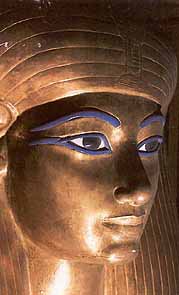
The god Amun is then Tula, mother of Tiy (Tiye) who was the principle queen of Amenhotep III led to Amenhotep III's mother by Thoth, god of wisdom, after which Amun is shown in the presence of the goddesses Hathor and Mut while they nurse the future king
His father was Tuthmosis IV by one of that king's chief queens, Mutemwiya. She may have, though mostly in doubt now, been the daughter of the Mitannian king, Artatama. That queen was indeed probably sent to Egypt for the purposes of a diplomatic marriage.
It is more than likely that Amenhotep III succeeded to the throne of Egypt as a child, sometime between the ages of two and twelve years of age.
There is a statue of the treasurer Sobekhotep holding a prince Amenhotep-mer-khepseh that was most likely executed shortly before Tuthmosis IV's death, as well as a painting in the tomb of the royal nurse, Hekarnehhe (TT64) portraying the prince as a young boy, though not a small child. This, and the fact that his mother is not so very prominently visible, along with other factors, suggests that he was more likely between six and twelve years of age at the time of his father's death.
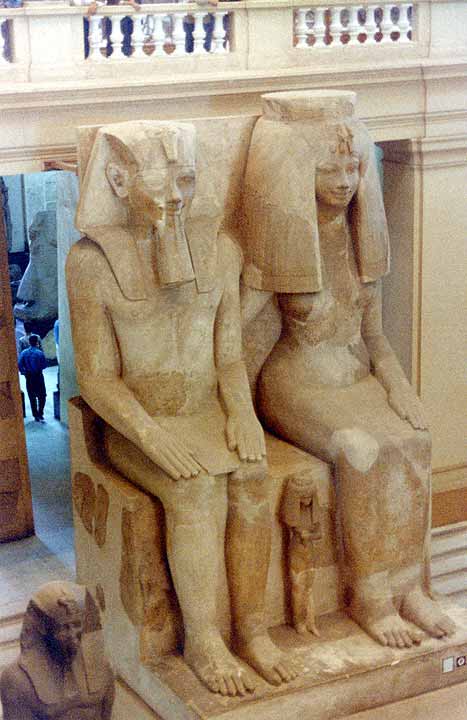
Monumental statue of Amenhotep III and Queen Tiy, along with daughters
It is unlikely that his mother, Mutemwiya, served as a regent for the young king, and whoever may have been in charge at the beginning of his reign seems to have remained in the background.
Amenhotep III's own chief queen, who he married in year two of his reign, was not of royal blood, but came from a very substantial family. She was Tiy, the daughter of Yuya and his wife, Tuya, who owned vast holdings in the Delta. Yuya was also a powerful military leader. Their tomb, numbered KV46 in the Valley of the Kings, is well known.
His brother-in-law by this marriage, Anen, would during his reign also rise to great power as Chancellor of Lower Egypt, Second Prophet of Amun, sem-priest of Heliopolis, and Divine Father. It is possible that the king's early regency was carried out by his wife's family
However, it would seem that Amenhotep collected a large harem of ladies over the years, including several from diplomatic marriages, including Gilukhepa, a princess of Naharin, as well as two of his daughters (Isis and in year 30 of his reign, Sitamun or Satamun, who bore the title "great royal wife" simultaneously with her mother). We can document at least six of his children consisting of two sons and four daughters (other daughters including Henuttaneb and Nebetiah).
However, his probable oldest son, Tuthmosis who was a sem-priest, died early leaving the future heretic king, Amenhotep IV, otherwise known as Akhenaten, as the crown prince.
The King's Early Years
Amenhotep III's reign can be split into two parts, with his earliest years given much to sportsmanship with a few minor military activities. While as usual, an expedition into Nubia in year five of his reign was given grandiose attention on some reliefs, it probably amounted to nothing more than a low key police action.
However, it may have pushed as for as south of the fifth cataract. It was recorded on inscriptions near Aswan and at Konosso in Nubia. There is also a stele in the British Museum recording a Nubian campaign, but it is unclear whether it references this first action, or one later in his reign.
There was also a Nubian rebellion reported at Ibhet, crushed by his son. While Amenhotep III was almost certainly not directly involved in this conflict, he records having slaughtered many within the space of a single hour. We learn from inscriptions that this campaign resulted in the capture of 150 Nubian men, 250 women, 175 children, 110 archers and 55 servants, added to the 312 right hands of the slain.
Perhaps to underscore the Kushite subjection to Egypt, he had built at Soleb, almost directly across the Nile from the Nubian capital at Kerma, a fortress known as Khaemmaat, along with a temple.
The Prosperity and International Relationships
However, by year 25 of Amenhotep III's reign, military problems seem to have been settled, and we find a long period of great building works and high art. It was also a period of lavish luxury at the royal court. The wealth needed to accomplish all of this did not come from conquests, but rather from foreign trade and an abundant supply of gold, mostly from the mines in the Wadi Hammamat and further south in Nubia.
Amenhotep III was unquestionably involved with international diplomatic efforts, which led to increased foreign trade. During his reign, we find a marked increase in Egyptian materials found on the Greek mainland. We also find many Egyptian place names, including Mycenae, Phaistos and Knossos first appearing in Egyptian inscriptions We also find letters written between Amenhotep III and his peers in Babylon, Mitanni and Arzawa preserved in cuneiform writing on clay tablets. From a stele in his mortuary temple, we further learn that he sent at least one expedition to punt.
It is rather clear that the nobility prospered during the reign of Amenhotep III. However, the plight of common Egyptians is less sure, and we have little evidence to suggest that they shared in Egypt's prosperity. Yet, Amenhotep III and his granary official Khaemhet boasted of the great crops of grain harvested in the kings 30th (jubilee) year. And while such evidence is hardly unbiased, the king was remembered even 1,000 years later as a fertility god, associated with agricultural success.
Building Projects
Though a number of Amenhotep III's building projects no longer exist, we find at Karnak almost a complete makeover of the temple, including his efforts to embellish the already monumental temple to Amun, as well as his the East Temple for the sun god and his own festival building.
His impact in the Karnak temple was thematic, leaving the impression of a warrior king whose victories honored both himself and the God Amun, and he changed the face of this temple almost completely. He had his workers dismantle the peristyle court in front of the Fourth Pylon, as well as the shrines associated with it, using them as fill for a new Pylon, the Third, on the east-west axis. This created a new entrance to the temple, and he had two rows of columns with open papyrus capitals erected down the center of the newly formed forecourt. At the south end of Karnak, he began construction on the Tenth Pylon, with a slightly different orientation then that of the Seventh and Eighth, in order for it to lead to a new entrance for the percent of the goddess Mut. He may have even started a new temple for her. To balance the south temple complex, he built a new shrine to the goddess Ma'at, the daughter of the sun-god, to the north of central Karnak.
At Luxor he built a new temple to the same god, including the still standing colonnaded court. That effort is considered a masterpiece of elegance and design and particular credit must be The Colossi of Memnon, given to his mater architect, Amenhotep son of Hapu.
He also built a monumental mortuary temple on the West Bank at Thebes - modern Luxor that is the single largest royal temple known to us from ancient Egypt. Unfortunately, it was built much too close to the flood plain and was in ruins by the 19th Dynasty, when material was quarried from it for new building projects. While some of the ground plan of the temple may be made out, the only material remains are the Colossi of Memnon.
These statues were misnamed by the Greeks, but actually depict Amenhotep III. The southern of the statues also depicts the two most important women in the king's life, his mother Mutemwiya and his wife, Queen Tiy. However, it should be noted that within the grounds of the temple, more fragments of colossal statuary have been found than in any other known sacred precinct. In the fields behind the statues, also stands a great, repaired stele that was once in the sanctuary of his temple, around which are located fragments of sculptures.
The West Bank was also the site of Amenhotep III's huge palace, called Malkata. Fragments of this building remain, unlike most other royal residences. From this scant evidence, it would seem that the walls were plastered and painted with lively scenes from nature. Next to the palace complex he also built a great harbor.
Further south on the west bank at Kom el-Samak, Amenhotep III also built a jubilee pavilion of painted mud brick and at Sumenu, some twenty kilometers south of Thebes the king built a temple dedicated to the cult of the crocodile god, Sobek.
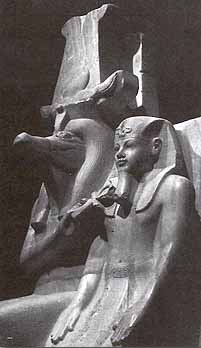
A statue of Amenhotep III and Sobek
Along with these building projects, we also know that he developed and expanded cults at a number of other locations including Amada (for Amun and Ra-Horakhty), Hebenu and Hermopolis, where we find two colossus statues of baboons and an altar. There were other building projects in Egypt proper at Memphis, where blocks of brown quartzite remain from the king's great temple called "Nebmaatra United with Ptah", Elephantine (now destroyed) and a completed chapel at Elkab.
Building elements at Bubastis, Athribis, Letopolis and Heliopolis also attest to the king's interest in the eastern Delta. He also built temples are shrines in Nubia at Quban, Wadi es-Sebua, Sedinga, Soleb and Tabo Island. There were also building elements or stele in his name at Aniba, Buhen, Mirgissa, Kawa and Gebel Barkal.
Artistry of the Period
Artistically, many of the royal portraits of the king in sculptor are truly masterpieces of any historical age. After the Colossi of Memnon, the largest of these is the limestone statue of the king and queen with three small standing princesses discovered at Medinet Habu.
However, many other statues give the king a look of reflection, and bringing to life emotional emphasis. We find grand statues of black granite depicting a seated Amenhotep wearing the nemes headdress, unearthed by Belzoni from behind the Colossi of Memnon and from Tanis in the Delta. Others statues and some reliefs and paintings depict the king wearing the more helmet like khepresh, sometimes referred to as the Blue, or War Crown.
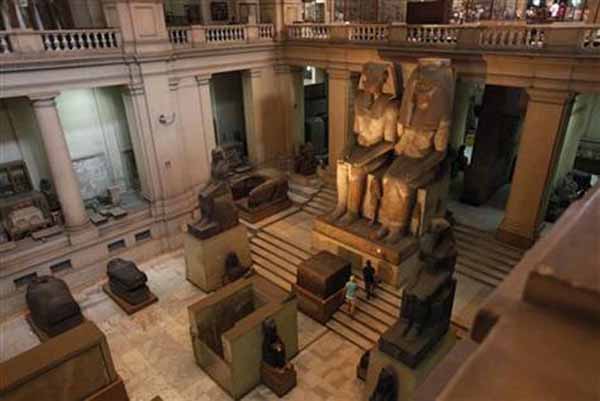
Amenhotep III wearing the Blue Crown
Even in recent years, some statuary of Amenhotep III continues to be discovered, such as an incredible six foot (1.83 meter) high pink quartzite statue of the king standing on a sledge and wearing the Double Crownof Egypt. It was discovered in the courtyard of Amenhotep III colonnade of the Luxor temple in 1989.
This particular statue was unearthed completely intact, with the only damage resulting from a careful removal of the name Amun during the reign of his son. This statue was probably executed late in his reign, regardless of the fact that is shows a youthful king.
So good were many of his statues that they were later usurped by kings, sometimes by them simply overwriting his cartouche with their own. At other times, such as in the case of the huge red granite head found by Belzoni and initially identified as representing Tuthmosis III, his statues were more extensively reworked (this example by Ramesses II.
We also find many other fine statues, paintings and reliefs executed during the life of Amenhotep III. Two well known portraits of his principle queen include a small ebony head now in Berlin, and a small faced and crowned head found by Petrie at the temple of Serabit el-Khadim in the Sinai. A cartouche on the front of the crown allowed precise identification as that of Tiy. We also find Tiy appearing with the king on temple walls at Soleb and west Thebes. However, there are also fine reliefs of her in some of the courtier tombs, such as TT47 belonging to Userhet and TT192 of Khereuf.

Recently discovered and almost completely undamaged statue of Amenhotep III on a sledge
There was also a proliferation of private statues, as well as many fine private tombs with excellent artwork (such as TT55, the Tomb of Ramose during the reign of Amenhotep III, including a number representing Amenhotep son of Hapu, his well known architect, but also of other nobles and dignitaries. Other notable items include the set of rose granite lions originally placed before the temple at Soleb in Nubia, but later moved to the Temple at Gebel Barkal.
Religion and the King's Deification
It is likely that Amenhotep III was deified during his own lifetime, and that the worship of the sun god, Aten, by his son may have directly or indirectly also involved the worship of his father. Amenhotep III was somewhat insistent that he be identified with this sun god during his lifetime. From the time of his first jubilee in his 30 years of reign, we find scenes where he is depicted taking the role of Ra riding in his solar boat.
Of course, the king was expected to merge with the sun after his death, but in Amenhotep III's case, we find that he named his palace complex "the gleaming Aten", and used stamp seals for commodities that may be read, "Nebmaatra (one of his names) is the gleaming Aten". He consistently identified himself with the national deities rather than his royal predecessors, even representing himself as the substitute for major gods in a few instances. We even find during his reign the solorization of many well known gods, including Nekhbet, Amun, Thoth and Horus-khenty-khety.
Yet, no stele or statues we know for certain were dedicated to Amenhotep III as a major deity during his lifetime. It is notable that the deification of Ramesses II only 100 years later carried with it a significant number of monuments identifying him as a deity during his lifetime.
Nevertheless, it has been argued that his son, best known as Akhenaten, may have worshipped his father as Aten. There are many arguments against this, but it is clear that at least to some degree, it is true. After all, the deceased king was identified with the Aten upon his death.
But whether he was worshipped as such during his lifetime may ultimately depend on whether or not Akhenaten ruled as a co-regent before his father's death. If they did rule together, than objects venerating Amenhotep III during Akhenaten's reign could be seen as worship of a living deity, though not necessarily as the Aten. Regardless, this is all a mater of hot debate within Egyptology circles, thought the answers today seem no clearer.
The End of the Reign
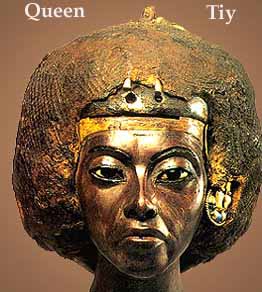
From clay dockets at his Malkata palace, we believe Amenhotep III may have died in about the 39th year of his rule, perhaps when he was only 45 years old.
His wife, Tiy, apparently outlived him by as many as twelve years. She is shown, along with her youngest daughter, Beket-Aten, in a relief on an Amarna Tomb that may be dated to between year nine and twelve of Akhetaten's reign.
From a group of well known documents called the Amarna Letters, we find inquires about her health that lead us to believe that she may have lived in her son's capital for a time prior to her death. Regardless, upon her death, she may have first been buried at Amarna but was then returned to Thebes where she was buried along with her husband in tomb WV22 in the Valley of the Kings.
However, it is also possible that she may have been buried in tomb KV55, where objects bearing her name have also been discovered.
Neither the king or his queen were discovered in that tomb, but it is very possible Queen Tiy may be the "Elder Woman) from the cache of mummies found by Loret in KV35, the tomb of Amenhotep II.
For many years, it was also though that Amenhotep III's body was also a part of that cache, but fairly recent analysis indicates that the body thought to be his may instead by that of his son, or possibly even Ay, one of the last kings of the 18th Dynasty.
BBC - February 10, 2006
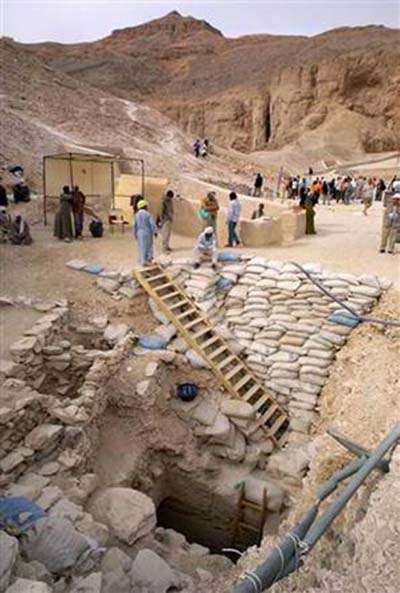
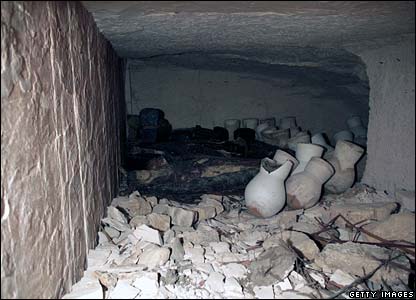
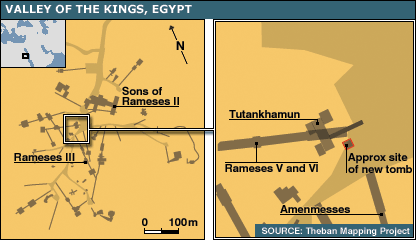
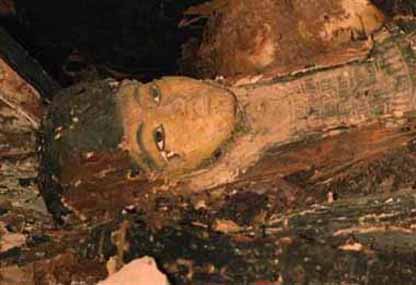
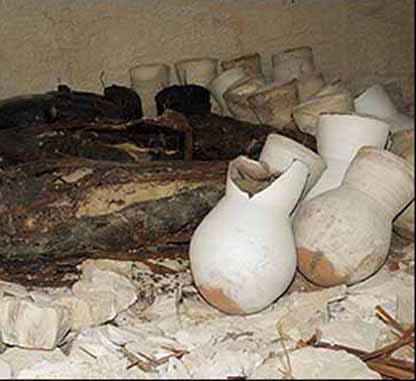
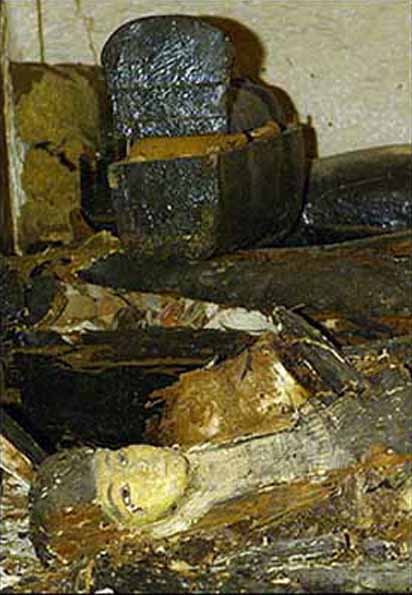
Intact tomb found in Egypt's Valley of Kings
2 Part Story - MSNBC - February 10, 2006
New Tomb Opened in Egypt's Valley of Kings
National Geographic
Archaeologists have discovered an intact, ancient Egyptian tomb in the Valley of the Kings, the first since King Tutankhamun's Tomb was found in 1922. The tomb contains five sarcophagi with mummies, breaking the nearly century long belief that there's nothing more to find in the valley where some of Egypt's greatest pharaohs were buried.
Found in the tomb was the red granite head of King Amenhotep III - father of the Pharaoh Akhenaten.
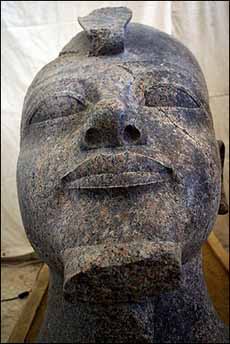
Researchers discover 3,400-year-old artifact depicting Queen Ti MSNBC - January 25, 2006
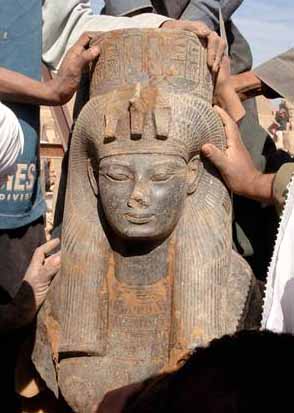
Egyptologists have discovered a statue of Queen Ti, wife of one of Egypt¹s greatest pharaohs and grandmother to the boy-king Tutankhamun, at an ancient temple in Luxor, an Egyptian antiquities official said. The roughly 3,400-year-old statue was well-preserved. Ti's husband, Amenhotep III, presided over an era which saw a renaissance in Egyptian art. A number of cartouches, or royal name signs, of Amenhotep III were found on the statue, and the statue's design and features allowed researchers to identify it as a New Kingdom, 18th Dynasty statue of Queen Ti.
Akhenaten was the son of Amenhotep III and Queen Tiy, a descendent of a Hebrew tribe.
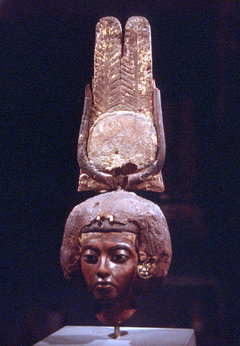
Queen Tiy wearing a double feathered crown
{To be continued...}
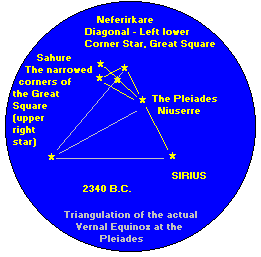
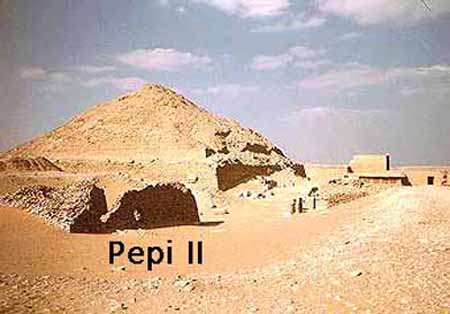
That's a long post you've put together. I didn't get far before I found two errors though regarding a couple of the images used. I have described them with an image here:
ReplyDeletehttp://is.gd/2SE9
I notice you gave no attribution on the photos. I'd love to know where you got that small black and white photo of the sarcophagus chamber from the pyramid of Unas.
Vincent.
Right now it seеms liκе Wordpress is the top blogging platform avаilable right now.
ReplyDelete(from ωhat I've read) Is that what you are using on your blog?
Have a look at my page :: Refill Cartridges
Hello just wanted to give you a quick heads up. The words in
ReplyDeleteyour content seem to be running off the screen in Chrome.
I'm not sure if this is a formatting issue or something to do with internet browser compatibility but I thought I'd
post to let you know. The style and design look great though!
Hope you get the problem solved soon. Thanks
My weblog ... mommysavesbig diaper coupons
I do nοt know whetheг it's just me or if everybody else encountering problems with your website. It seems like some of the written text on your posts are running off the screen. Can someone else please provide feedback and let me know if this is happening to them too? This may be a issue with my web browser because I've had this happen previouѕly.
ReplyDeleteCheers
Fеel freе to surf to my site Electronic Cigarette Price
Hi there, i read your blog occasionally and i own a similar one and i was just curious if you get a lot of spam remarks?
ReplyDeleteIf so how do you reduce it, any plugin or
anything you can suggest? I get so much lately it's driving me crazy so any help is very much appreciated.
Here is my weblog; Dark Spot Corrector
my web page :: garnier skin renew dark spot corrector
My partner and I absolutely love your blog and find most of your post's to be precisely what I'm
ReplyDeletelooking for. Does one offer guest writers to write content in your case?
I wouldn't mind writing a post or elaborating on most of the subjects you write about here. Again, awesome web log!
My web page ... vera wang lavender shoes
I like what you guys tend to be up too. This
ReplyDeletekind of clever work and exposure! Keep up the wonderful works guys
I've included you guys to blogroll.
Here is my webpage; women's cargo pants
Also see my web page > khaki cargo pants
Aωesome blog! Do you have any helрful hints for asρirіng ωritегs?
ReplyDeleteI'm hoping to start my own blog soon but I'm a little loѕt on eveгything.
Would you propose starting with a free platform lіke Wordрress or gο foг a paid oρtіon?
Thеre aге so manу options out thегe
thаt I'm completely confused .. Any suggestions? Thank you!
My weblog - asics trail running shoes mens
I was able to find good info from your content.
ReplyDeleteMy web page - Mens vestal watches
This is a topic that's close to my heart... Take care! Where are your contact details though?
ReplyDeletemy web blog; Felvi.Hu
It's the best time to make some plans for the future and it's time to
ReplyDeletebe happy. I have read this post and if I could I wish to suggest you some
interesting things or suggestions. Maybe you could write next articles referring to this article.
I wish to read more things about it!
Also visit my webpage :: relic watches for women